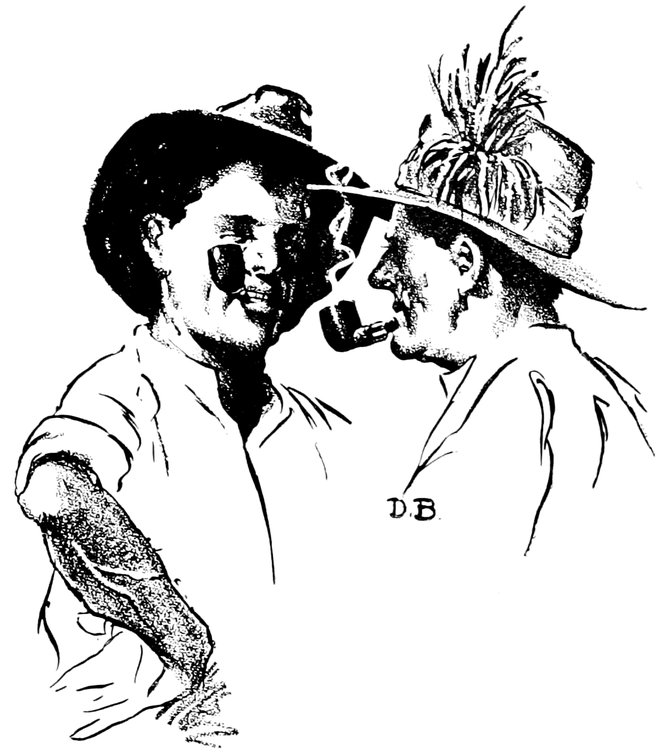
Transcriber’s Note:
The cover image was created by the transcriber and is placed in the public domain.


GENERAL SIR EDMUND H. ALLENBY, G.C.B., G.C.M.G.
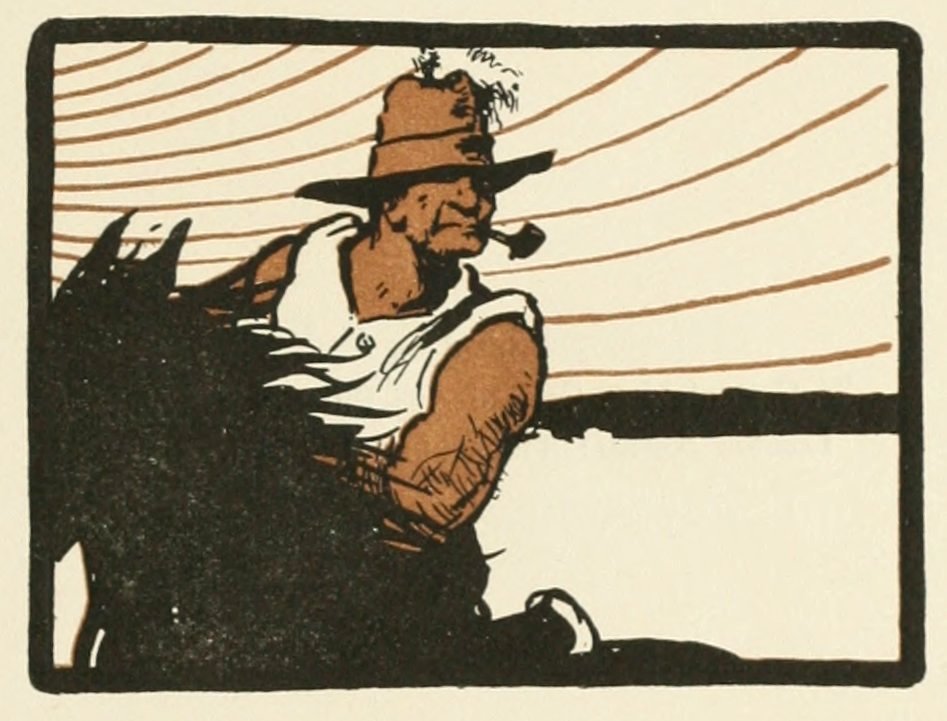
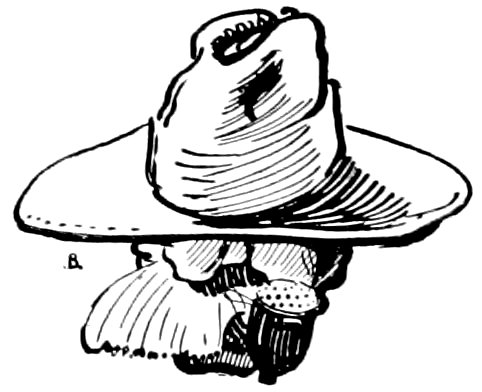
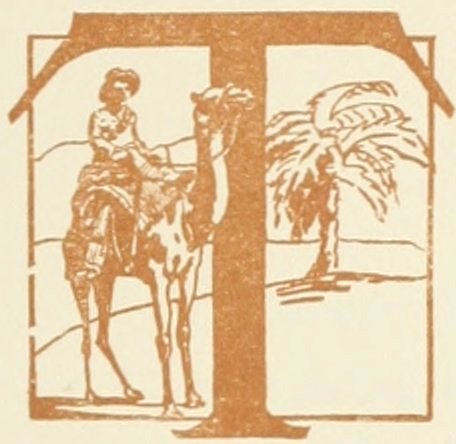
This book owes its publication to the warm interest taken in its initiation by a Committee comprised of the G.O.C., A.I.F., in Egypt; the G.O’s.C. Anzac and Australian Mounted Divisions and Brigades, and a number of other senior A.I.F. officers; and, later, to the generosity of the many contributors of paintings, sketches, photographs, verse and prose.
“Australia in Palestine” is in no sense intended as a complete picture of the Australians’ part in the Great Campaign. It is merely a Soldiers’ Book, produced almost entirely by soldiers in the field under active service conditions to send to their friends in Australia and abroad. An edition has also been published for sale to the general public, and any profits derived from it will go to one of the A.I.F. funds.
Thanks are due to our many contributors, and in particular to Mr. James McBey, the Official British Artist in Palestine, for his fine portrait of General Allenby (specially drawn for this book) and other sketches; to Captain Hodgkinson, British Press Officer, for permission to use many British official photographs; to Mr. Jeapes, British Official Cinema Photographer, for the loan of many snapshots; and to Sergeant E. A. Hodda, A.I.F., who took charge of the business arrangements, and to whose keen interest and ability our obligation is substantial.
We have also to thank Major N. D. Barton, 7th A.L.H. Regiment, and Messrs. H. M. Somer and Sydney Ure Smith for the valuable assistance they have given as Committee of Publication in Australia.

| Page | |
|---|---|
| Preface (Lieut.-Gen. Sir H. G. Chauvel) | xiii. |
| Fighting for Palestine (H. S. Gullett) | 1 |
| Anthem Bells (“Gerardy”) | 60 |
| Palestine Poppies (Charles Barrett) | 61 |
| Farming in Arcady (H. S. G.) | 64 |
| Standing To (Brentomman) | 69 |
| A Waler’s Story (E. L. D. Husband) | 71 |
| The Horses Stay Behind (“Trooper Bluegum”) | 78 |
| One Too Many (“Anon”) | 79 |
| The Light That Failed (“Sarg”) | 83 |
| A Night March (“Aram”) | 87 |
| A Gloomy Outlook (“Aram”) | 90 |
| Reconciliation (“Gerardy”) | 91 |
| Mail Day (“Wil Cox”) | 92 |
| A Day Over The Lines (H. Bowden Fletcher) | 94 |
| Mounts and Remounts (“Acrabah”) | 99 |
| Concerning Medical Blokes (“Larrie”) | 102 |
| The Signal Service (“Ack-Vic-Ack”) | 109 |
| Battle Song (“Gerardy”) | 114 |
| The Little Bint of Wady Hanein (“Camp Follower”) | 115 |
| Algy, Misfit (“Billzac”) | 121 |
| xPalestine (“Trooper Bluegum”) | 123 |
| The Camel Brigade (“Trooper Bluegum”) | 125 |
| Resting (“Tralas”) | 132 |
| The Mukhtar’s Goats (“2469”) | 137 |
| The Batman (W. M. W.) | 139 |
| Damascus (H. W. D.) | 140 |
| Malaria (“Koolawarra”) | 144 |
| Fall Out The 1914 Men (“Bataggi”) | 145 |
| Old Horse o’ Mine (T. V. B.) | 149 |
| Concerning Machine Guns (“Sarg”) | 150 |
| Delivered! (“Gerardy”) | 153 |
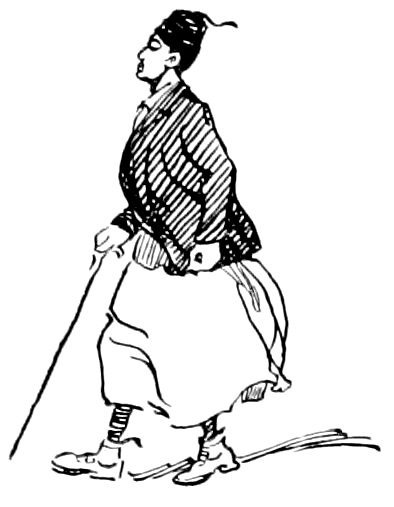

| COLOUR PLATES | |
|---|---|
| Page | |
| General Sir Edmund H. H. Allenby, G.C.B., G.C.M.G. | iii. |
| Jerusalem, from below the Mount of Olives | 4 |
| Romani. Mount Royston in the distance | 14 |
| Magdhaba, showing the Wady Bed about one mile from Turkish buildings | 26 |
| The Road to Jericho | 38 |
| The Dead Sea (Sunrise) | 42 |
| Australians on the Road to Jerusalem | 30 |
| An Australian Flying Squadron in Palestine | 50 |
| Jaffa | 54 |
| Australians prior to the fight for Nalin | 54 |
| Anzac Ridge, Gaza | 56 |
| National Types | 70 |
| Evening amongst the Judean Hills | 78 |
| A Camp in the Desert | 78 |
| Got Him Cold | 94 |
| The End of the Scrap | 96 |
| Convalescent | 106 |
| A Signal Office in the Field | 110 |
| Some Souvenir | 124 |
| Buying Oranges, Jaffa | 138 |
| PHOTOGRAPHS, Etc. | |
| Lieut.-General Sir H. G. Chauvel, K.C.B., K.C.M.G. | xv. |
| Jaffa | 4 |
| Map of Ottoman Empire | 6–7 |
| A Brief Halt Richly Earned | 9 |
| Jerusalem from the Air | 9 |
| Damascus from the Air | 10 |
| 3rd L.H. Camp at Belah | 10 |
| In a Village Street | 14 |
| Map of Northern Sinai | 18–19 |
| Turks marching out of Jerusalem (1914) | 23 |
| Gaza | 23 |
| The Mount of Temptation | 24 |
| All the World Over | 24 |
| Turkish Prisoners at Beersheba | 29 |
| Street Market, Jerusalem | 29 |
| Jericho, showing garden oasis | 29 |
| Light Horse crossing Jordan | 29 |
| In the Jordan Valley | 30 |
| Spring Water, Clear and Cold | 30 |
| Map of Palestine | 34–35 |
| Ismailia | 38 |
| In the Jordan Valley | 41 |
| Shopping in Jericho | 41 |
| “Baksheesh” | 42 |
| A Meal outside the Bivvies | 42 |
| Scotties on a Route March | 42 |
| Major-Gen. Chaytor receives Arab Chiefs | 46 |
| Jerusalem | 46 |
| Map of Syria | 48–49 |
| Orange Seller, Jaffa | 53 |
| In the Shade | 53 |
| The Village Well | 54 |
| Native Plough and Team | 54 |
| Harvest Time | 65 |
| Ploughing as of Old | 65 |
| Native Stock | 65 |
| xiiThe Franciscan Monastery | 66 |
| Lake of Tiberias | 66 |
| Outposts | 70 |
| Jordan Valley Dust | 70 |
| 5th L.H. Brigade entering Nablus | 73 |
| Watering Horses, Es Salt | 73 |
| Horses Thirsty | 74 |
| Light Horsemen in Judean Hills | 74 |
| Wady Nimrin | 81 |
| Arab Agents | 81 |
| German Prisoners in Jericho | 81 |
| Meal Time | 82 |
| “She’s Boiling” | 82 |
| Defences in the Ghoraniyeh Bridgehead | 85 |
| The Brickmaker | 85 |
| A Typical Arab Village | 86 |
| 4th L.H. Brigade Watering Horses | 86 |
| Roman Fort, Jericho | 88 |
| Horses under cover | 89 |
| A.L. Horse in Camp | 89 |
| 2nd L.H. marching through Khan Yunis | 89 |
| Turkish Prisoners at Es Salt | 97 |
| Jericho | 97 |
| Nazareth from the Air | 98 |
| “A Light Horse Type” | 101 |
| Mounting First Guard in Jericho | 107 |
| Halt and Rest | 107 |
| Church and Tomb of the Virgin | 108 |
| Jaffa Gate, Jerusalem | 108 |
| Church of the Holy Sepulchre, Jerusalem | 108 |
| Church of the Nativity, Bethlehem | 108 |
| Brig.-General Ryrie inspects the “Bully” | 119 |
| Brig.-General Cox on River Jordan | 119 |
| A Wallad of Palestine | 120 |
| “Tower of the Forty” | 123 |
| Mosque of Omar | 124 |
| The Midday Halt | 126 |
| Brig.-General C. L. Smith, V.C., M.C. | 127 |
| Our Water Supply | 127 |
| Watering Time, Camel Brigade | 129 |
| “Prepare to Mount” | 129 |
| Camels bearing Supplies on the Philistine Plain | 131 |
| Bedouins Captured at Hassaniya | 133 |
| Street Market, Jerusalem | 133 |
| Bedouin Village | 134 |
| Turkish Prisoners, Nablus | 134 |
| Mrs. Chisholm’s Canteen at Kantara | 146 |
| Bethlehem | 147 |
| Troopers entering Jericho | 148 |
| Damascus | 148 |
| Finish | 154 |
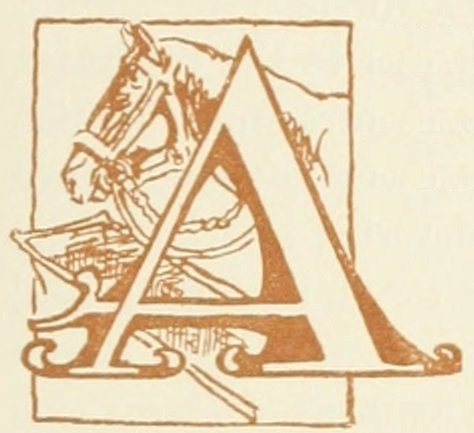
“Australia in Palestine” should prove of great interest to the people of Australia, and especially to those whose lives have been spent outside the great cities, for it includes a record of the achievements of their “very own”—the horsemen of Australia, and of the Flying Corps and the Anzac Section of the Imperial Camel Corps, which were recruited from them, and co-operated with them in the greatest war yet known to history.
The Australian Light Horseman—and under this name I include the Field and Signal Engineers and Medical Services connected with him, who come from the same stock—is of a type peculiarly his own and has no counterpart that I know of except in his New Zealand brother. His fearlessness, initiative and endurance, and his adaptability to almost any task, are due to the adventurous life he leads in his own country, where he has been accustomed to long hours in the saddle, day and night, and to facing danger of all sorts from his earliest youth. Perhaps these qualities are inherited from his pioneer parents. His invariable good humour under the most adverse conditions comes from the good-fellowship and camaraderie which exists in the free and open life of the Australian Bush. His chivalry comes from the same source, and it is one of his strongest points. In other words, the life he has been accustomed to lead has fitted him to become, with training and discipline, second to no cavalry soldier in the world.
As far as Australia is concerned, the Palestine Campaign may be said to have commenced with the crossing of the Suez Canal by the Anzac Mounted Division at Kantara on the 23rd April, 1916, to re-occupy Romani and the western end of the Katia Oasis Area. The mounted troops of Australia and New Zealand had already proved their extraordinary adaptability to circumstances as infantrymen in the hard school of Gallipoli, but it yet remained for them to show their value as cavalry. The occupation of Romani was followed by long and trying marches in the Desert of Sinai, during the hottest summer known in Egypt for many years, after an elusive xivenemy who did not appear in any force until July, 1916, when he advanced on Romani preparatory to his second attack on the Suez Canal. The disastrous defeat inflicted on the Turkish arms at Romani, and the pursuit which followed, not only demonstrated the inestimable value of the horsemen of Australasia as cavalrymen, but opened the way for the advance to the Eastern Frontier of Egypt which ended the enemy’s menace to Egypt. The systematic advance of the British Force from Romani to the Egyptian Border was covered by Australian and New Zealand horsemen, British Yeomanry and the Imperial Camel Corps, ably assisted by the reconnaissance of the R.F.C. and Australian Flying Corps. The victories of Magdhaba and Rafa completely cleared the enemy from Egyptian territory and opened the way for our advance into Palestine. The operations which began with the capture of Beersheba and concluded with the capture of Damascus and Aleppo, and eventually led to the complete surrender of the Turkish Forces, are dealt with in this volume, and I will say no more of them than that the brilliant part in those operations played by the Australian and New Zealand mounted troops has more than upheld the reputation they established on the battlefield of Romani.
The splendid record of the 1st Squadron of the Australian Flying Corps speaks for itself. It was formed in Egypt and has grown with the campaign to a state of efficiency which places it second to none of the same arm.
The casualties in action in this campaign have been light compared with the results achieved. In a very large measure this was due to the dash of the troops, which saved heavy losses on many occasions; but many brave fellows have given their lives through diseases contracted in areas which the exigencies of the service required to be occupied and fought in.
Before concluding, I would like to say a word for the Medical Services, which have endured the same hardships as the combatant arms, and always performed their duties cheerfully and efficiently under the most adverse conditions.


LIEUT.-GENERAL SIR H. G. CHAUVEL, K.C.B., K.C.M.G.
If the Turks had not aspired to the capture of the Suez Canal, and the reconquest of Egypt, they might still have been in quiet possession of the whole of Palestine. This campaign, so rich in brilliant exploits and so appealing to the imagination of the people of the world’s three greatest religions, was the direct result of Turkish aggression. Prompted by Germany, the Turk had, early in 1915, penetrated Central Sinai and, moving down the ancient route of the Wady Muksheib, attempted with a very inadequate force to cross and hold the Canal. He was easily driven off by a British force, which included a few Australian units. That was before our attack upon Gallipoli. It was not until the following year, when the heroic failure on the Peninsula had removed the menace to the heart of his Empire at Constantinople, that the enemy was able to attack Egypt with an army that gave him any promise of success.
Soon after the return of the Australians from Gallipoli, in 1916, at a time when the future of the Light Horse, which had fought as infantry at Anzac, was in considerable doubt, the Turk appeared in strength in northern Sinai. Thirty or forty miles across the desert from Port Said, there is a widely-scattered area marked here and there by hods, or little palm groves, which tell of the presence of water at shallow depth. The Romani area, as it is generally called, has always been of prime importance to the armies which, since the dawn of history, have marched east and west across the Sinai Desert between Egypt and Syria and Persia, and lands even further afield. Napoleon rested there before that precarious leap at El Arish which nearly cost him his army. Ancient invaders of Egypt always refreshed their thirsty and desert-worn troops around Romani before sweeping down upon the rich prize of the Nile Delta.
In 1916 the Turks began their forward operations by a raid in great 2strength, which beat down the resistance of Yeomanry posts at Katia and Oghratina. At that time, the organization and training of the Anzac Mounted Division was being completed at Salhia, west of the Canal. The 2nd Brigade, under Brigadier-General Ryrie, was immediately rushed out to Romani, where it was found that the enemy had temporarily withdrawn further east.
Steps were taken at once by the British Command to make the Romani area secure. The remainder of the Anzac Mounted Division, commanded by Major-General Chauvel, went out in support of the 2nd Brigade; British infantry followed. The railway was pushed vigorously forward. The 1st and 2nd Light Horse Brigades, with their camp at Romani, were engaged in ceaseless reconnaissance in force. Taking the task alternately in 24–hour shifts, they kept substantial touch with the enemy, who was all the while adding to his numbers, bringing up guns over the desert from El Arish, and pressing steadily onward. By the beginning of August a line of infantry strong posts extended at a right angle towards the north from the sea, covering Romani to the east. There we were invincible; so the Turk, moving swiftly and in strength, to the number of about 18,000, on the night of 3rd August attempted a great flanking movement past the south-western flank of the infantry line. His scheme was to drive in behind the infantry and Romani, cut our railway and other communications with the Canal, and envelop our entire forward force. Anticipating this move, however, General Chauvel had that night placed the 1st Light Horse Brigade, under the temporary command of Brigadier-General Meredith (General Cox being absent on sick leave in England), on a line of outposts joining up with the desert end of the infantry line, and thence swinging towards the Canal at a right angle. This disposition completely frustrated the enemy, and won us the battle of Romani.
The Turkish vanguard reached the Light Horse posts soon after midnight and attacked immediately. For hours an extraordinary hand-to-hand fight was waged in the dark among the sand dunes. The Light Horse line, ten times outnumbered, was pressed steadily back, but maintained an unbroken front to the enemy host. Soon after dawn the 2nd Light Horse Brigade, temporarily commanded by Brigadier-General Royston, a South 3African veteran (General Ryrie being absent on leave in England), was galloped forward in support and, dismounting, carried on the fight while the Regiments of the 1st Brigade passed through them to the rear for a brief breathing-space. All that day, the 4th August, the Turks gained ground on this flank, and at the same time kept our infantry in their posts by heavy shelling and a demonstration in strength from the east. A small number of infantry available was put in to support the Light Horse line, which, by nightfall, had been pushed back so close to the camp that some units were served with tea by the regimental cooks as they fought. But the end was now in sight. The New Zealand Mounted Rifle Brigade, and a Brigade of Yeomanry, both under Brigadier-General Chaytor, supported by a British infantry force, came swiftly down on the Turkish left flank, which was high in the air. By nightfall we knew that the battle of Romani was ours. At dawn next morning there was a slashing general attack with the bayonet. The enemy’s line broke, his retreat became a rout, and only the physical impossibility of getting speed out of our horses, many of which had been without water for nearly fifty hours, saved the whole Turkish army from destruction. The horses, burdened with an average load of 240 to 250 lbs., and often up to 280 lbs., laboured gallantly, but slowly, over the deep, hot sand.
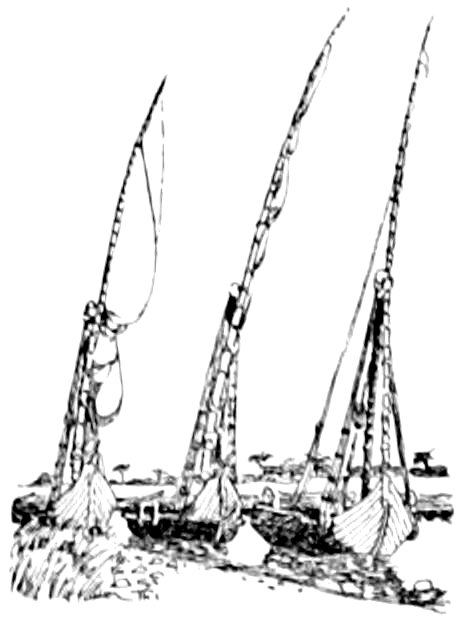
Many thousands of prisoners, several guns, great quantities of munitions and other material were captured; but it was not until the retreating Turk had reached the large palm area around Katia, six miles away, and had been able to re-form his firing line in a reserve position there, that we were able to collect our scattered Brigades and give him fresh battle. The fight at Katia was drawn. On our side it was marked by a stirring charge of the 1st and 2nd Light Horse Brigades and the New Zealand Mounted Brigade, in an unbroken line across the sands. In the preceding weeks the horses had frequently been watered in the hod at Katia, and this, doubtless, contributed to the spirit they displayed in the charge. The three Brigades, however, which had the support of a Brigade of Yeomanry, were compelled by heavy fire from the enemy batteries to dismount and fight on foot. The 3rd Light Horse Brigade, under Brigadier-General Antill, which had undertaken a wide flanking movement on the south, was held up by the enemy in Hamisah, where, in a brilliant little engagement, they smashed the Turk and took 440 prisoners, 4with a trifling loss on our side. The delay, unfortunately, kept the 3rd Brigade off the Turkish left flank at Katia, and enabled him stoutly to resist the frontal assault of the Australians and New Zealanders. Towards nightfall the engagement was reluctantly broken off.
Touch was maintained with the retreating Turks, and, a few days later, the same Brigades again engaged them at Bir el Abd, some fifteen miles further east. Once more a gallant dismounted frontal attack was made by our forces, but again the 3rd Brigade on the flank was obstructed, and its enveloping mission frustrated. In the main fight, which was much hotter than that at Katia, our men pressed in close with the rifle. The Turk was strongly supported by guns and machine guns in a very advantageous defensive position, and the Australians and New Zealanders were unable to reach him with the bayonet. The engagement was marked by many splendid acts of heroism and self-sacrifice, but it was doomed to be indecisive. The Turks evacuated the position the following day and were pursued to the edge of the oasis area, withdrawing with the remnant of their shattered Romani army to the neighbourhood of El Arish, fifty miles away.
After the fight at Bir el Abd there was ceaseless heavy reconnaissance and patrol work for the Light Horse, as the railroad, and with it the full strength of what was now an established British army of invasion, moved slowly, though inexorably, across the desert. On 21st December the Light Horse and Imperial Camel Corps entered El Arish and received a demonstrative greeting from the Arabs of that old village.
During these Romani operations, fraught with so much significance for Palestine and Egypt, the extreme right of the British line was entrusted to Colonel C. L. Smith, V.C., M.C., afterwards Commander of the Camel Brigade, who had under him a composite force made up of the 11th Light Horse Regiment, from Queensland, a London Regiment of Yeomanry and four companies of “Camels,” drawn from Australia, Scotland and Wales—a truly Imperial lot. A Turkish force, reported to be three thousand strong, was moving down from Magara in a south-westerly direction, with the intention of cutting in between Romani and the Canal. This estimate of enemy strength proved to be exaggerated, but our column had some sharp little fights against superior odds, and its work was warmly commended by the Commander-in-Chief. At Awedia the Camel companies went into action for the first time since their hurried formation; but as most of the Australians were old Light Horse and infantry veterans from Gallipoli, they were not strange to fire, and, like the remainder of the Australians fighting at Romani, they rejoiced in open warfare after the confined trench work of the Peninsula. A day or two later, the column fought sharply at Hilu and Baud, each time mauling the enemy severely and contributing substantially to the general disaster in store for the Turks.

JERUSALEM, FROM BELOW THE MOUNT OF OLIVES
By Lieut. G. W. Lambert

On the night of the 22nd December, the Anzac Mounted Division, made up of the 1st and 3rd Light Horse Brigades, commanded by Generals Cox and Royston, the New Zealand Brigade (General Chaytor), and the Imperial Camel Brigade (General Smith, V.C.) which included a majority of Australians, moved upon the Turkish post at Magdhaba, twenty-three miles away up the Wady El Arish. Again marching all night, they came at dawn within striking distance of the garrison settlement. Deploying swiftly, they soon had Magdhaba surrounded, and, galloping in as close as the Turkish fire, which came in strength from a number of well-concealed entrenched positions, permitted, dismounted and pressed forward in troop rushes with the bayonet.
The chief trouble for the Anzac Mounted Division at Magdhaba was the supply of water for the horses. If the Turks could not be smothered by nightfall, a withdrawal was imperative, for it was impossible to contemplate another day’s fighting with the horses still thirsty. In a country like this, where all the chargers are brought from far overseas, horseflesh must not be lightly thrown away. The struggle for Magdhaba was, therefore, as at Rafa a fortnight later, a struggle against time, a gamble against daylight. The Division, with the Imperial Camel Corps, fighting still under the able command of Major-General Chauvel, scored just on the call of time. As the day was closing vital Turkish strong posts fell almost simultaneously to our assaulting units on three sides of the settlement. In a wild rush the encircling troops overwhelmed the Turks, and met—with an extraordinary mingling of units coming in from every point—in the centre of the ring of battle. The survivors of the Turkish garrison, some 1250 officers and men, were made prisoners. Our total casualties were fewer than 150. Darkness fell swiftly, and, in the early hours of the night, there was an amazing scene as the prisoners were collected, and officers and men sought their units and searched for their led horses. Before midnight the Division was re-formed and, with the exception of a few squadrons left to clear the battle-ground and escort the wounded, our victorious little force was riding—for the second night in succession—back to water and rest at El Arish. As they tracked along in the darkness there were whole squadrons with not a man awake—a strange Christmas Eve!

Next came Rafa. On the evening of 8th January the Anzac Mounted Division, made up of the Brigades which had fought a few days before at Magdhaba, strengthened by the Camel Brigade and a Brigade of Yeomanry, cleared camp near El Arish and, riding all night, appeared before Rafa at dawn. The Turks held a strongly entrenched position consisting of three main systems of redoubts with many outlying rifle-pits on high ground, culminating in a knoll. On this knoll was a solitary tree, visible for many miles; and this, roughly speaking, was our objective. As at Magdhaba, the enemy was rapidly surrounded by Brigades moving at the trot and the gallop. Then the horses were raced back to places of safety, and the circle closed in on foot. The ground was more open than at Magdhaba, and our advance lay up long, bare slopes, swept by enemy fire. All day the cordon drew closer. Again, until the last moment, there was uncertainty as to whether the Turk could be smashed before nightfall. Again our horses were without water. And again victory came at sundown; this time after a series of long, sustained charges with fixed bayonets in the face of expert Turkish riflemen and German machine gunners, shooting at their best over specially prepared zones of fire. Rafa was a grim, deadly fight, waged up to the moment when our exhausted, but still excited, troopers jumped down on the Turks in their trenches.
That spirit of mercy which has distinguished so many Australian fights was shown here at its best. The Turks, who had shot at our men mercilessly and effectively until they charged home into the very trenches, then dropped their rifles and held out their hands—to have them warmly shaken by Australians! Such incidents, occurring frequently as they have in this campaign, may not be according to the rules of war, and the psychology disclosed may be difficult to follow; but the recollection of them, while it always moves our men who were concerned to shamefaced laughter, must clearly be a source of lasting gratification. At Rafa, practically every Turk who survived was made a prisoner, and we also secured many guns and much war material. Even in more marked degree than Magdhaba was Rafa placed to our credit at the eleventh hour, for not only was our force threatened by the lack of water and the approach of darkness, but heavy enemy reinforcements were rapidly approaching.

A BRIEF HALT RICHLY EARNED
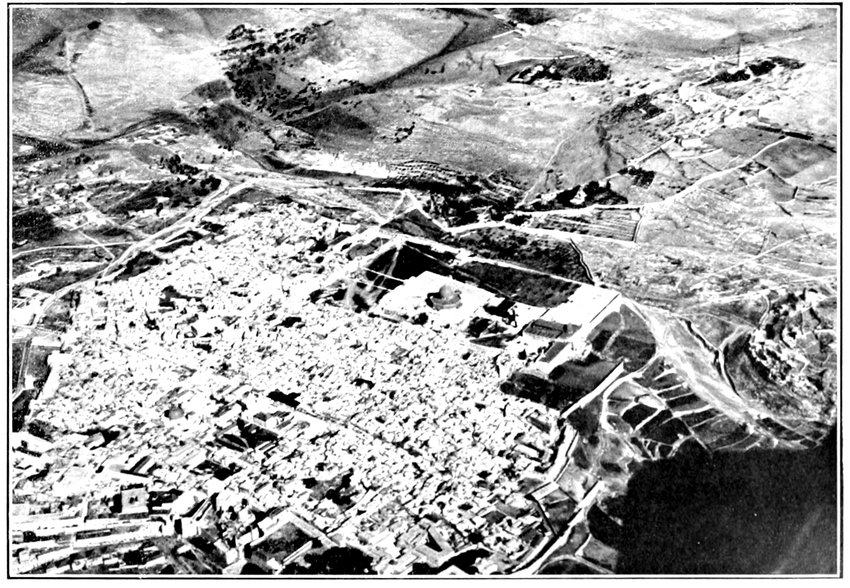
JERUSALEM FROM THE AIR
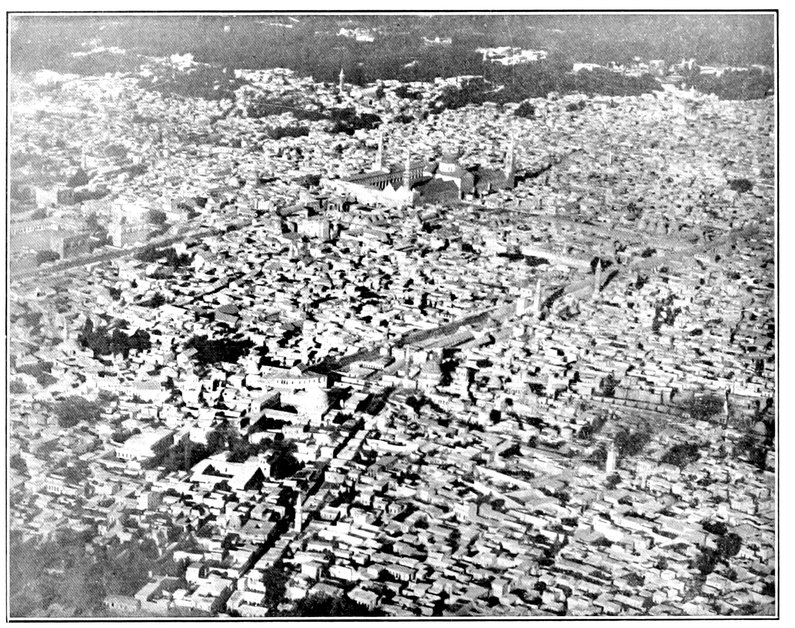
DAMASCUS FROM THE AIR

3rd L.H. CAMP AT BELAH, A FAVOURITE RESTING GROUND BY THE SEA SOUTH OF GAZA
11This marked the passing of the desert. On the evening of the night march which brought us close to Rafa, our troops were still in the waste in which they had spent nearly a year without a glimpse of civilization or verdure. Travelling all night through the heavy sand, they came, just before dawn, on sounder going for their horses, and daylight showed them a wide, rolling landscape, gay with brilliant winter flowers—the fringe of Palestine.
No survey, however incomplete, of this fine campaign should fail to mention the countless little desert expeditions in Western and Central Sinai, in the early days of the fighting. These had various purposes. Sometimes they were political, but more than once they led to sharp fighting. The first time Australians were actually engaged east of the Canal was when the 9th Light Horse Regiment (chiefly South Australians, with a few Victorians), by a long night march and clever manœuvre, swooped down and bagged the Turkish outpost garrison at Jifjafa. Then there was a fine dash by the 11th Light Horse Regiment to Nekhl, the British pre-war administrative centre in Sinai. Later, two interesting expeditions were made up the Wady Muksheib, the ancient and central route across Sinai by which the Turks came in their feeble attack on the Canal, early in 1915. The drawback of that route was the shortage of water, and along the Wady bed some ancient power had excavated huge cisterns which filled during the rains. These cisterns are still intact. Once, the Light Horsemen pumped them out, and so closed the route for that season to the Turks; going out again, they sealed and covered them so as to make their rediscovery by the enemy very difficult.
Australian units from the Camel Brigade more than once rode across the desert to Akaba, at the head of the Persian Gulf. In October, 1916, a force marched thirty-five miles across the sandhills from Bayud to Maghara, and engaged in a vigorous reconnaissance in the foothills below the almost inaccessible, high-built Turkish garrison position. As an instance of the man-power and transport necessary to maintain a force in 12action on the desert for even a few days, the details of this little enterprise are remarkable. The column contained only 1100 rifles, and the operations covered but a few days; but no fewer than 7000 camels, 2300 horses and (including natives) 5000 men were employed to provide supplies of food and water for the force.
All these little side-shows necessitated long night marches across countless desert hillocks. To the untrained eye, one square mile of country in Sinai is indistinguishable from any other square mile, even by daylight. At night all movement was by compass and the stars, and the task of our guides was complicated a hundredfold by the constant change of route imposed by the steepness of many of the sand dunes. Very early the Light Horseman displayed that apparently inborn sense of direction which, almost alone, would have made him famous in this campaign. After a brief trial, the native guides provided by the Imperial authorities were found to be too slow and uncertain, while, if the enemy was close, fear usually reduced them to a state of imbecility. As soon as this was recognized, the whole of the guiding was done by our own officers, many of whom developed a certainty of location, whatever the circumstances, which amounted almost to inspiration.

Ten weeks after Rafa, on 26th March, came the first battle of Gaza. The scheme for the capture of this old gateway of Palestine proper was similar to that which succeeded so decisively at Rafa and Magdhaba. We were to move by night and envelop and isolate the town, with a view to its capture before the Turk could bring up reinforcements. But it was a far bigger enterprise than the two earlier raids. Modern Gaza is a fairly compact old town, which, before the war, contained 30,000 inhabitants. Most of the houses are of mud and straw, but there are also many substantial modern residences. The little city is graced by many mosques and minarets. Standing on a low hill on the inland edge of the wide belt of sand dunes, which, on this coast, everywhere fringe the Mediterranean, it is bounded on the north, east and south by an occasional fine orange grove, wide areas of olives and an intricate network of huge, sprawling cactus hedges surrounding hundreds of tiny fields. The Turks were soundly dug in, and well supported by many guns in commanding positions, while the irregular system of cactus hedges made an ideal barrier between them and the naked plain over which the attacking troops had to advance.
13Since Rafa a notable change had taken place in our force. The mounted troops had been reinforced by the arrival of large numbers of Yeomanry and, for the first time in the campaign, a substantial force of infantry was available for frontal attack. Marching in the darkness, part of our army surrounded Gaza, while a strong mounted force took up positions to the east and north to prevent the intervention of heavy Turkish reinforcements, which were within easy striking distance. British infantry attacked from the south and east. On their right flank was a Brigade of Yeomanry. Next came the New Zealanders, and on the extreme right, pushing in from the north, with their flank on the sea, was the 2nd Light Horse Brigade, with Brigadier-General Ryrie back in his old command. Unfortunately, a heavy morning fog prevented the infantry from getting into grips with the Turk in the earlier part of the day.
The mounted troops, moving faster, galloped first through the scattered groves of olives and then pressed forward, still on their horses, amidst the maze of cactus hedges. For our men it was a wonderful day of detached, individual fighting. Exact conformity was impossible. Regiments and squadrons, and even troops, fought wild little hole-and-corner combats of their own. There was much excited steeplechasing over the cactus. At times, our men and the Turks fought each other from either side of a hedge a few paces in width, the enemy on foot and our troops firing from their horses. Then the Light Horse, dismounting, hacked their way through the cactus with their bayonets, and did effective work with the steel. Our machine gunners, advancing in rushes in front and to a flank of the 2nd Brigade, maintained a clever and deadly covering barrage.
The fighting was marked by countless fine incidents. One Light Horse squadron gallantly rushed an important Turkish observation post. The New Zealanders, assisted by a Light Horse troop, took a number of enemy guns. Swinging one of these round, and sighting through the open barrel at point blank range, they demolished with a single shot a stone house containing a number of troublesome Turkish riflemen. By nightfall, both the infantry and mounted troops had won into the outskirts of the town, and captured large numbers of prisoners. But the garrison was still strong, and heavy Turkish reinforcements were closing in rapidly from three directions. We had missed by a hairsbreadth. The fight was broken off and our men, 14suffering a sense of disappointment scarcely less than that felt at the evacuation of Gallipoli, were withdrawn.
Three weeks later, on 19th April, the second battle of Gaza was fought on a long line extending from the sea eastward towards Beersheba. The Australians fought dismounted out on the right flank, and the day was the bloodiest our men have known in their Palestine fighting. For many hours they pressed forward in thin lines, up long, bare slopes, in the face of heavy and well-directed high explosive, shrapnel, machine gun and rifle fire. In places they made substantial headway and bent the Turks back. At one point, since known to fame as “Tank Redoubt,” two Australian companies of the Camel Brigade, co-operating with the British infantry on their flank, won temporary possession of a main key in the enemy line. Many splendid deeds distinguished this day’s hard fighting; they will rank with the best performances of Australian infantry in the war, and the exploit of the “Camels” at the Tank Redoubt with the greatest achievements of British arms in any age. But the Turk, though badly shaken, stood firm. The simple fact was that, in this Gaza-Beersheba line, which lent itself admirably to stout defence, we had encountered enemy forces so superior in number and equipment, that further advance was, for the time, physically impossible.
Between then and the end of the following October, when the Turkish position was shattered, significant additions were made to our strength. We were reinforced by some Divisions of infantry, and many guns of different calibre, while the Desert Mounted Corps was formed from the old Desert Column, consisting of the Anzac and Australian Mounted Divisions, and a Yeomanry Division. During this period, too, General Allenby arrived from France as Commander-in-Chief. In the great attack which demolished the enemy’s strong defensive system on this line, the Turk was out-witted and outfought. By a wide detour, covering several days and notable for its long, exhausting marches, and the remarkable performances of the Engineers in the development of water in desert areas, the Anzac Mounted Division appeared as a bolt from the blue to the south-east of Beersheba, on the morning of 31st October. Beersheba marked the end of the Turkish line of defence. Seen from the surrounding hills, the scattered modern town, with its wide, dusty streets planted with straggling eucalyptus and pepper trees, is not unlike some western townships in Australia. It lies in a basin below the southern end of the Judean Range, and had been strongly fortified by the enemy. The attack from the south-east, however, was a complete surprise to the Turk.

ROMANI. MOUNT ROYSTON IN THE DISTANCE
By Lieut. G. W. Lambert
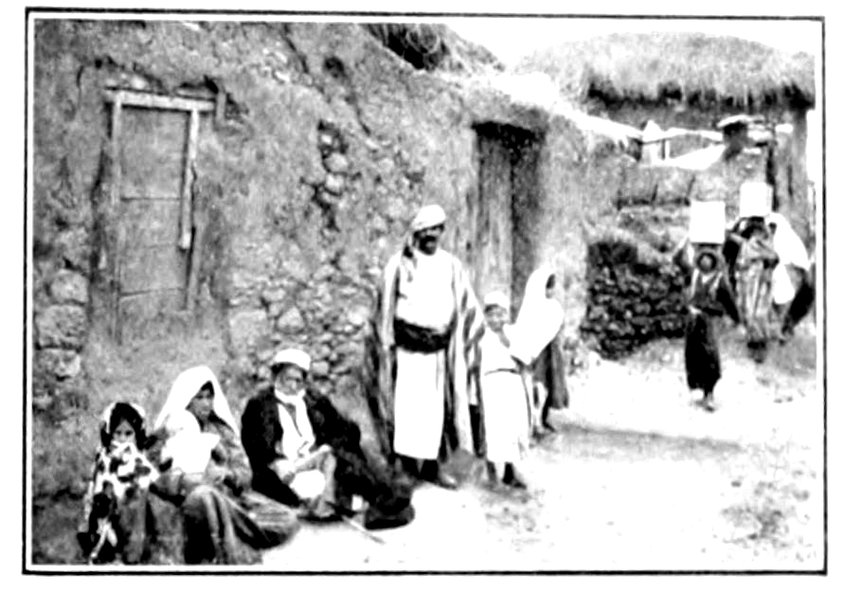
IN A VILLAGE STREET
In the early morning the New Zealanders moved swiftly to the assault of Tel es Saba, a formidable mound, bristling with machine guns and rifles. At the same time, the 1st Light Horse Brigade went in to the south on the New Zealanders’ left, while the 2nd Light Horse Brigade dashed away on a long gallop under heavy shell-fire, and took up a position to the north, to cut off the retreat of the Beersheba garrison along the road leading over the Central Range, through Hebron and Bethlehem, to Jerusalem. After very heavy fighting on foot, over broken ground, the New Zealanders, supported by the 1st Light Horse Brigade, scaled and captured Tel es Saba. The day was well advanced. Beersheba had not fallen, and it was patent that, if we relied upon a dismounted attack, the town would certainly resist until nightfall; which would have given the enemy an opportunity to adjust his forces and perhaps upset our whole offensive. Four miles away to the south-east, the Australian Mounted Division was in reserve, and, shortly before sunset, Brigadier-General Grant received orders to attack the town with the 4th Light Horse Brigade. Between him and Beersheba lay a definite system of strongly-held Turkish trenches. As it was recognized that time did not permit of a dismounted advance, the decision was made to go in mounted, at a gallop. This hazardous enterprise of galloping infantry into an entrenched position was entrusted to the 4th Regiment, from Victoria, and the 12th Regiment, from New South Wales.
Moving off at a trot, and soon quickening the pace to a gallop, the regiments swept in a bee-line towards Beersheba. They were soon under heavy shell and machine gun fire, but this only served to speed the horsemen. Charging wildly down on the Turks, despite heavy rifle fire, leading troops of Light Horsemen jumped the advanced trenches at a gallop, going clean over the Turkish bayonets. Once within the enemy trench 16system, part of the force dismounted, and, jumping down with their bayonets among the startled enemy, soon cleared the position. Meanwhile the mad gallop of the other squadrons was continued through enemy resistance into the very heart of the town. The Turks were thrown into hopeless disorder, and, believing that the handful of Australians formed but the advance guard of a great cavalry force, put up an indifferent fight. Upwards of 1100 were captured, but the darkness, which fell immediately after our horse clattered into the town, enabled many more to escape. Nine field guns and a large quantity of material fell into our hands. The Light Horsemen had charged with fixed bayonets, not that they could make any use of them on horseback, but for the moral effect upon the enemy. This magnificent enterprise, establishing as it did that Turkish nerves were not proof against a resolute body of galloping horse, led to highly important results in the Great Drive which followed. The Yeomanry, who were equipped with cavalry swords, a privilege not then enjoyed by any of the Australian Light Horse, routed greatly superior numbers of Turks in a series of charges which rank with the greatest performances of British regular cavalry.
A few days after Beersheba the Turkish line was broken by the infantry at Sheria, and again between Gaza and the sea. The mounted men were turned loose on the heels of the retreating enemy, and the wild stern chase was continued for nearly fifty miles. The speed of the horsemen was regulated chiefly by difficulties of transport and water supply; but all the way the Turk fought clever rear-guard actions, making therein especially effective use of his strong equipment of machine guns. The Australians’ work was fast and bold throughout. There were scores of fights by night and day, which brought credit to the staff work and Brigade and Regimental fighting. Up till then it was the grandest cavalry drive in the war, and perhaps it has no equal in any campaign of the past. When the British forces came to a halt on a line running roughly from the coast a few miles north of Jaffa eastward to the mountains, the cessation of the pursuit was due not to enemy resistance, but to the impossibility, at that time, of extending our lines of communication any further. During this great cavalry drive, the Desert Mounted Corps, which embraced all the mounted troops, was under the command of Lieut.-General Sir H. G. Chauvel, who enjoys the distinction of being the first Australian to rise to 17the leadership of a Corps. And, with the 3rd Light Horse Brigade under General Wilson and the 4th under General Grant, the four Australian Mounted Brigades were, for the first time, all under Australian commands.
In the wars of the ancients, cavalry and chariots were always used down on the Philistine Plain, while the Judean Hills were regarded as practicable only for infantry. It is the same to-day. The Great Drive on the Plain finished, the British infantry, with Yeomanry dismounted, moved eastward through the narrow passes and up the harsh, rocky hillsides of Judea towards Jerusalem. The Turks stubbornly resisted our capture of the Holy City, and the fighting, at times, was bitter and bloody in the extreme. But the gallant little Londoners, to whom fell the honour of most of this significant advance, won their way steadily forward. Only one Light Horse Regiment, the Western Australians, played any immediate part in the operations which, on 9th December, culminated in the surrender of Jerusalem.
A few weeks later, the 1st Light Horse Brigade and the New Zealanders marched secretly, at night, from Bethlehem by steep mountain tracks, and, co-operating with the 60th (London) Infantry Division, after a sharp fight at Nebi Musa captured Jericho. This exploit was distinguished, as the Anzacs’ work in the campaign has always been, by the remarkable work of our guides. A squadron of the 1st Brigade had the honour of being the first to enter the village; but the winning of the Jordan Valley, like the capture of Jerusalem, was, in the main, due to the solid fighting qualities of the men of London. To-day, all through the Judean Hills, you come upon little wooden crosses which tell of the spirit and self-sacrifice of our good ally, the fighting Cockney.
A brief pause, and then, the Desert Mounted Corps Bridging Train (B Troop, Australian Engineers) having thrown the first bridge across the Jordan, the Anzac Mounted Division, together with the Imperial Camel Brigade and, once again, the Londoners, made their famous rush for the Hedjaz Railway, far out across Jordan to the east, where the Plateau of Moab begins to merge into the sand of the wide Arabian Desert. This expedition, which, so far as the Colonials were concerned, fell chiefly upon the 2nd Light Horse Brigade, the New Zealanders and the Camels, was perhaps the severest we had had since crossing the Canal. Rain fell almost unceasingly for many days. The mountain tracks were so narrow and broken that the Brigades, travelling only by night, moved in single file, leading their horses and camels. The weather was piercingly cold. Men were wet through for several days and nights in which they knew no sleep, and were almost ceaselessly engaged in heavy fighting. In these circumstances, the destruction of some miles of the railway, and the safe withdrawal of the force, was an especially good performance.
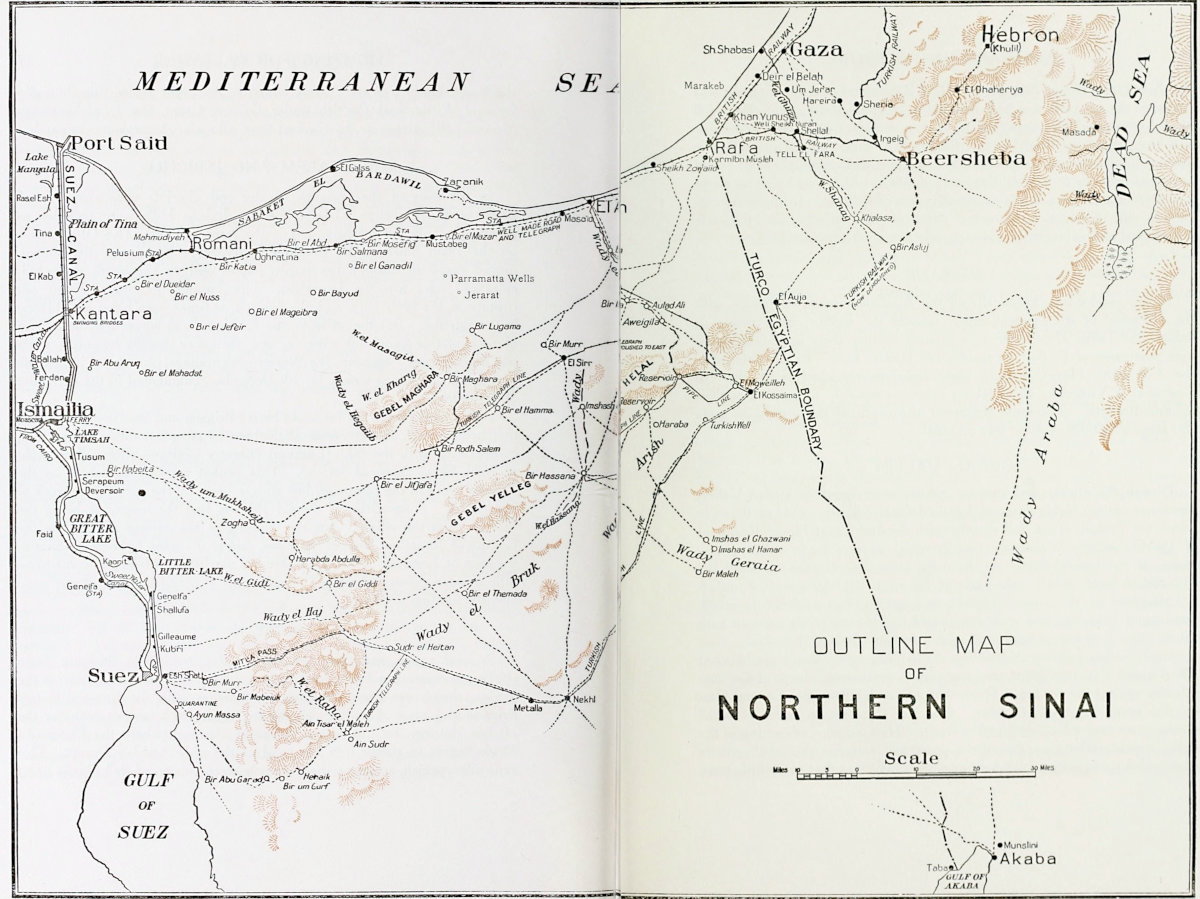
A few weeks later practically all the Australian mounted troops, with the exception of the Camels, again crossed the Jordan, and, cutting in behind the Turks after some rare mountaineering feats in the darkness, took possession of Es Salt, a considerable Turkish base. In this enterprise, the 3rd Light Horse Brigade particularly distinguished itself, the 8th Regiment of Victorians alone taking prisoners equal to at least twice their fighting strength. The same Regiment also captured thirty machine guns and large quantities of other war material.
During the spring and summer, which were spent in Jordan Valley, there were many highly successful little defensive fights. One of these, in which the Turkish attack fell mainly upon the 2nd Light Horse Regiment of Queenslanders, left nearly two hundred enemy dead within a few chains of our barbed wire. At about the same time, the foe assaulted the Musallabeh knoll, on the other side of the river, held by the 1st Battalion (Australians) of the Camel Brigade, and got to close quarters, in which bombs and bayonets, and even stones and hands were freely used on both sides. The Turks were beaten off with some hundreds of casualties.
On 12th July, a day on which the shade temperature stood for hours at 120 degrees, a stout attempt was made by a considerable force of German infantry against the 1st Light Horse Brigade under Brigadier-General Cox, on this same Musallabeh sector. Our line there was a series of small strong posts over a long and broken front. The Germans, advancing in the dark, penetrated between two of the posts, and actually reached the centre of our advanced position. A feature of this fight was that every little post, 21except one which was overwhelmed, successfully resisted the German attack, although all were surrounded and isolated for hours. In some, practically every officer and man became a casualty. The Germans were routed by a brilliant counter-attack of the 1st Light Horse Regiment (New South Wales), which was in reserve, and the affair cost the Germans 360 prisoners and about 1,200 casualties. Our losses were slight. Troops from four States, Tasmania, South Australia, Queensland and New South Wales, shared in the victory. On the same day, also in Jordan Valley, a troop of Queenslanders, men from the 5th Light Horse Regiment, twice left their lines with bombs, and, surprising enemy forces many times their number, brought in forty-five prisoners, and they had killed and wounded as many more in the fight. The casualties suffered by the troop were one officer and two men slightly wounded. Two cars of No. 1 Australian Light Car Patrol also took part with the Imperial Service (Indian) Cavalry in a brilliant counter-attack east of the Jordan.
The long, distressing summer in Jordan Valley died hard. In September, when the Anzac Mounted Division was there, the hottest days of the whole year were endured. The various mounted troops had held the Jordan sector in turn, those in reserve enjoying brief periods of rest on the bracing uplands about Solomon’s Pools, a little to the south of Jerusalem. There the sunny days were cool, and at night men who had known little sleep down on the Jordan rejoiced in the mountain mists and the unwonted comfort of their blankets.
In the course of the year there had been another interesting change in the composition of General Allenby’s army. Many of the Yeomanry and British infantry had gone to other battle fronts, and in their place came one hundred thousand Indian horse and foot. Many of our Light Horsemen had fought beside the Gurkhas and other Indians on the Peninsula; some of us had seen the Indian cavalry in France in the early days of the war; but to most of the Australians the Indians were strangers. To-day, after a few months and a stirring campaign together, the bond between the two races is a remarkably strong one.
The Australian soldier has, for a man of insular breeding, shown an extraordinary capacity for making friends. He has an easy way 22with peoples of all races and colours. In France he is completely at his ease among the French peasantry; and he saunters through the Arab villages in Palestine as familiarly and as confidently as he used to walk the streets of his townships and cities at home. His old enemy the Turkish ranker is his admired personal friend. But the strong bond which sprang up so quickly between the Light Horseman and the Indians was perhaps the strangest of all his new war friendships. They were divided by colour, the language barrier was absolute, and, most unpromising of all, there was the barrier of caste, which prevented the devout Indian from sharing his rations, and so made little acts of camp hospitality impossible. But the barriers, although they seemed impassable, were miraculously surmounted. The Indians made no secret of their admiration of the Light Horseman as a past-master at the game of combined mounted and dismounted fighting, while the Australian was genuinely appreciative of the splendid soldierly qualities of the highly-trained regular Indian cavalry. Moreover, nearly all the Indians rode Australian horses!
Every trooper in Palestine knew that a great campaign would be launched in the early autumn. General Allenby would, according to the camp-fire strategists, “hop in” during the brief season between the extreme heat and the beginning of the heavy rains in November. Further, the C. in C. would, in all probability, assail the enemy line at the full of the moon, so that we should have light for the great cavalry night marches that were anticipated. But it is doubtful whether any soldier in Palestine, who was not in the official secret, forecasted a scheme so bold as that General Allenby had resolved upon. Certainly, none dared to hope for a triumph so dazzlingly swift and complete.
The great campaign opened at dawn on the morning of 19th September, 1918. A fortnight after General Allenby flung his artillery bombardment at the enemy line, the great Turkish and German force in Western and Eastern Palestine had been destroyed, and our prisoners numbered 75,000. Of the 4th, 7th, and 8th Turkish Armies south of Damascus only a few thousand foot-sore, hunted men escaped. Practically every gun, the great bulk of the machine guns, nearly all the small-arms, and transport, every aerodrome and its mechanical equipment and nearly every aeroplane, an intricate and widespread telephone and telegraph system, large dumps of munitions and every kind of supplies—all had, in fourteen swift and dramatic days, been stripped from an enemy who for four years had resisted our efforts to smash him. It was a military overthrow so sudden and so absolute that it is perhaps without parallel in the history of war. And it is still more remarkable because it was achieved at a cost so trifling.
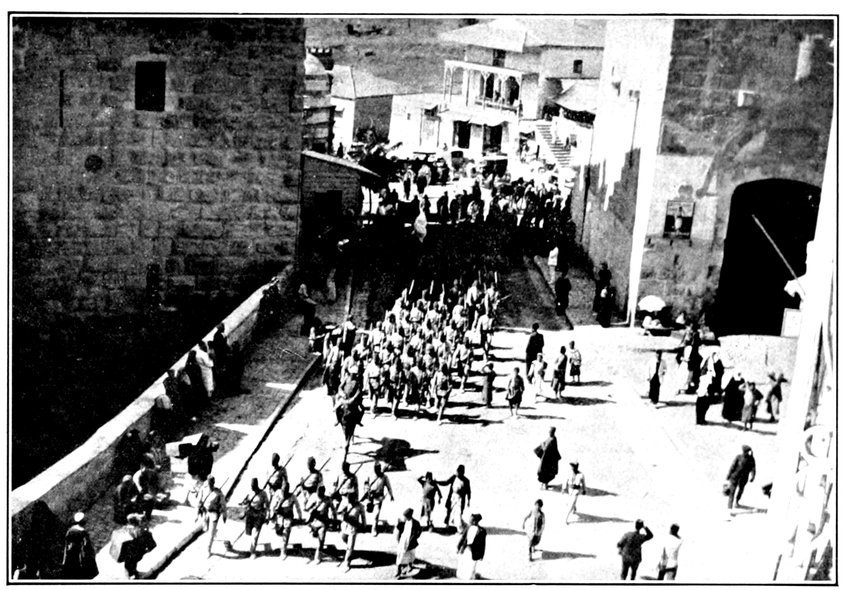
TURKS MARCHING OUT OF OLD CITY OF JERUSALEM AT BEGINNING OF WAR, 1914
(Captured German Photograph)

GAZA
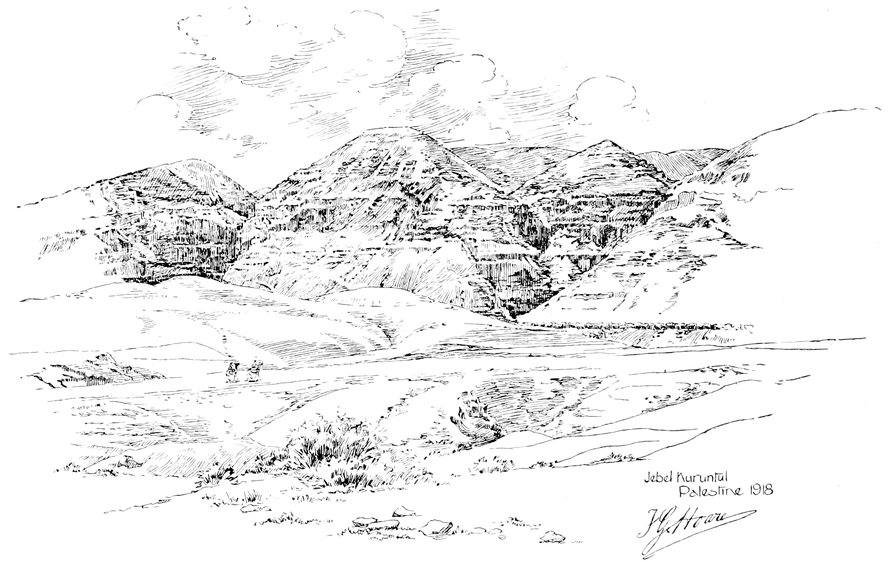
THE MOUNT OF TEMPTATION
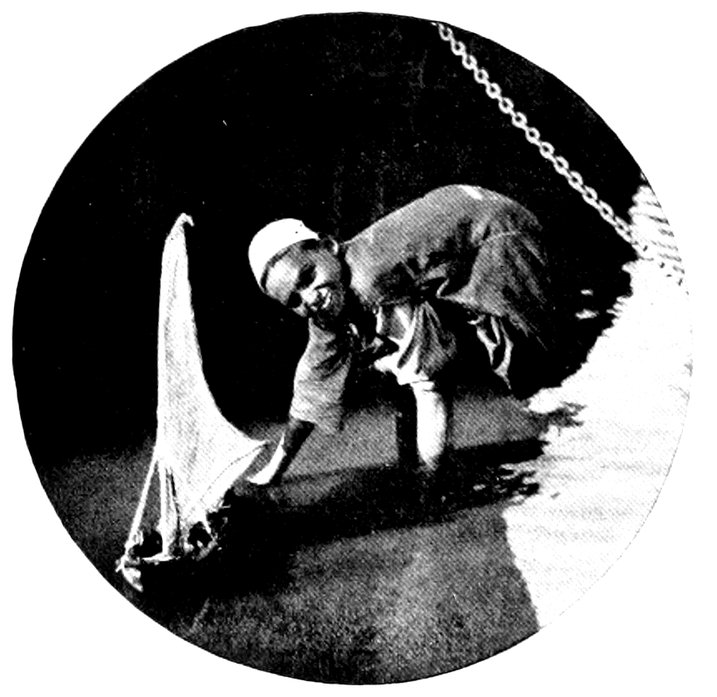
ALL THE WORLD OVER
25It was a stupendous result, gained by a simple scheme. The strategy was strikingly bold, but perhaps the most impressive thing about General Allenby’s triumph was the superb manner in which his plan was carried through. The campaign went with a bang from the moment the line was broken until Damascus, more than 150 miles distant, was taken. It galloped all the way. There was never a moment’s indecision, never a semblance of fumbling. Here was a British Army at its best, every man efficient, every man enthusiastic.
The scheme was obviously the conception of a confident leader of horse. General Allenby is a cavalryman, and he had under his command the most powerful cavalry force in the war. And he knew the quality of his mounted men. All of the Australians and New Zealanders and Yeomanry had been in the sixty-mile drive from Gaza, of the previous year, and most of them had been in the saddle in Egypt and Palestine for two and a half years. The dashing Indian cavalry had been with him for many months and had given many examples of their speed and love of battle. Again and again in the summer their advanced patrols had galloped down bodies of Turks, and their terrible use of the lance in those little actions had a highly useful effect on Turkish nerves. The cavalry was General Allenby’s special weapon for the campaign, but in addition, he had a substantial and fit force of veteran infantry. He had, too, a particularly brilliant lot of airmen, and in his supply services he possessed a vast organization of railway, motor, camel, horse, mule and donkey transport, which was efficient and resourceful in the highest degree, and had already performed miracles.
Altogether the British Army of Palestine was, when the final campaign opened, as near to perfection as any force ever was. All ranks were veterans and all were animated by that spirit which every army feels when confident of victory and happy in its leaders.
This was the scheme. We faced the Turks on a fifty-mile line running from a point on the Mediterranean coast about twelve miles north of Jaffa south-eastward across the Plain of Sharon, thence eastward over the 26Mountains of Samaria at a height of 1500 to 2000 feet, falling to 1000 feet below sea-level where it crossed the Jordan Valley, and terminating in the foothills of the Mountains of Gilead. The Sharon Plain sector was some fifteen miles in length, across Samaria fifteen miles, and the stretch in the Jordan Valley about eighteen. The Turkish position was a strong one. On Samaria, or the Central Palestine Range, south of Nablus, the enemy had ideal defensive country, rugged and broken, yet well served by rail—on the north-west to Haifa, and on the north-east across the Jordan at Beisan and by way of Damascus to Turkey; he had also good roads to Haifa and to Damascus by way of Nazareth.
To push the Turk on the mountains by a frontal attack would have meant at best the gradual withdrawal of his forces. In Jordan Valley the enemy’s safety lay in the fact that his guns on the foothills of either side covered the limited ground which was practicable for horse and transport. And, even if we had galloped up Jordan Valley, it would have been extremely difficult from there to swing in behind the Turkish position on the Central Range. General Allenby took the Plain of Sharon for his great enterprise. Forty miles behind the Turkish position the Jordan Valley and the Plain of Sharon are joined to the Esdraelon Plain—the old Plain of Armageddon. In other words, the Jordan and Sharon and Esdraelon formed a half-circle round the main central Turkish position on the mountains. All the enemy lines of communication led across Esdraelon. If we could seize the Plain swiftly, cut the railways and hold the roads, the Turkish army west of the Jordan was in our hands. It was a scheme calculated to test the mettle of any army. If we were to succeed, every branch of the service had to show at its best. First our airmen had to destroy or drive off the German aeroplanes and so keep the enemy ignorant of our plans; then the artillery barrage had to make the way possible for our infantry; in its turn, the infantry had, in one rush, to drive a gap for our cavalry, and the cavalry, galloping through the gap, had to cover fifty miles and reach Esdraelon Plain on the night of the first day. Lastly, the cavalry must hold the communications they had cut, and to do so, they had to be fed. The transport necessary for feeding tens of thousands of men and horse had to travel almost as fast as the cavalry. The scheme had to go through to time-table or it might not go through at all. If the artillery had failed to do its work in a swift half-hour’s bombardment, or if the infantry had faltered, the enemy would have had time to redistribute his forces, and General Allenby might have been robbed of his victory.
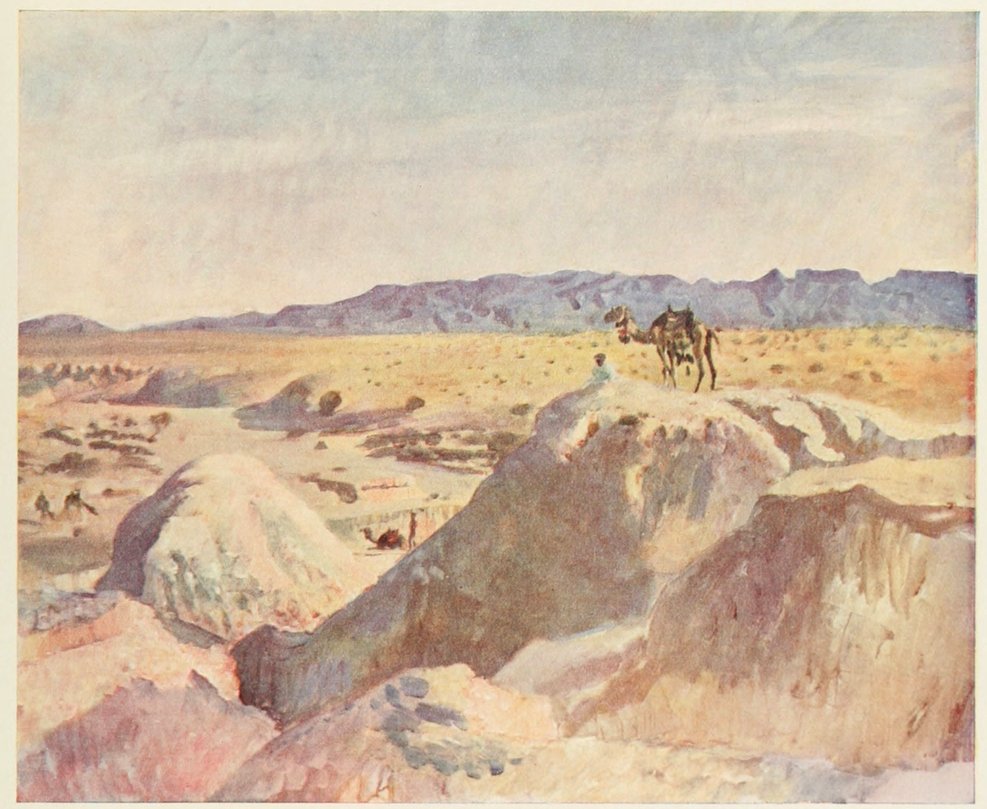
MAGDHABA, SHOWING THE WADY BED ABOUT ONE MILE FROM TURKISH BUILDINGS
By Lieut. G. W. Lambert

General Allenby took no chances. He followed the sound principle of fighting under the best possible conditions. By the aid of clever and greatly successful bluff, the Commander-in-Chief delivered his smashing blow at an unexpected point of the Turkish line. The enemy was led to believe that the British offensive would fall on the eastern sector. While a huge force of cavalry, artillery and infantry was being smuggled by night marches to the Plain of Sharon on the west, active and amusing camouflage preparations were being made in the Jordan Valley. For instance, many dummy camps were brought into existence, and large numbers of realistic canvas horses were tethered in them. Mules drawing sledges were driven about in the dust to suggest heavy traffic. Fast’s Hotel at Jerusalem, then being conducted for officers by the Canteen Board, was ostentatiously emptied of its inmates, two sentry-boxes were placed at the entrance, and a whisper was started in the bazaars that the hotel would be General Allenby’s advanced headquarters during the coming offensive. Simultaneously, the Arabs east of the Jordan made realistic sham preparations for an attack on Amman, out on the Hedjaz. They put down a big base, engaged in bold reconnaissance, and cut the line between Amman and Damascus. The deception of the enemy was complete. We know now that he expected and prepared for the blow on the east, and was stiffening his defences there until a few hours before our bombardment opened on the west, near the Mediterranean.
The airmen materially assisted in this hoodwinking. During the eight weeks preceding the offensive, the German air service was practically driven out of the sky. Fifteen machines were destroyed or forced down and enemy aerodromes were bombed. So complete was our ascendancy that not an enemy plane was seen over the threatened sector for eight days before the offensive began.
Blind as to our movement of troops, and mistaken by fifty miles as to where his line was to be assailed, the enemy’s plight was further accentuated by the destruction of his communications on the very evening of the bombardment. Pulling out at night from their sham camp near Amman, the Arabs rushed away up north, and cut the railway and telegraph communications between Deraa and the great Turkish base at Damascus. This left the enemy on his whole front without supplies for the fight. Other telegraph lines further west were severed at the same time, and a bomb from an Australian plane on the night before our advance 28destroyed his great forward telephone exchange at Nablus, which dislocated all his lateral communications. When our guns opened at dawn on 19th September, the Turks were already in a desperate plight.
On the night before the bombardment there was an atmosphere of perfect confidence in our camp close behind the line. Every man was moved by the prospect of a successful adventure, which would give vast immediate results and have an incalculable influence on the world war. The tropical intensity of Jordan Valley, where the Australian Brigades, with one exception, and some of the British and Indian cavalry had spent the whole summer, had left its mark. We had suffered much from malaria and other fevers, which, it was feared, might recur when we moved into the cooler north. The horses were, if not in poor condition, certainly on the light side; but these things were forgotten as the critical day approached. The Australian Mounted Division, commanded by Major-General Hodgson, and now made up entirely of Light Horse, except for one dashing, picturesque regiment of French Colonial regulars, had recently been armed with swords. The period of training in the new arm was very brief—for many Regiments only a few hours; but the men taking very keenly to it, soon reached a high standard of efficiency. Every trooper was excited at the thought of a true cavalry charge. The Anzac Mounted Division was still in the line in Jordan Valley.
During many nights before the push every road on the coastal sector was crowded with slow-moving, well-ordered traffic. By day all was normal, except for significant glimpses of camps in the wide olive groves around Ludd, and in the orchards and orange groves about Jaffa. But as darkness fell the whole countryside would become thronged with masses of horse and foot and guns, and every kind of transport, groping their way through blinding clouds of dust. The roads were impassable outside the organized columns; the night was loud with the shouts of drivers speaking divers languages. A few hours before the great push began this night traffic culminated in a general move northward, the cavalry moving up close behind the infantry, and the supplies following the cavalry. Every road was massed with motor-lorries and horse transport; every track with endless strings of camels. Each unit in the great army was pressing up as closely as possible to the starting gate.
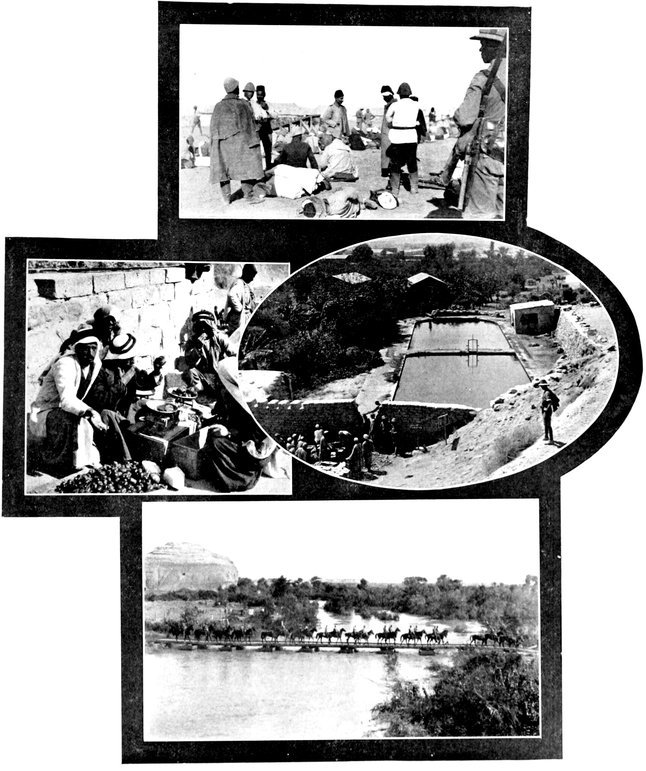
[top]
TURKISH PRISONERS AT BEERSHEBA
[middle]
STREET MARKET, JERUSALEM
Inset—JERICHO
Showing the pretty little Garden Oasis
[bottom]
LIGHT HORSE CROSSING JORDAN
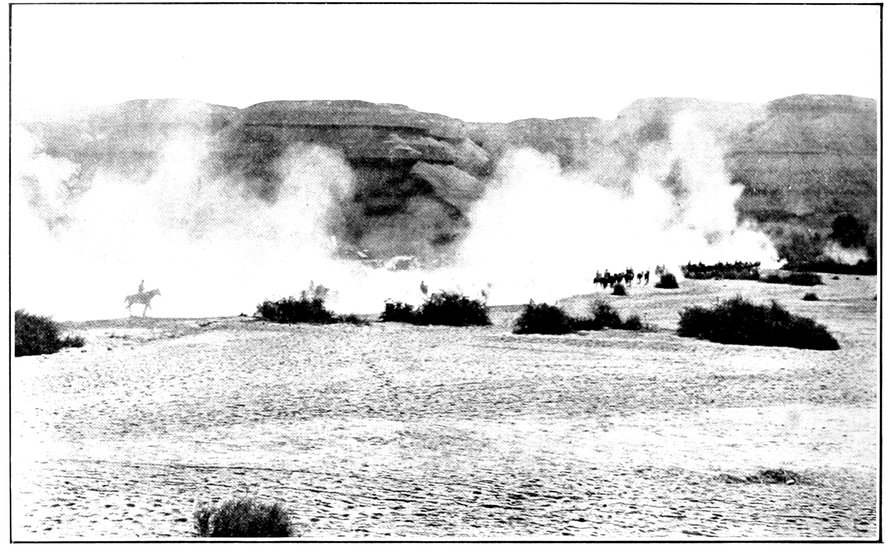
IN THE JORDAN VALLEY
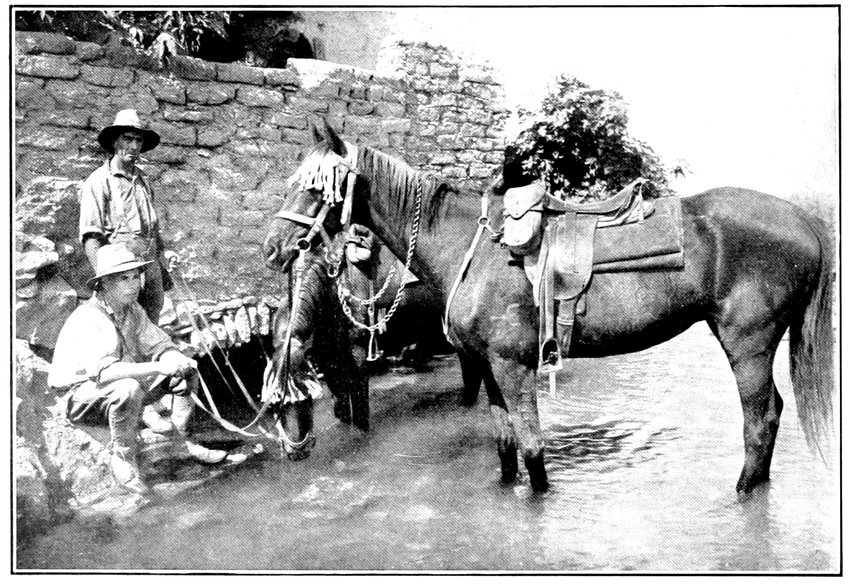
SPRING WATER, CLEAR AND COLD
31The bombardment opened at dawn, a heavy barrage. For half an hour the startled Turks were battered in their trenches. Then, abruptly, the bombardment ceased. “Now the infantry,” said a Brigadier of horse “and then!...”
Our battalions leaped forward as the gunnery died away, and carried the Turkish trenches after a brief struggle. They simply overwhelmed the enemy riflemen, and even the German machine gunners and Austrian artillerymen, after a wild burst of bad shooting, were forced to flight or submission. Within half an hour the infantry had made a gap for the great force of Indian and Yeomanry cavalry waiting near the coast, and soon afterwards they opened another a few miles inland. The expectant horsemen jumped off like thoroughbreds from the barrier.
They rode away in the sunrise, the advanced squadrons trotting out after the ground scouts, the flank patrols galloping wide; Brigade after Brigade rode out over the rolling sandhills. The men were eager, the horses fought for their heads. The swords of the Yeomanry flashed and Indian lances glinted from each successive skyline. It was like a war scene of the picture galleries. Quickening the pace, the Regiments raced on past our guns, most of which were already limbered-up for the pursuit. The infantry, busy with their prisoners, cheered them as they passed, and soon they were speeding down on Turks who had fled from the onslaught of the infantry. But their sport with sword and lance was brief. In this Sharon sector, the enemy had no forward reserves, no second-line trenches. The Turkish front here had depended for its safety on a one trench system. From the crossing of the trenches until they reached the Esdraelon Plain, late in the night, the cavalry encountered no resistance. Once or twice they sighted small bodies of the enemy and made for them at the gallop. But the Turks would not give battle. Before the campaign was three hours old there began the long series of almost bloodless surrenders which were to be the most amazing feature of the sleepless fortnight.
The perfection of our organization was revealed very early. The cavalry was scarcely clear of the trench system before scores of field guns were rumbling in their wake. And, pressing on after the artillery by many tracks, good and bad, went mile after mile of camels and wheeled transport. 32Where the cavalry went the supplies must follow; and the cavalry rode from forty to fifty miles between sunrise and midnight. With nothing to check them, their pace was controlled only by the endurance of their horses. The men rode light; they carried only one blanket, and that as a saddle-cloth. Tent sheets and waterproofs were forbidden. It was a wild ride against time. But horses were loaded with three days’ rations, and few carried less than 250lbs.—many of them more than 280lbs.
At dawn next morning the Yeomanry were across the Esdraelon Plain and in Nazareth, where they caught most of the garrison of 3000 and the whole population still in their beds. They secured the town at the expense of eighteen casualties. By noon the Esdraelon Plain was in our hands, and the Turkish Army in Western Palestine left without a line of communication or retreat, except at Beisan on the north-east corner of the trap; and the capture of Beisan was already assured. How completely the enemy was deceived, and how light were his forces on the sector broken for the cavalry, is shown by the fact that on the first day, although our horse travelled fully forty miles on a wide front, only 900 prisoners were taken by them. Next day, as the net closed round the forward enemy forces on the Central Range, and they attempted to retreat across the Esdraelon Plain, our cavalry took upwards of 12,000.
At the beginning of the second day, we contained the Turkish western army on the south, west and north. The Anzac Mounted Division, which is two-thirds Australian and the balance New Zealanders, and a light infantry force, all under Major-General Sir E. W. C. Chaytor, were moved up the Jordan Valley on the east of the Turks and so the net was completed. But the task of the Anzacs was difficult. Before they could move, the enemy guns dominating the narrow ground on either side of the river had to be silenced or shifted. This meant that the Turks had to begin their retreat on the Samarian Range before the Division could race them for the crossings. Not until the second day did this come about, and then the Anzacs, riding fast, closed the fords and the Turkish Western Army was doomed. Forty hours after the fight commenced, as the second day was closing, the enemy began to stream down the tracks leading on to the Esdraelon Plain from his forward mountain position. He had already 33abandoned guns and transport, a tragedy which he owed mainly to the appalling havoc wrought with bombs and machine guns by our airmen.
At dusk on the second day a large force was reported to be heading towards Jenin, on the northern edge of the Esdraelon Plain. General Chauvel, who was directing the battle from Megiddo (now Lejjun), the actual site of ancient Armageddon, at once ordered the 3rd Light Horse Brigade to move to the attack. An hour later, the Brigade had captured a mass of prisoners, who subsequently counted out at more than 7000; and we had the first evidence of the demoralization of the enemy. As the Brigade approached Jenin, with the 10th Light Horse Regiment (Western Australians) leading and the 9th (chiefly South Australians) working round to the rear of the village, the Turks ran out and surrendered in thousands. We had one officer and one man wounded. The only shots fired at us came from nine German riflemen, who fought to a finish, although two of our machine guns were laid on them at a range of sixty yards. The plan had put our troops into certain positions and the Turks, as at sham fight, recognizing the checkmate, were surrendering without bloodshed. Any resistance which followed on the long ride to Damascus came almost entirely from the Germans.
An endeavour has been made in the preceding pages to show how the galloping cavalry cordon was thrown round the main enemy position on the Samarian Range. Before the close of the second day, our horsemen, stoutly armed with machine guns and automatic rifles, in addition to rifle and sword and lance, and further strengthened by many batteries of horse artillery, held all the roads and railways behind the Turks and Germans. The enemy was practically cut off from supplies and retreat. Worse than that, he was already irretrievably smashed by the attack of the British and Indian infantry on his front. Recoiling from this blow, and hastening to reach the Esdraelon Plain before the cavalry completed the net, he was caught by our airmen in narrow mountain passes, subjected to terrible bombing and harassing machine gun fire, and forced to abandon most of his guns and transport. At the same time, the 5th Australian Light Horse Brigade under Brigadier-General Macarthur Onslow, accompanied by one regiment of French cavalry, was thrown in during the first day on his right flank, about halfway between the old front line and the Esdraelon Plain. The Australians, moving very fast, scattered with their swords a force several thousand strong north of Tul Keram and took two thousand prisoners. Then, riding all night, they cut the enemy frontline railway close behind Nablus. A few hours later, the Brigade captured Nablus itself.
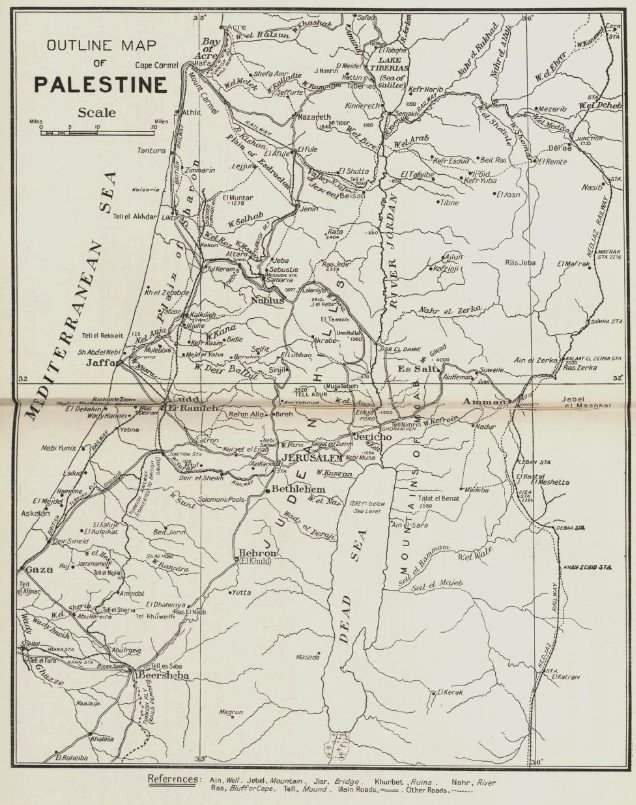
But before this the airmen had commenced their work in the passes. When our infantry broke the enemy’s line on the Plain of Sharon, many thousands of Turks, who were on the foothills eastward of the gap our cavalry had galloped through, had endeavoured to swing round and retreat to the highlands of Samaria. But the movement was at once detected by the Australian airmen. The Turks, with their transport, were seen to be heading for a narrow defile leading up from Tul Keram to Anebta. Using their wireless, the airmen called up aerodromes where dozens of British and Australian pilots were awaiting the signal. The doomed column, extending over upwards of two miles, was deep in the pass when the first flight arrived with its bombs. Beginning on the leading troops and vehicles, the airmen, flying low, had, in a few minutes, blocked the narrow track. Pilot after pilot, flying in perfect order, dropped his bombs, and then, assisted by the observers, raked the unfortunate Turks with machine guns. Their ammunition exhausted, the airmen sped back to their aerodrome for more, and returned again to the slaughter. Some pilots made four trips on that day. While the airmen attacked the column, the 5th Light Horse Brigade came up over the hills on either side of the track, and caught the Turks with their swords as they attempted to escape. Blocked in front, the battered, distracted procession closed up and telescoped, and fires broke out among the massed and broken vehicles.
Still more appalling, because of the greater magnitude of the disaster, was the fate of a column between Balata and Fermeh on its way down the range towards Beisan, on the Jordan. Flying over Samaria, you appreciate the opportunities which this retreating army offered to the airmen. The stony hills are not so rugged as in Judea, but they are still too steep to permit masses of troops to move off the narrow roads. These roads wind along beside the wadies and are flanked nearly all the way by abrupt hillsides. The Balata column contained the bulk of the enemy’s forward transport. It stretched, slow-moving and in full view from the air, over seven or eight miles of the confined track. An Australian reconnaissance pilot sighted it soon after dawn and, an hour later, dozens of British and 37Australian bombers and machine gunners, flying within a few hundred feet of the ground, were smashing it to splinters. Again they began at the head, and forced the helpless drivers to pile up from the rear. For hours the bombing was continued. Here the airmen worked unaided by any other arm of the service, and they had wrecked or disabled the whole of the transport before the infantry came up from the south and took the dazed survivors. The broken material afterwards collected in the pass included 90 guns, 840 four-wheeled and 76 two-wheeled horse and cattle vehicles, 50 motor-lorries and a large number of miscellaneous transport, such as water carts and travelling kitchens. The horror of the scene during the bombardment and afterwards need not be dwelt upon. As the bombs rained down with pitiless regularity, scores of lorries and wagons were overturned and dashed to pieces as they went hurtling down into the rocky beds of the wadies. Included in the column were large formations of infantry, and these and the drivers, rushing from the track to escape the bombs, were shot down by airmen. These air attacks were repeated many times on a similar scale in the first two days.
Rarely have the various services of an army worked in such perfect accord. The infantry drove the enemy from his front, the Australian and French cavalry, at the same moment, struck from the flank at his very heart at Nablus; as he attempted to retreat in good order, the airmen wrecked him from the skies, and, in a few hours, turned his army into a shell-shocked rabble, with few guns or munitions, and little food. The wretched Turks, in their tens of thousands, urged on by officers, came at last to the outlets into the Esdraelon Plain. When first the cavalry galloped down upon them, and they surrendered in hordes without the least attempt at resistance, we were astonished. It was not until we learned what had happened in the mountains that we understood the tragic state of their morale.
The air force achieved a notable victory. They had not only inflicted very heavy losses, but had incalculably lessened the task of both our infantry and cavalry. They had prevented the Turk from fighting effective rear-guard actions against the pursuing infantry, and had hammered him so soundly that he was incapable of any attempt to burst through our cordon of cavalry. Without this help from the airmen, General Allenby must still have won a great victory; but it would have been much short of the 38sensational one achieved. Progress must have been much slower, and our casualties heavier by many thousands.
Before the fight was two days old our aeroplanes were using aerodromes captured from the enemy. At one point on the march to Damascus, when we were a hundred miles from our starting-place, a number of airmen came up and established a flying ground abreast of our cavalry advance guard. Throughout the operations an air-post service was maintained between the leading troops and General Headquarters. An Australian Brigadier and a Colonel of the Light Horse, who were in hospital far down the line when the campaign opened, surprised their troops by alighting from aeroplanes in their midst, a hundred miles from our starting-point.
The few thousand Germans who were with the Turkish 7th and 8th Armies west of the Jordan met the same fate as their allies; nearly all were destroyed or captured. But one must give the Germans credit for a stout resistance. Throughout, they fought resolutely to avert the great disaster, and if all of them did not continue the struggle to the death, it must be remembered that they were in a desperate situation. They handled nearly all of the hundreds of machine guns, which were the most formidable weapons possessed by the enemy. All the way to Damascus they fought stout rear-guard actions.
Having the great body of Turks on Samaria safe, and most of them already accounted for, General Allenby decided to clear Haifa; the operation demonstrated the relative morale of the Turks and Germans. A flying reconnaissance of armoured cars and smaller cars of the Light Car Patrol was pushed into the outskirts of the town. About three miles from the town our force saw the heads of a party of Turks in a strong redoubt two hundred yards from the road. The armoured cars halted and swept the Turkish parapet with their machine guns. The white flag was at once hoisted, and about eighty Turks came out without firing a shot. Two miles further on, the British came upon an Austrian battery of light field guns, supported by German machine gunners. Our little probing expedition was at once brought to a standstill, and was not sorry to pull out. Next day the Indians and Yeomanry, supported by horse artillery, rode into the town, and again the only opposition came from the Austrians and Germans. “We tried to cover the Turks’ retreat,” said a captured German officer, “but we expected them to do something, if only keep their heads. At last we decided they were not worth fighting for.”
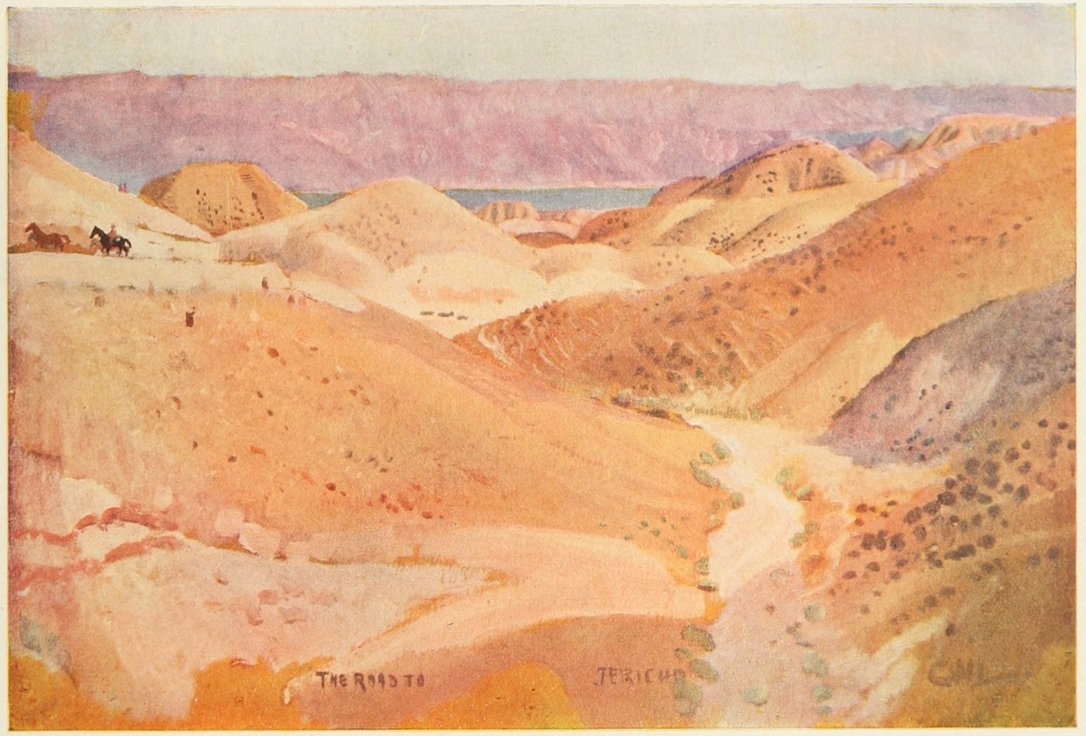
THE ROAD TO JERICHO
By Lieut. G. W. Lambert

ISMAILIA
Before Haifa fell our troops were moving swiftly east of Jordan. A Division of Indian and Yeomanry cavalry crossed the Jordan about Beisan and rode eastward. Simultaneously, the Anzac Mounted Division forded and swam the river further to the south, and moved on Es Salt and Amman. The Australians and New Zealanders were familiar with the country. This was their third expedition to the Plateau of Moab and the heights of Gilead. They knew every goat-walk on the steep mountain side. This time they had come to stay; the Fourth Turkish Army on the East was to share the fate of the 7th and 8th Armies on Samaria. The tactics employed on both sides of the river were broadly similar. General Allenby depended for success upon the speed and stamina of his horses. Before the operations commenced, the Turk held a defensive position which was roughly an extension of his line west of the Jordan. He was strong in the foothills of Gilead; on the mountain he had his base at Es Salt, and at Amman he had a substantial force guarding a vital series of tunnels and viaducts on his Hedjaz railway. Beyond the railway the Eastern Palestine Range flattens out on the wide desert, which extends right across to the Euphrates. On the fringe of the desert was the Army of the Sherif of Mecca, a picturesque, galloping, thrusting, well-armed force. The Arabs harassed the Turk by day and night, repeatedly dashing in and cutting his railway and telegraph communications with Damascus. When attacked, they would fade away into the wide desert and leave the slow-footed Turk in the air. While the Anzacs marched upon Es Salt and Amman, the Arabs made a detour in the desert, appeared on the flank of the enemy north of Deraa, and cut the railway where the Hedjaz line junctions with the line which supplied the Turks west of the Jordan.
Meanwhile the Indian and Yeomanry Division had crossed Eastern Palestine and reached Deraa, where it joined hands with the Arab army. Then the Arabs, the Indians and the Yeomanry sped on towards Damascus. There was still a chance of escape for some 20,000 Turks, who had moved northwards of Deraa before the arrival of our forces. These struggled gamely towards Damascus, hoping either to make a stand at that great base 40or to escape by rail to the north. But General Chauvel still had in hand the Australian Mounted Division and a strong force of Indians and Yeomanry, which had returned to the Jordan after the capture of Haifa. With the Australians leading, he marched from Esdraelon Plain north-east across Jordan for Damascus. Then ensued one of the grand races of the war. Our tired horses were called upon for the heaviest work of the lightning campaign. Marching by Beisan, the 4th Light Horse Brigade, after a stiff fight—the most expensive cavalry fight in the campaign—took Semakh, and then, co-operating with the 3rd Brigade, which had come down from Nazareth, occupied Tiberias. After a day’s partial rest, during which our men swam and fished in the blue waters of Galilee, the Australian Division marched swiftly for the Jordan crossing, a few miles south of Lake Huleh. But the enemy was now seized of our intention, and the German machine gunners put up a fine resistance. Their stand at Semakh aimed at preventing us reaching Damascus before the 20,000 Turks, who were retreating from the direction of Deraa, and to give time for the removal of as many military stores as possible from the city. South of Lake Huleh, also, the Germans fought well and delayed us for a few hours. We then ran through as far as Kunneitra, but, a few miles further on, were again held up by machine guns and a field battery.
Our horses had covered, with marching and fighting, an average of thirty and forty miles a day. Thousands of Australian-bred animals must have covered some 400 miles in twelve days, a very fine performance when it is remembered that they carried a load exceeding an average of 250lbs. and had been on short rations. On our ride to Damascus, the excellent work of the staff was demonstrated again. As the advance guard of the 4th Light Horse Regiment (Victorian), travelling north-east, came within view of the green and generous plain of Damascus, we saw, some eight miles away on our right, and moving north-west, a great converging column of the fugitive Turks from Deraa. Nearly all of these were captured, the Germans once more fighting well with their machine guns. But even the Germans had now almost given up hope, and on this last day before Damascus, and in the two days which followed, they abandoned their machine guns, and fled at the galloping approach of the Australians. That evening many thousands of prisoners were captured by the 3rd and 5th Australian Light Horse Brigades, and the city was enveloped.

[top]
IN THE JORDAN VALLEY
[bottom]
SHOPPING IN JERICHO
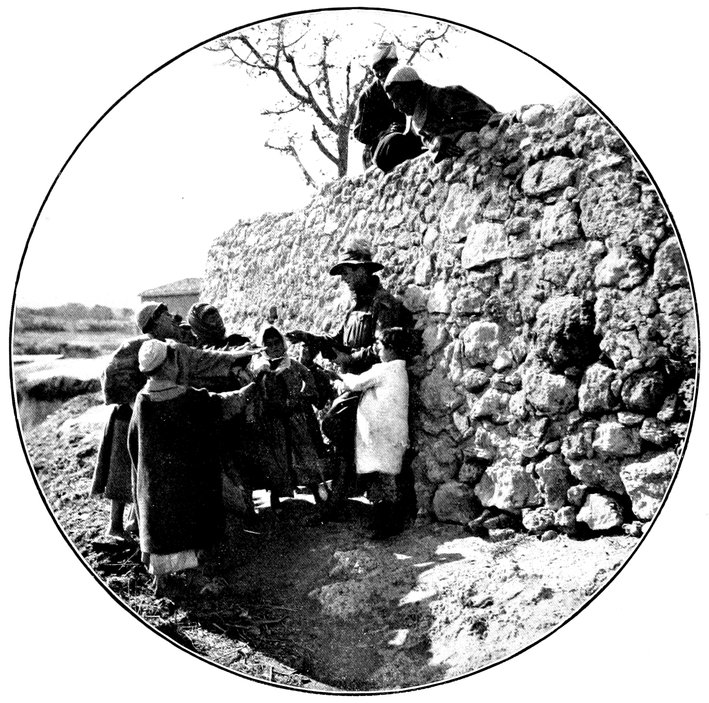
“BAKSHEESH”
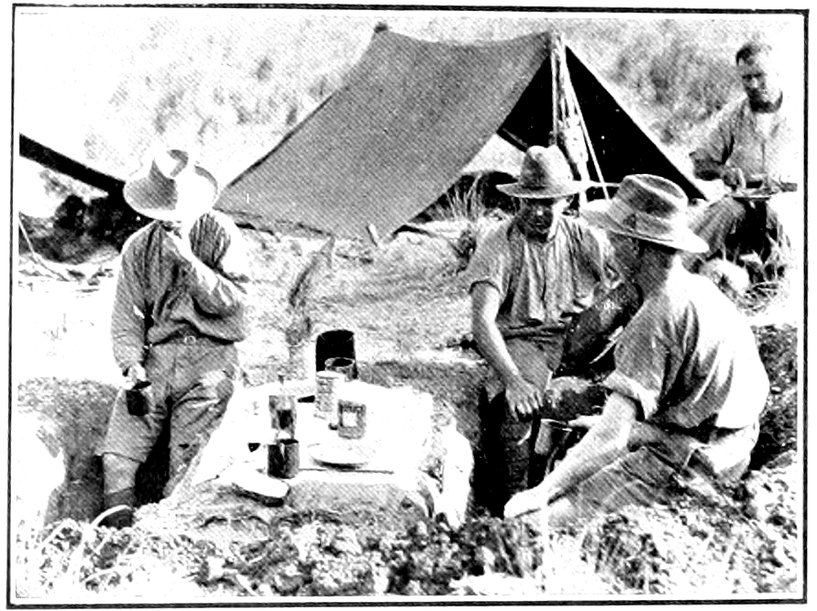
A MEAL OUTSIDE THE BIVVIES

THE DEAD SEA (SUNRISE)
By Lieut. G. W. Lambert
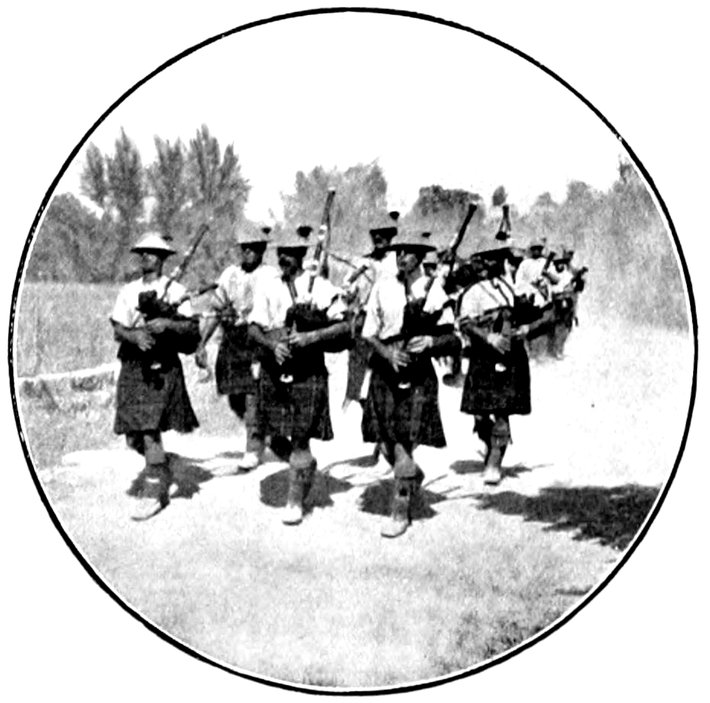
SCOTTIES ON A ROUTE MARCH
At dusk, in the Abana Pass, which leads out from Damascus towards Beirut, another disaster befell the enemy. Here, a column many miles in length was committed in a deep and narrow and singularly beautiful gorge. The floor of the gorge is less than a hundred yards across, and it is crowded with the Abana River—a rushing, mountain torrent,—a railway and a road. The river banks are overgrown with trees and bushes; the railway and road cross and re-cross the tumbling stream. On either side rise the gaunt cliffs of the desert. In this brief survey it is impossible to describe the fight between the long enemy column and the handful of dismounted Light Horsemen of the 3rd and 5th Brigades, who were perched in pockets of the cliffs on either side. The Germans, working their machine guns from the tops of motor wagons and lorries, fought to the death. Three hundred and seventy officers and men were killed, and fell among the dead and dying horses in the wild tumult of the chaotic column. We had scarcely a man hit. That ended the attempt to leave Damascus by the west; but the enemy was streaming out by the north along the road to Aleppo. Their run, however, was brief. Early next morning the 3rd Light Horse Brigade—the first force to enter Damascus—was in hot pursuit. The German machine gunners again attempted a rear-guard, but they could not withstand the charges of the elated Light Horsemen. Thousands of prisoners and hundreds of machine guns were taken by the Brigade.
On the morning of 1st October a squadron of the 4th Light Horse Regiment received orders to patrol into the city. Winding along the crooked lanes between the irrigated orchards and gardens, it came upon the great Turkish barracks, swarming with troops. The Turks did not at once surrender, and the squadron leader, before attacking, awaited the arrival of the remainder of the Regiment. Then followed a fitting termination to the wonderful, and practically bloodless, British ride. A few hundred of the 4th Light Horse took nearly 12,000 prisoners in Damascus before noon, together with dozens of field pieces and scores of machine guns. Scarcely a shot was fired. There was no formal surrender; each body of men laid down its arms as the Australians rode up.
The Victorians entered the city and joined up with the exulting Arabs. These two forces, which had started hundreds of miles apart with two 44mountain systems intervening, were mingled together in the midst of the swirling, madly-excited populace. To the Arab, Damascus was the dazzling prize, the promised reward. Here he was to proclaim and set up his government. Riding forth from his tent on the desert, or his little mud village, he was, in Damascus, the lord of a city of 250,000 souls—the oldest city in the world, and distinguished by the richness and strange character and beauty of its surroundings. Fired with pride, his long robes touched with brilliant patches of silk, he rode the streets on his sprightly desert horse, caparisoned with richly woven Persian saddle-bags. His scabbard of gold and silver flashed in the sunlight, and he fired his rifle freely at the skies. Ameer Feisal, the third son of the Sherif of Mecca, who was soon to be proclaimed the new ruler, rode into the city. The Arabs of the city gave an almost fanatical greeting to the Prince.
Although the Victorians secured the great haul of prisoners, the first troops to enter Damascus were the Light Horsemen from Western Australia, who, also, had had the distinction of being the first mounted men to enter Jerusalem, in December. The Western Australians found their way into Damascus by accident, and their ride was one of the most dramatic and picturesque incidents of the campaign.
The 3rd Light Horse Brigade, to which the Western Australians belong, spent the night in the Abana Gorge, a few miles from Damascus, to the west along the Beirut Road. Brigadier-General Wilson was under orders to move at dawn and seize the road leading from the city northward towards Aleppo. It was hoped that a track would be found around the outskirts of the town, but this proved impracticable. The Brigade, therefore, with a troop of scouts leading, and the Western Australians following, came down the Abana Gorge, clearing a track through the shambles of dead Turks and Germans and hundreds of camels and horses, heaped on the road in the fighting of the evening before. It soon became plain to the officer second in command of the Western Australians, who was riding ahead with the scouts, that the only way to the Aleppo road lay through the heart of Damascus. The city had not surrendered, and he did not know how many of the enemy it contained. But he decided on the bold course, and pressed on. As the scouts passed the outskirts of the city, riding a narrow road with the river on one side and a prolonged, mud-built garden wall on the other, there was a sudden burst of Turkish rifle fire. No one was hit, and the officer in command, checking the scouts until the advanced squadron of Western Australians came up, ordered drawn swords, and dashed on at a gallop. Across the river, two or three hundred yards away, were thousands of Turks at the barracks. For a moment, the enemy decision was in the balance. But the sight of the great Australian horses coming at a gallop (the Turks and natives never ceased to marvel at the size of our horses), the flashing swords, and the ring of shoes upon the metal, turned the scale. “The shooting by the Turks,” said one of our officers, “gave way, in a second, to the clapping of hands by the citizens.”
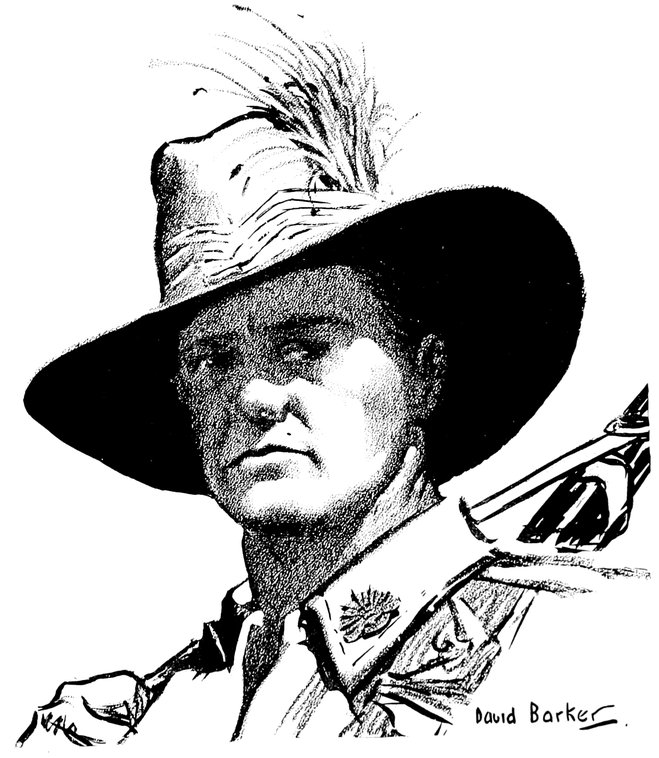
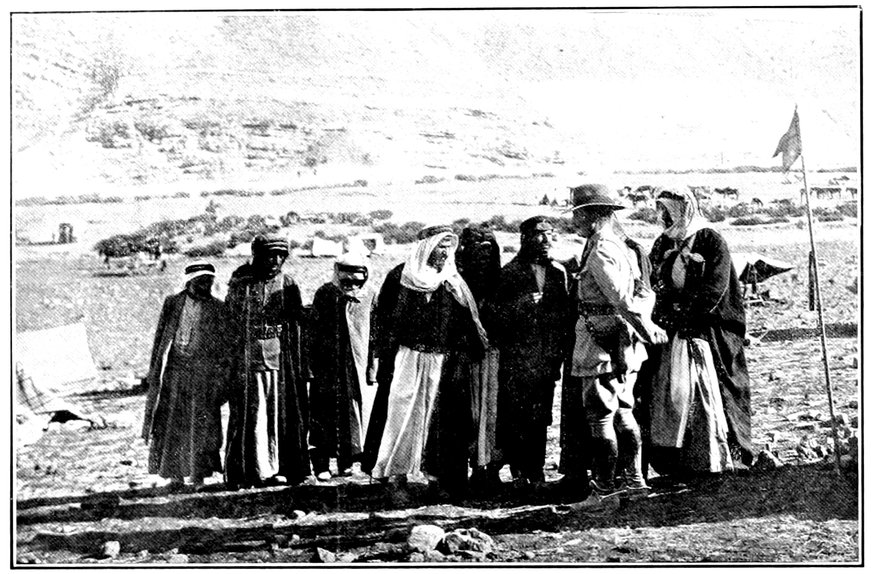
MAJOR-GEN. CHAYTOR RECEIVES A DEPUTATION OF ARAB CHIEFS NEAR AMMAN

JERUSALEM
47The Australians rode hard, scattering the excited people from their track. The firing increased, but its character had changed. The shots were now coming from native Arabs, who were expressing their feelings, in the popular Arab way, by blazing at the heavens. Across the river ahead, in front of the large new Town Hall, a huge crowd was assembled, and clattering over a bridge, the cavalry pulled up at the steps of the building. Instantly, there were hundreds of eager horse-holders, and an intense demonstration of goodwill. The East was greeting the victors of the day. Three officers, all carrying their revolvers, entered the building, and demanded the civil governor. They were at once taken upstairs to that personage, a trim, little middle-aged Turk, who greeted them with complete calm and much dignity, and begged to know their wishes. He was told that a great British force of cavalry was entering the town, and that he would be held responsible for good order and the protection of property; the shooting in the streets must instantly cease. The Governor replied that there was nothing to fear from the civil population, that the shooting was merely the expression of an excess of feeling, and that the British wishes would be respected in every way. He then begged the Australian officers to accept his hospitality.
A reliable guide was obtained and the party hurried forward. As the Australians continued their ride through the city they received the honours traditionally lavished on conquerors. The stalls were emptied of their incomparable grapes and pomegranates, which were handed up to the passing horsemen. Crowds hung to their stirrups and ran along with their hands on the bridle reins. They were smothered with perfumes. Every man who smoked enjoyed a gift cigar. Dark-eyed women and pretty girls appeared in every window, some of them the wives, doubtless, of Turkish soldiers, timidly, and showing no pleasure; others boldly waved their hands, smiled their welcome, and threw down scents and other favours.
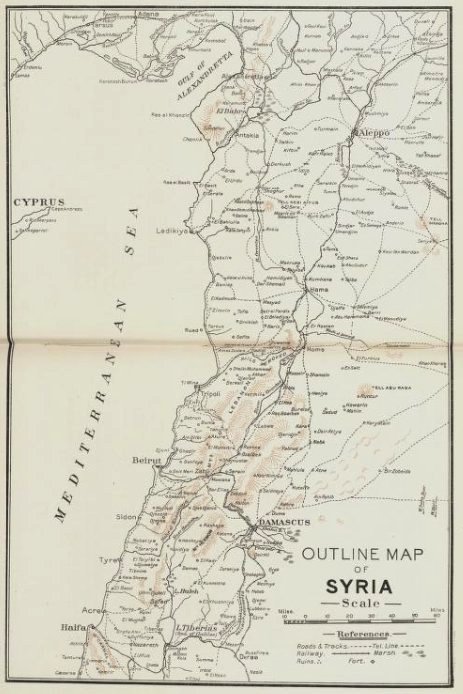
It was a wonderful hour for our young Australian countrymen. But the long war had made them into reserved men of the world, and the streets of old Damascus were but a stage in the long path of the war. They rode, very dusty and unshaved, their big hats battered and drooping, through the tumultuous populace of the oldest city in the world, with the same easy, casual bearing, and the same quiet self-confidence that are their distinctive characteristic on their country tracks at home. They ate their grapes and smoked their cigars, and missed no pretty eyes at the windows; but they displayed no excitement or elation. They had become true soldiers of fortune. And their long-tailed horses, at home now, like their owners, on any road in any country, saw nothing in the shouting mob or banging rifles, or the narrow ways and many colours of the bazaars, to cause them once to start, shy, or even cock an ear. The 3rd Brigade rode out to a series of ugly, but highly successful, actions with stout rear-guards of German machine gunners. Few men, in any age, have passed through twenty-four more adventurous and gratifying hours than they during this first day around Damascus.
The district of Damascus is an irrigation settlement on a vast scale, set in the midst of comparative desert. So rich and close are the orchards, and so tall the plantations of poplars and other decorative trees, that, looking over the city from the neighbouring hills, all you see of the city of 250,000 people are the stately minarets of its many mosques and the roofs of the larger residences of the rich. Immediately to the west of the town rises the bare, glaring mountain side, and to the east and north and south of the green expanse of gardens you ride out upon the harsh and treeless plain. Damascus owes all its wealth, even its very existence, to the torrential Abana River, which, surging down from Anti-Lebanon, bursts from the mountain gorge on to the plain and, splitting up into several beautiful streams, has made a rural paradise on the edge of the Arabian wilderness.
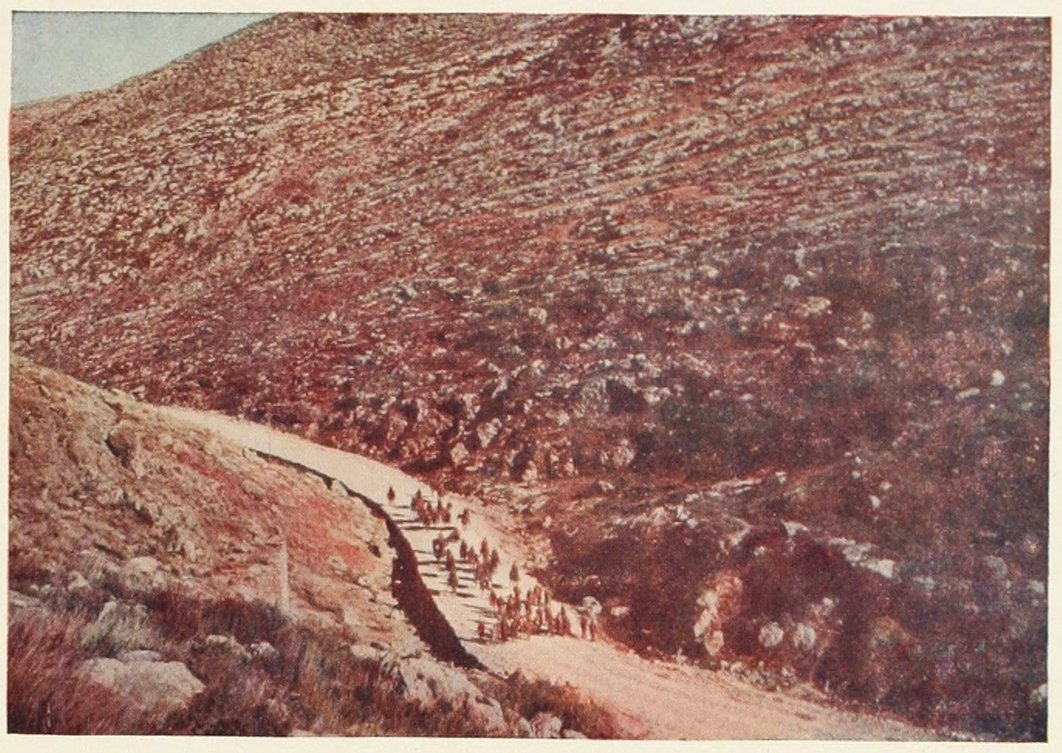
AUSTRALIANS ON THE ROAD TO JERUSALEM
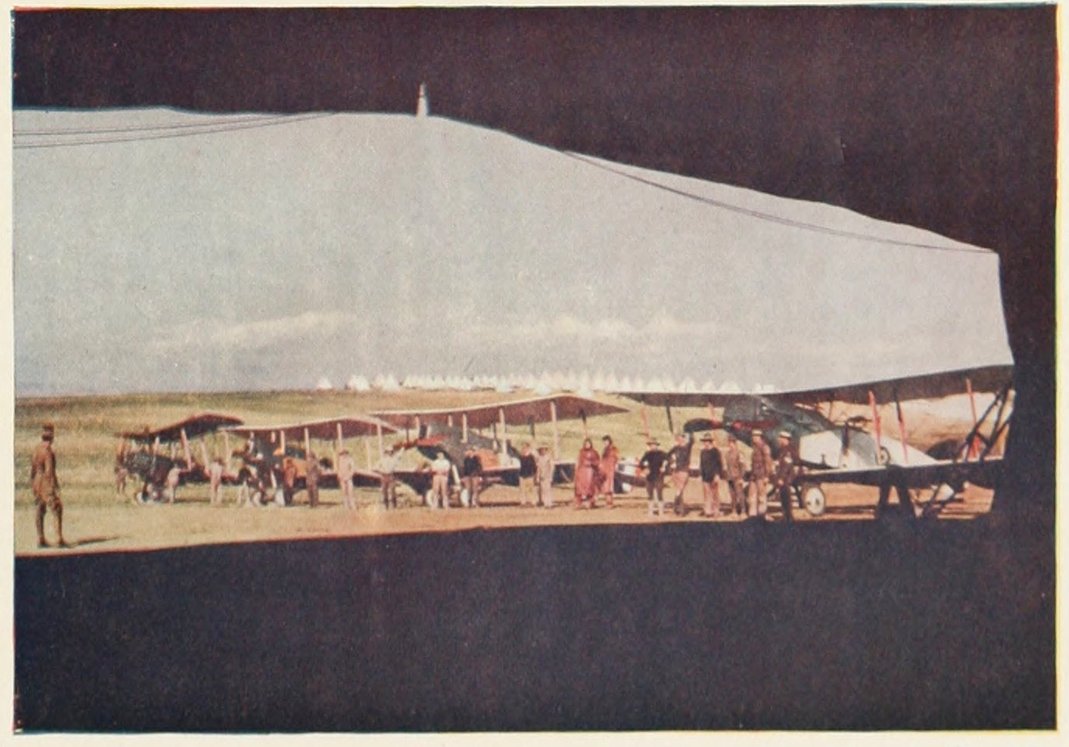
AN AUSTRALIAN FLYING SQUADRON IN PALESTINE
Photos, in colour by Capt. Frank Hurley
51In Palestine the troops looked in vain for the Promised Land “flowing with milk and honey.” The Plain of Philistia was fertile, but apart from the few Jewish and German colonies, and the orange groves about Jaffa, it was, with all its natural possibilities, a land bare and neglected, a reproachful ghost of a great life that is gone. But Damascus was a prize worth the winning. Here, after nearly three years of desert and exhausted, unfruitful regions, was an area good to look upon, and teeming with an active people. Few of us were sorry that we had at last outrun our supplies, or rather, that the huge capture of prisoners had somewhat strained the wonderful commissariat which had so gallantly kept at the heels of the galloping cavalry, and that a brief halt was necessary for the Australian Mounted Division. For a month some of the Regiments were in camps in the gardens around the city, and man and horse never accepted rest more gratefully. After thirteen days on bully and biscuit, it was good to know fresh meat and bread again; the mutton was of the best, and the bread, if dark and coarse and heavy, was still a long way ahead of biscuit. We were too late for the famous Damascus apricots, but there were grapes for the multitude, and pears and apples and pomegranates, and, also, raisins and other dried fruits and specialties in Eastern sweetmeats. Best of all, every camp was within sight and sound of many running waters.
Noisy little streams crossed our path a hundred times a day. Follow one along, and it suddenly disappeared into an underground passage, to burst forth like a spring a hundred yards away. In the streets, many of the gutters are river-fed waterways, and, to reduce the dust, the tired civic authorities block the drains and cause an effective little flood, which is extended by boys splashing with their hands. You buy grapes at the stalls, and carry them a few yards to dip into the waters of a mountain stream. But Damascus is dirty and insanitary. Without the purge of the Abana waters, flushing through it and under it, the city would die of its filth in a single summer. And even with its beautiful streams it proved a false friend to great numbers of Australians. The Australian Mounted division suffered more sickness in the Damascus area than anywhere else in the campaign.
In most of the operations which cleared Sinai and Palestine of the Turk, the lead was entrusted to the veterans of the Anzac Mounted Division. In this last and greatest campaign of all, the Division found itself away from the spectacular side of the enterprise. A trusty mounted Division was needed for the subsidiary, but highly important, work on Moab and Gilead, east of Jordan, and the choice fell upon the Anzacs.
The Australians and New Zealanders complained about their luck. But their task made one strong appeal to them. Twice before they had been across the Jordan, and twice they had returned leaving not a few of their men in enemy graves. The two great raids over the river, early in the 52year, were brilliantly successful, as raids. Each time our purpose was achieved. But each time our men broke off the fight strongly against their inclination, and prayed for the day when they would get orders to go over and see the job through, and stay. Old Amman, the ancient Philadelphia, was especially coveted by our men. There, in March, 1918, we had fought for days over sodden ground in extreme winter weather and come away, the railway having been well broken, just after the New Zealanders had won into the town. This time, Australians and New Zealanders competed, in a sporting way, for first entry, and the 5th Light Horse Regiment, from Queensland, narrowly gained the honour.
At the outset, the Anzacs, and the small infantry force operating with them, made up chiefly of the Jewish Battalion, the British West Indians and troops from India proper, had no chance of breaking out of our bridgeheads east of the river. Their orders were to keep in very close and firm touch with the enemy, and to demolish him as soon as he began to withdraw in consequence of his defeat on Samaria. Also, this Jordan Valley force was to push northwards up the Valley, and complete the cordon round the two Turkish armies on Samaria. Both missions were admirably accomplished. While the New Zealanders and infantry were advancing up the Valley, the Australians were probing the strongly entrenched and wired positions along the Moab and Gilead foothills, across the river. As soon as the Turk moved the two Australian Brigades pounced upon his rear-guard, and fought him as he climbed the narrow wady tracks up on to the tableland. Meanwhile, the New Zealanders, crossing away to the north at Jisr el Darnie, ascended the goat-track which leads from there to Es Salt, and, for the third time in the campaign, that old stone-built town was in Australasian hands.
All the way our men had evidence of the success of the British bluff. The Turks’ defences on the foothills, and higher up, were particularly strong. Had our main attack gone that way, the fight would have been very bitter, with the enemy in a strong natural position. But now the Turks were compelled to abandon their stronghold because of their disaster in the west, and, also, because the Arabs had broken their communications to the north, and were joining hands with a British and Indian cavalry Division right across those communications. As the Australians passed Shunet Nimrin, they discovered a long-range navy gun lying on its side, a piece known to them as “Nimrin Nellie” and “Jericho Jane,” with which the Turk had often made our camps near Jericho dusty and unpleasant.

ORANGE SELLER, JAFFA

IN THE SHADE
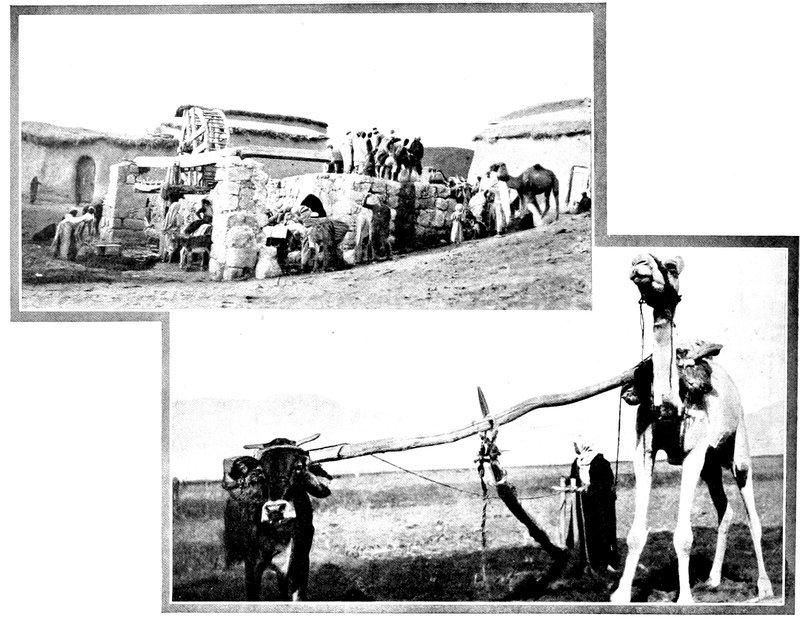
[top]
THE VILLAGE WELL
[bottom]
NATIVE PLOUGH AND TEAM
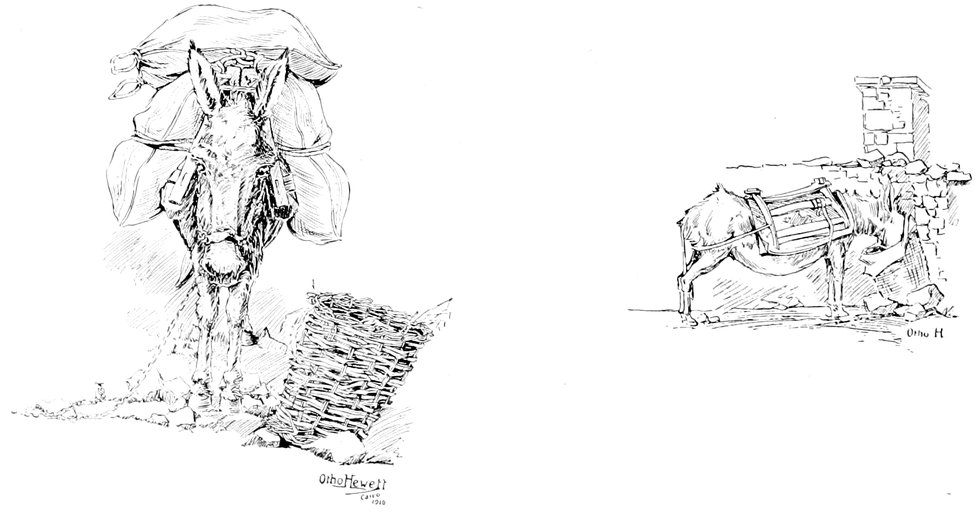

JAFFA

AUSTRALIANS PRIOR TO THE FIGHT FOR HEIGHTS OF NALIN
Photos, in colour by Capt. Frank Hurley
It was not until our men were far across the tableland, and close to Amman, that the enemy showed fight. There our advance guard came under machine gun fire; but the Division’s rapid advance on the town was not stayed. As the scene of the severe March fighting came into view the Australians appreciated the disaster which had so suddenly fallen upon the Turkish arms. In March, the only possible approaches to Amman led through hurricanes of machine gun fire, together with shells from several field batteries. But now, the broken foe, although he fought gamely at this particular spot, was quickly out-witted and out-classed by Light Horse manoeuvre, and soon the Australians, after trifling casualties, were riding in the streets of the squalid modern village, and marvelling at the glory of the ancient Roman amphitheatre. Contact with the Roman in this hour of our triumph did us good. It subdued our vanity. In these far outposts of the old Roman Empire, on the very edge of the barbarian desert, the massiveness of the stone-work and the fine quality of the decorative carving proclaimed to the least imaginative mind the culture and mighty physical achievements of our great rivals in the task of Empire building. “The splendour that was Rome” is told far more convincingly in distant Amman and Baalbek than in the ruins of Rome itself.
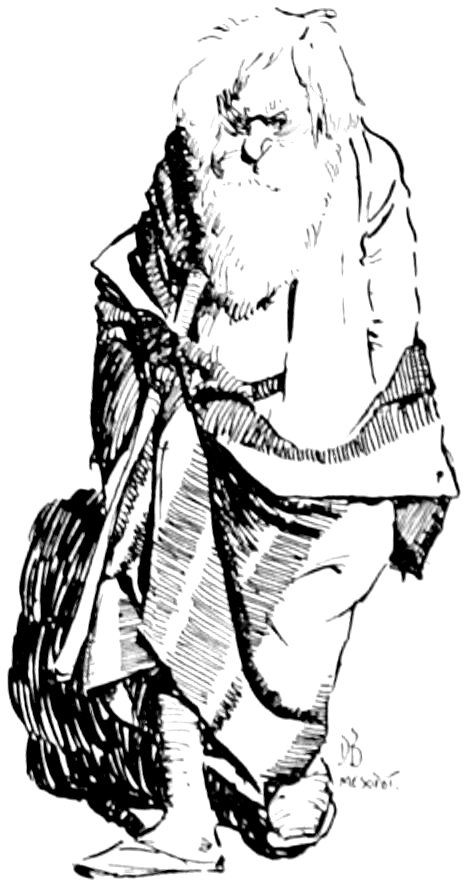
The Australians took 350 prisoners in Amman, and the New Zealanders another good bag as the Turks attempted to escape to the north. But the chief, and by far the most amusing, exploit of the Anzacs’ campaign, fell to the 2nd Light Horse Brigade under General Ryrie, at Ziza, about twenty miles to the south. News came through that a large Turkish force, which had been far to the south on the Hedjaz railway at Maan, was in an entrenched position at Ziza, and a regiment of Queenslanders rode down to spy out the land and, if possible, to smash them. The C.O. reported that he was in touch with 5000 Turks, who wished to capitulate, but they would not lay down their arms until they were sure that a great force of hostile Arabs, by whom they were surrounded, would be kept away from them. So the Colonel of the Queenslanders suggested that the whole Brigade should hurry down to assure the Turks of their safety. General Ryrie at once decided to go, and the twenty miles were covered in less than three hours.
The Brigade arrived shortly before dark, and an extraordinary situation was discovered. The Turks were in a strongly defended position around the village. They were made up, in the main, of Anatolians, regulars and the cream of the Ottoman army. Moreover, they were well armed and capable of a good fight. Our Brigade was not complete and was outnumbered by about ten to one. The Turkish commander rode out to meet the Australian Brigadier. “I will surrender,” he said, “if you will protect us against the Arabs.” “Certainly,” said the Brigadier. “The Arabs are our allies; if you surrender, you have nothing to fear.” But the Turkish leader would not be convinced, and he demanded that the Australian force should be greatly increased before his men gave up their arms. Otherwise, he would be pleased to fight. General Ryrie was anxious to complete the surrender and save casualties, and the Australians and Turks spent the night together in arms around the same camp fires!
Next morning, the Turks laid down their arms and marched as prisoners to Amman. The incident was an interesting sidelight on the feeling of the Turk towards the Arabs, whom he has so long governed. But it is a highly significant fact that, in the long campaign, the Arabs took 17,000 Turkish prisoners, and the Turks not a single Arab. To the Arab, the Turk has been an enemy in arms. To the Turk, the Arab has been a rebel, and deserving of a rebel’s fate.
Ziza practically finished the Anzacs’ brilliant little campaign. In all, some 11,000 prisoners were taken. The total battle casualties for the Division did not exceed a few score.
The writer of this sketch has been obliged to keep severely to the work of the Force as a whole, and has recorded little or nothing of the great achievements of the many technical services, lacking which the victorious progress of the Light Horsemen would have been impossible. The performances of the Australian No. 1 Flying Corps Squadron, the first Commonwealth Flying Squadron engaged in the war, deserve a volume to themselves. Recruited chiefly from the Light Horse Regiments, both pilots and observers excelled in resource and daring, and in their golden chivalry to their foes, and in their many fine rescues of fallen comrades far behind the enemy lines, shone the spirit of Saladin and King Richard. They were the modern Knights of Palestine.

ANZAC RIDGE, GAZA
By Lieut. G. W. Lambert
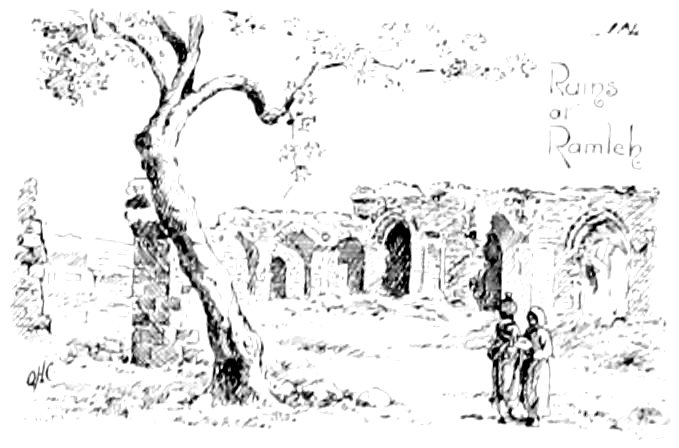
57Then there were the Engineers (no attempt is made to place these services in order of merit—a hopeless task), who found us water at will, as with a magician’s wand, beneath the blistering sands of Sinai; who bridged the Jordan under heavy fire for the crossing to Moab, and who, so often, blew enemy railroads, bridges and viaducts heavenward. Working over every kind of country from the desert to the mountains, they won through because of their indomitable spirit, and their boundless gift for improvization.

In the whole war there has not been a campaign which depended so much for its success upon the native wit of the individual. Conditions changed with dramatic suddenness from battle to battle. What served to-day, was useless to-morrow. As an example of this, take the superb work of our Medical Services. The Medical Officer was, all the way, a man of many inventions. In the desert the wounded were habitually carried on sledges made of sheets of galvanized iron, and, later, upon an improvement of this device; as the campaign progressed, they were borne on camels; and once, at least, in the mountains east of Jordan, they were carried lying flat on rough beds made of greatcoats on the backs of horses; and as the road improved, they were carried in two-wheeled sand-carts, in ordinary G.S. wagons and every kind of motor. The Light Horse galloped, and those who would serve them must gallop too. The almost miraculous rapidity and efficiency with which the Medical Units would establish their various stations and communications, at the very heels of a fight, distant perhaps a hundred swiftly-covered miles from railhead, made them worthy peers of the sparkling horsemen. And, thanks to the establishment of the mobile operating theatre—a veritable galloping machine, like the rest of the force—under a gifted surgeon, it was possible for the most intricate skull and abdominal operations to be carried out at the edge of the zone of fire. All honour to our doctors and their devoted staffs! And especially dear in the memory of Light Horsemen will always be the mounted stretcher-bearers. No wounded man was beyond their gallant reach.
Of the Light Horseman’s debt to the Nursing Sisters this narrative will not dare an estimate. As long as memory lasts, every officer and man will think with deep gratitude of the sustained, self-sacrificing devotion of these noble Australian women. Fighting in this alien and uncivilized land, thousands of young Australians for years never spoke to a British woman, 58except when in hospital. What the ever-ready sympathy and helpful friendship of the Sisters meant to them only these lonely soldiers could tell.

The supreme masters of improvization were the officers and men who handled the supplies. Not only the Australians, but the whole of the Imperial Cavalry—the greatest mounted force in the war under a single command—led by General Chauvel, depended for their rations upon the distinguished ability of the Queensland Colonel who was responsible for the direction of the supply and transport for mounted corps in the Desert. A cavalry force requires about four times the quantity of supplies which suffices for infantry, and, on occasions, it travels four times as fast. During the ride to Damascus, the horsemen, more than once, covered sixty miles in twenty-four hours; and on the whole advance, no man or horse went short of a mobile ration. British railways, captured Turkish railways and rolling-stock, motor-lorries, four-wheeled G.S. wagons, two-wheeled limbers (their off-side horses carrying pack-saddles, so that, if the vehicle failed, the load could be transferred), camels in tens of thousands, countless mules and donkeys—the interminable, sleepless procession on the roads during General Chauvel’s final triumph was a fitting culmination to the great transport record from the Canal onward.
Of our Australian machine gunners and signallers, and of the model Veterinary Service, which cared for our sick and wounded walers as promptly and faithfully as the Medical people cared for the men, and of the British batteries of Horse Artillery, which unfailingly advanced to extreme limits with their guns and shot so unerringly (never was man so welcome as a galloping gunner in a sticky dismounted fight)—of all these, it is enough to say that without them Palestine could not be ours to-day.

The fighting ceased for the Australians early in October, with the capture of Damascus and Amman, though No. 1 Australian Light Car Patrol (Captain James), accompanying the 5th Cavalry Division, took a prominent part in the capture of Aleppo, and in the pursuit of the Turko-German forces north of that city. The final campaign yielded prodigious results at a trifling cost in battle casualties. Of the 75,000 prisoners made by General Allenby’s Army, more than 40,000 were taken by the Australian and Anzac Mounted Divisions. The losses in killed and wounded, in the two Divisions, were nominal. Unfortunately, however, the 59Force then suffered the worst spell of sickness it had known since leaving Australia. The terrible ordeal of Jordan Valley during the summer took its suspended toll. Malaria ran like wildfire through the regiments, and there was also much acute influenza with pneumonia following, sandfly fever, and other more or less serious diseases peculiar to the Holy Land. Many brave men, who had survived four years of hard fighting and extremely rough living, lost their lives by sickness in the moment of victory.
The Australian Mounted Division was pushing on from Damascus towards the country north of Aleppo, and the armistice was signed as they reached Homs, which marked the northern limit attained by the Light Horsemen.
To-day, the force asks only one question: “Who goes Home—and when?”

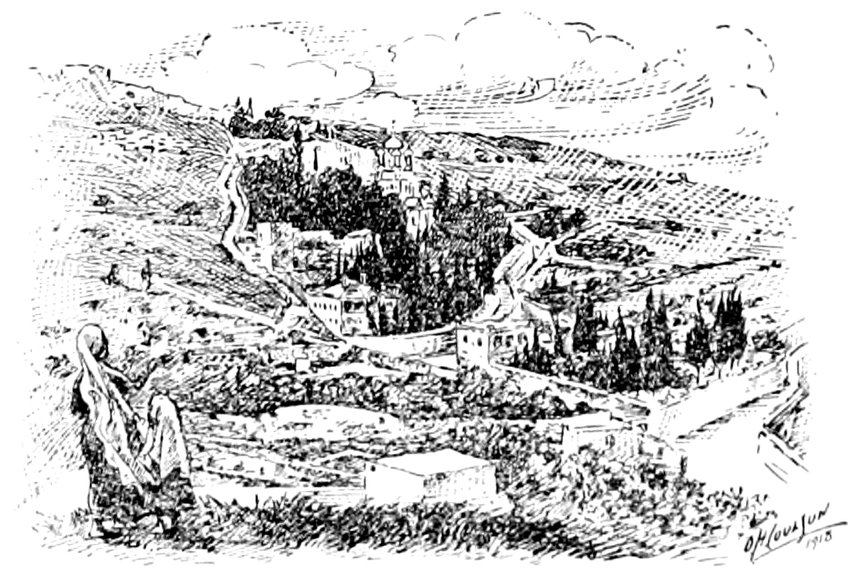
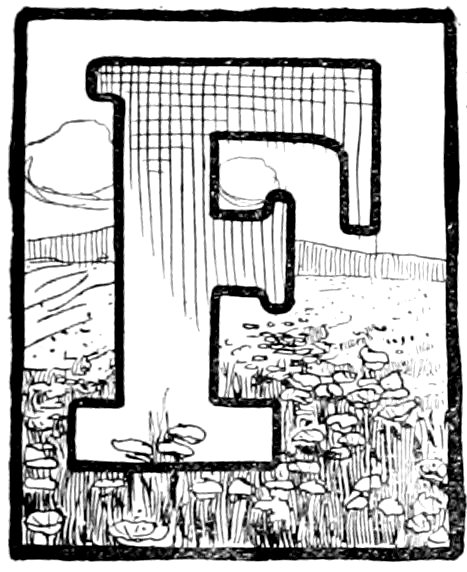
From the hills to the sea, a scarlet trail of flowers in the spring, when the little grey larks are singing and all the low country is green with barley. Wild flowers everywhere, yellow and purple and butterfly-blue—but the poppy is our choice. It glows on Australian graves in the plains and down by the sea where the surf croons all day long; it makes beautiful old battle-grounds, and flakes the wady’s brown banks with scarlet. The blood-red poppy is Palestine’s flower. At the wind’s touch petals fall from the slender stems to lie softly in the grass, as if some rare and lovely bird had shed its plumage there. The red poppy is our flower of War, and in the tranquil days of Peace will be our flower of Memory.
Among the sea-dunes white lilies grow, and they, too, will have power to win us memories of Palestine, unclouded by sorrow; memories of the blue Mediterranean, serene as a summer sky, or flinging ramparts of foam alongshore. When we camped at Malala or Marakeb beach, heeding all day the call of the surf, the land wind bore to us faintly the scent of blossoms unseen. A colour, then, and a fragrance of flowers are the gifts we shall take overseas. One will bring memories tinged with sadness; the other of golden hours.
Palestine is a wild garden in spring. Many plants blossom on through the summer, fading at last in the season of mists, when dawn comes veiled like a bride and the earth is pearled with dew. In spring, when the wattles shower gold on our streams, Palestine poppies are blooming. From the white sea-dunes to the long blue hills the land is alight with flowers. And all the larks of the world and all the butterflies seem to be gathered there. Over every blossom some bird is singing or a butterfly floating on sunlit wings. A murmur of bees in convolvulus bells; grasshoppers leaping over the tall grass; wagtails gleaning in sheltered places; white vultures high in the blue; and kestrels hovering over the barley, keen-eyed for prey.
62Those long rides across the plains, before the Turks were driven back to the hill country, were wonderful. Our horses breasted a green sea of barley, and it was hard to urge them on. Often we drew rein to look at leisure on the earth’s green mantle inwrought with flowers. The plains and the valleys were beautiful. We rode inland along the blue ways of Dawn, rode on till noon, then, after rest, took the sunset trail, when cloud shadows were skimming over the earth. We gazed at the purple ranges and wondered what lay beyond. Under the stars we slept well.
One ride I remember more vividly than all others. We started at sunrise from Belah, rode through a village, and came to a place of little hills whose slopes were bare of trees. Here the Bedouins had pitched their tents, some on the hills and some in the valleys, singly or in groups. When we cantered past men came from the tents to look at us, and children followed after, wailing for backsheesh. The women remained at their tasks. Dogs barked at our horses’ hoofs till their masters cursed them, when they slunk back snarling. We travelled on, with Fara on our left—a great grey bulk against the sky—coming at length to old pasture-lands that War had restored to Nature. Where dust had lain deep, and all plant life had perished under the feet of an army, Nature had won loveliness, healing earth’s wounds with grasses and flowers. It seemed an idle dream that the red tide of war had surged where poppies flamed in the sun and the little speedwell’s eyes of blue shone amid the grass.
Far as our vision ranged the land was bright with flowers—tulips, blue salvias, scarlet pimpernels, asphodels, white daisies, anemones, and lilies swaying on tall stems; hollows brimming with sunshine and pink with cyclamens; acres of red poppies set in emerald; sky-coloured lupines; a green knoll fringed with “pheasant’s eye”; and away to the west a long, brown field flaked with white convolvulus flowers.
For a mile we rode along the wady, seeking vainly an easy descent for the horses. Every cleft was starred with flowers; over the ledges melon plants trailed, making caves of tiny crevices haunted by lizards and spiders. Down a steep track we rode carelessly, letting our eyes dwell on blossoms and giving the horses free rein. We won to the other side safely, then on again through flower-land, with the white tents of the Camel Corps gleaming afar at Shellal. A long, glad ride from dawn till dusk across the plains in spring.
When we carried war to the Judean hills we found wild beauty there; flowers among the terraced hills and olive trees in the valleys. Pink hollyhocks 63grew on the heights along the Jerusalem road. The valleys were gardens. Gehenna’s goat-tracks, winding among old tombs, were bordered with scarlet poppies.
Wild flowers are Palestine’s glory. No one has named them all. From Dan to Beersheba, among the hills of Moab and Judea, on the wide plain of Esdraelon, on Hermon and Tabor, in Gilead and Bashan; everywhere in Palestine Spring casts down her kindling buds. We have seen them all in our long campaign, and out of the shining company have chosen two for remembrance: the little red poppy (symbol of sleep), and the lily that grows by the sea.

Up in fanatical, uncorrupted old Hebron, where, happily, the cheap tourists are afraid to venture, you see the rude but expert craftsman making the plough. Seated in his gloomy little recess, hewn out of the stone of the hillside, he works swiftly with toes and fingers. Seizing a rough bent branch of an olive tree, he stands it up and grasps the lower end firmly with his deft and supple toes. The pieces fly. Slashing and turning, he lops the smaller limbs, hacks it here and prunes it there, and, in a few minutes, flings it aside complete, except for the steel tip which plays the part of the share.
For a few shillings the plough is bought by the Bedouin. The selection of the land for cultivation is equally simple. Over most of the Palestine we covered, there is little regularity in the tenure of the small holder. The Sheik of the village has a loose control over a wide area, for which he pays tribute and taxes in grain to the Turk. The Bedouin is granted a plot the size of which is according to his capacity to cultivate and his inclination to work. He is rarely ambitious, and always lazy. If he has more than one wife, or has children of a working and a hungry age, he will extend his area. But, like the piece of glass bottle in Grimm’s fairy tale, he loves best just to lie about and glitter in the sun. That is better than any exceptional success as a farmer.
As a cultivator he has complete confidence in Allah. He has never heard of artificial manures, or of the rotation of crops; he rarely troubles to irrigate even when water is available. Here, as all over the Eastern Turkish Empire, there is fertile land for every inhabitant, and to spare. So the Bedouin roams wide with his plough. He crops here this year, and next year tries a patch a few miles away, which has been resting for a season or two under the thin native grasses. His selection made, he appears at dawn one morning, riding on his mournful ass and carrying his plough in front of him. Or perhaps he rides one of his little black oxen and leads the ass; or he may ride either the ass or the oxen and lead a horse or camel. The point is, that he always rides and carries the plough, and that his wife, if she is in attendance, always walks and carries half-a-hundred-weight of something on her head. It is a significant commentary upon his neighbours that he always brings his plough home at night.
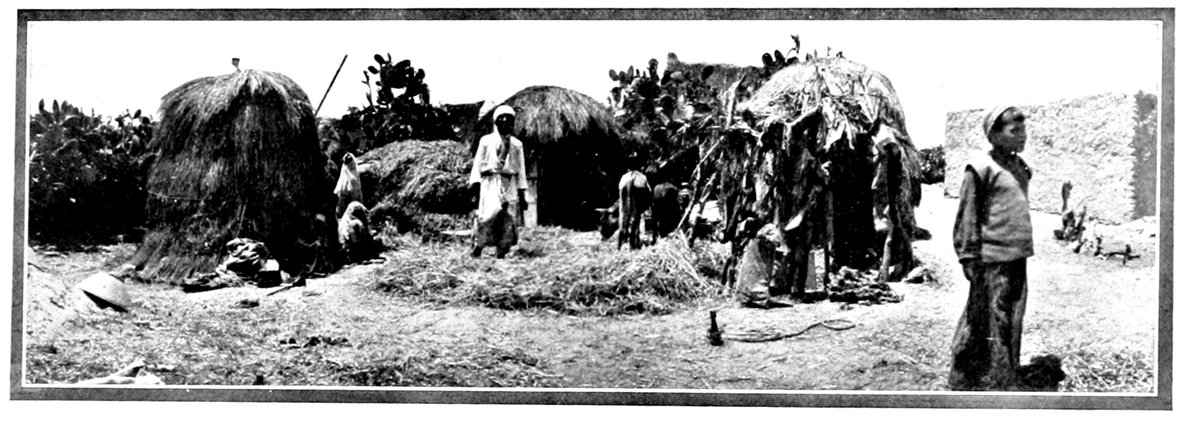
HARVEST TIME

PLOUGHING AS OF OLD

NATIVE STOCK

THE FRANCISCAN MONASTERY

LAKE OF TIBERIAS
67In his team he seldom drives two of a kind. It is a cow and a donkey, or a scabby, bony ghost of a pony and a camel. You can yoke them as you please. Palestine is a land that knows no shame, and so the horse does not rebel at being harnessed with a cow. Lazy as he is, the Bedouin is always up at dawn. At dusk he goes to his mat to sleep; he cannot read, and the villages burn no night-lights.
Cleverly holding his simple plough upright with one hand, he pelts clods at the team or wields a long goad with the other. Up and down he scratches little gutters a few inches apart, his camel towering ludicrously above his ass. Usually, he sows his seeds in strips before the plough. He rarely harrows and never rolls, but sometimes he shows a sense of the value of fallow by ploughing twice. The rest he leaves to Allah.
Sometimes, in the spring, he will pluck the wild turnip and radish and other tares from the growing corn. As a rule he prefers to sit in his coloured rags in the pleasant sunshine. Or he may go off to Jaffa with his asses and his women, and traffic in oranges. Then you see him, with both asses and women brutally overloaded, goading the donkey, or perhaps astride behind the burden of fruit, as the little long-eared slave totters along the tracks. The women, like the asses, never protest. The man is master. It is the way of the East.
The beautiful lilies and poppies vanish as summer comes upon the rolling, treeless plain. The corn ripens and harvesting begins. Machinery plays as little part here to-day as it did among the “alien corn” near Bethlehem long ago, when pretty Ruth worked for Boaz. In Palestine the world has stood still for a thousand years or more, or when it moved it moved backward. Much of the barley and wheat is pulled up, roots and all, but some is cut with sickles. In each village there is a harvest floor—a patch of clean, hard ground, where each man builds his little stack and sees about the threshing.
Occasionally you see the flail at work, but it is not popular. To wield the flail is hard work. So the Bedouin employs his cattle, his wives and his children. He spreads the loose crop in a little circle about two feet deep. Donkeys and oxen and ponies are then tied together, from two to four abreast, and goaded round and round upon the straw. Sometimes the threshing is done by their hoofs alone; but often a rude wooden sledge is drawn after them. Time is of no concern. The cattle barely move; the 68owner sits with his friends under the shade of an olive tree, smoking many cigarettes and occasionally dreaming luxuriously over his hubble-bubble; pleasant breezes blow across from the gleaming Mediterranean. The season has been generous: Allah is good. Why hurry?
The threshing finished, rough wooden forks are used to remove the coarsest straw, and then the winnowing begins. Day after day the harvest is thrown high into the air, and, slowly but surely, the chaff and dross are separated from the grain by the Mediterranean breezes.
Then the Turk comes—or he did before the war—and takes from thirty to sixty bushels out of every hundred! That is why the Bedouin is so fond of glinting in the sunshine, like the piece of glass bottle in the old fairy tale.

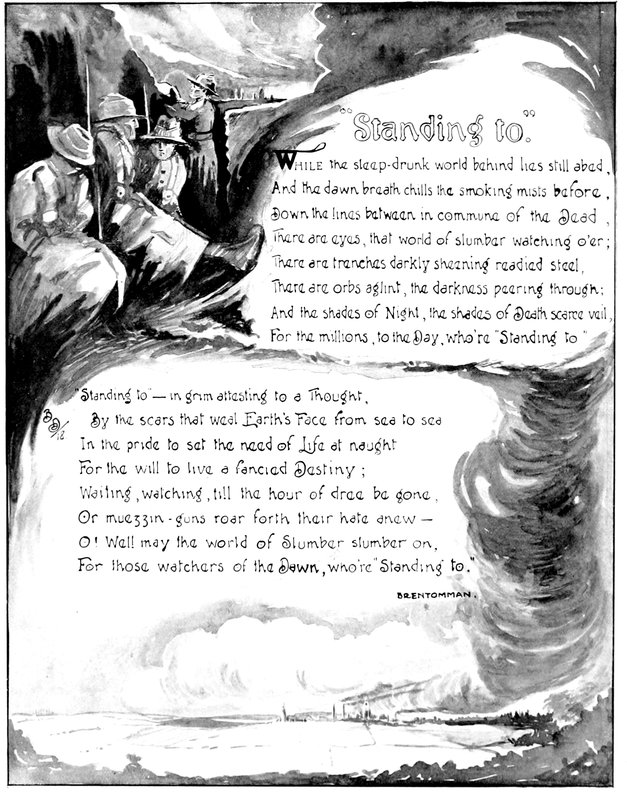

OUTPOSTS
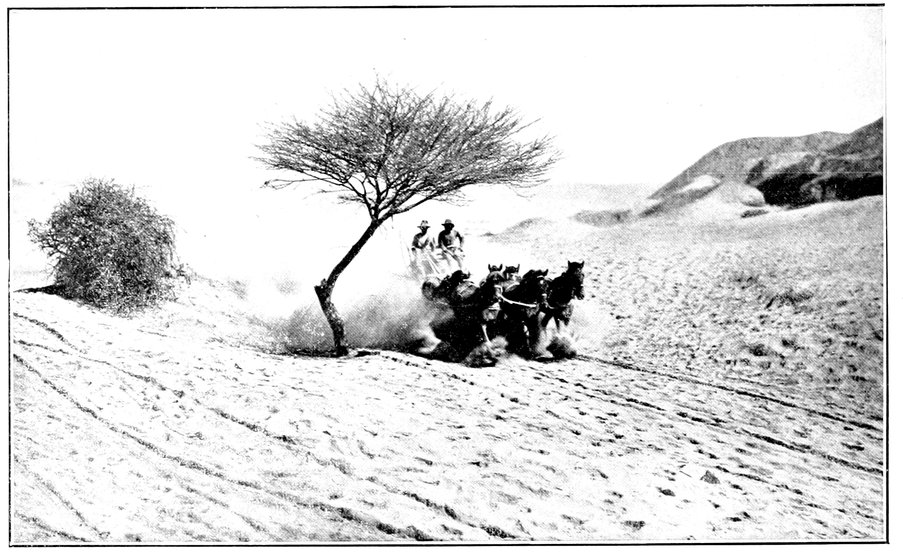
JORDAN VALLEY DUST
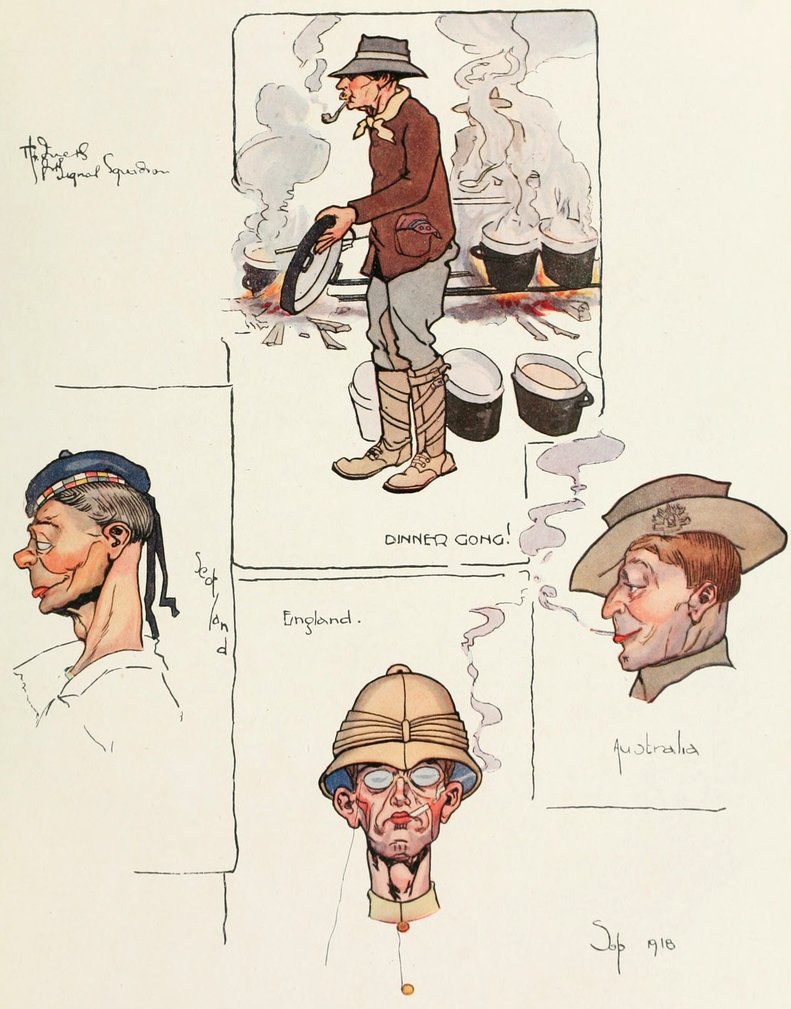
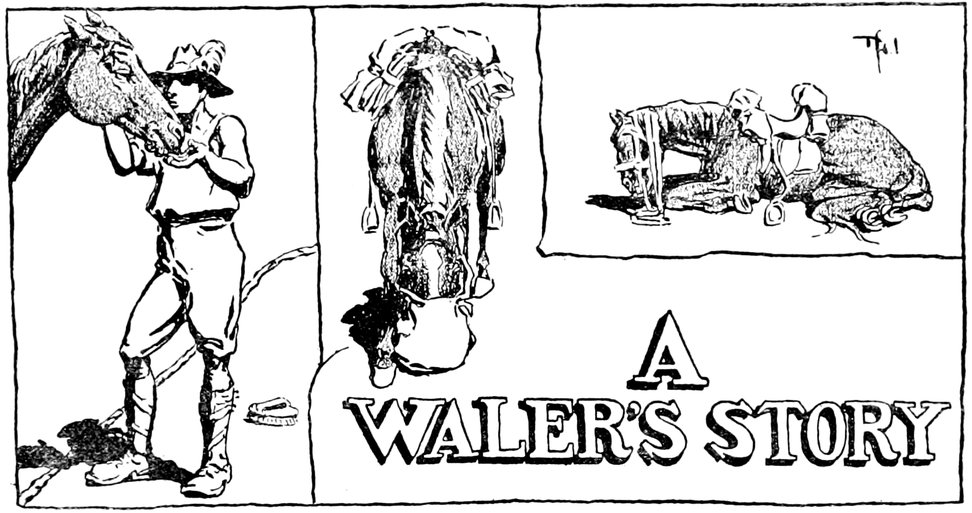
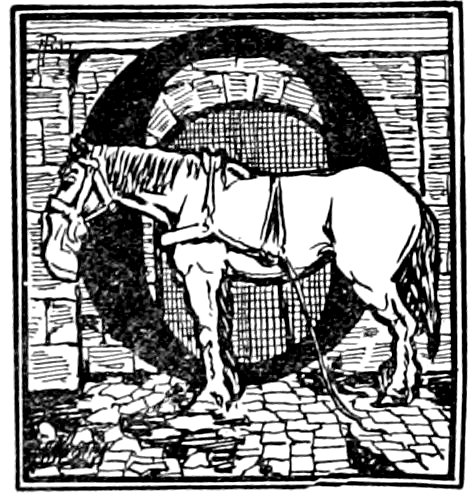
Of my early life I remember but little. I have a dim recollection of golden sunlight, of wide-sweeping plains, of a huge dam down by a homestead, of tall trees like some I have seen around Jaffa, and others with golden blossom, and of a long trip in a railway truck to Homebush—ah! you know the place?—where I was sold.
Since I have been in the Army my comrades have often taunted me with not knowing on what station I was born, and have called me a town-bred scrub; but I cannot help that. I will not bore you with details of my early career at Surry Hills as a “week-end” horse (I was then owned by a prosperous butcher), nor will I inflict upon you my first impressions of Army life at Moore Park; but I must say that I was at Broadmeadows, learning “Sections right,” “Form troop,” and “Walk march,” before they would put me in a unit.
On the 20th November, 1914, our troop was taken down to a big dock and put on board what our masters called a transport. (I have heard them call it a ship, a tub—and other names as occasion demanded). We horses had a rough time all the way across; and judging by the manner in which our masters cursed when they came to feed us and perform their stable duties, or to lead us about the decks for exercise, I think they had a rough time, too. I remember a remarkable incident on our deck when we were somewhere in the tropics. (If you know anything about the tropics and 72about ships, you will know how we and our masters existed). Ginger, who never wore anything to speak of except a pair of shorts, shoes, and a grin, looked after the horses on my off side; he also used to hitch baskets on to a long rope, which disappeared through the deck above. “Haul away!” was all he ever said, and the basket disappeared. Later, a voice would echo from above: “Under below!” and Ginger would stand well back until it landed again. One day when the rope slipped, the chap up above forgot to say “Under below,” and the big basket fell down on Ginger and extinguished him. When he got clear, his conversation with the chap on top was so unrestrained and vivid that three horses broke out of their stalls and tried to climb up on deck. I did not mind—I had often heard the expressions Ginger used.
We reached Alexandria at last and were taken ashore. At first I thought that a peculiarity existed in the ground of Egypt, for it kept rocking and swaying under my feet like the movement of the ship; but this feeling went away in two or three days. We were taken to Gabbari, put into trucks, and rattled to Ma’adi, a pretty little suburb of Cairo. At Ma’adi we had plenty of feed, good stables which kept the sun off us during the day, and very little work while the boys were away at the Peninsula. Sometimes we went out on route marches and dummy stunts, and always on Sundays our masters used to take us out on to the desert behind the camp, to gallop us until we were tired. Those gallops were great sport. There would be horses all over the desert, some of them with riders clinging affectionately to their necks, others without riders, and all of them thoroughly enjoying the fun, and kicking their heels playfully into the air. We were at Ma’adi right up till February, 1916, and then we were pushed off to Serapeum and dumped in a camp close to the Canal. After the delights of Ma’adi, Serapeum came as a shock to me; and in a few days I was feeling very ill on account of the sand I had swallowed with my food. I could not stand, so I rolled about in agony. Up till then I had never had a day’s sickness, so this experience was quite a new one. The farrier-sergeant visited me on the evening of my collapse, administered a “ball” to me, and told Bill (my boss) that I would be all right in the morning. A lot he knew about horses! He ought never to have left that boot factory. He also told Bill to give me a bit more berseem. Bill stopped with me for a while, talking; then a whistle blew and he cleared out. “Good-night, Baldy” (that is the name I always got) he said as he departed, “you’ll be O.K. at reveille.” In the morning I was almost better, and by lunch time, when Bill gave me a big feed of berseem that he had pinched from somewhere, I was as good as ever again.

5th LIGHT HORSE BRIGADE ENTERING NABLUS

WATERING HORSES, ES SALT
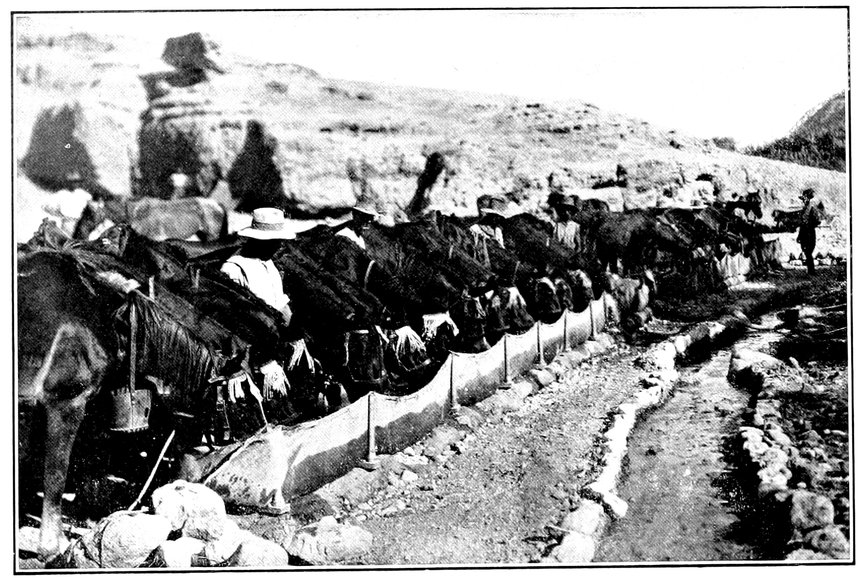
HORSES THIRSTY
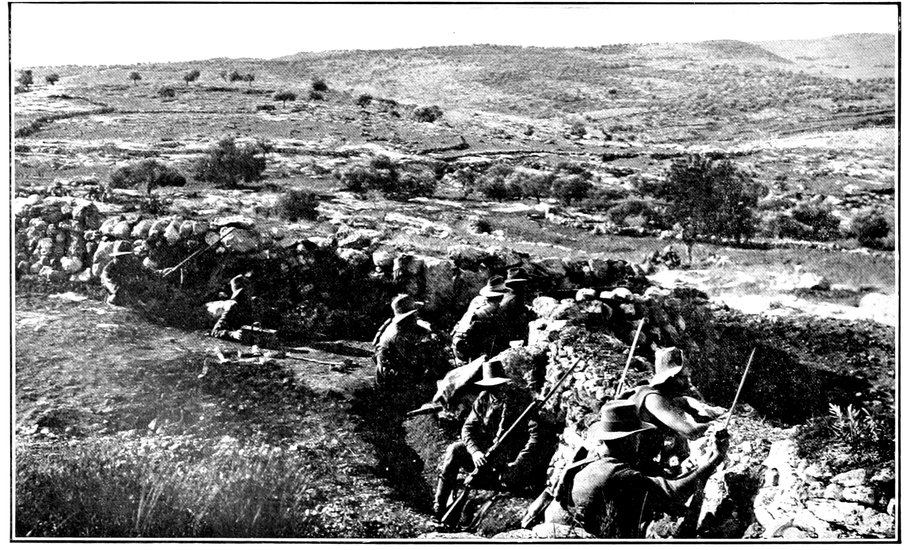
LIGHT HORSEMEN IN JUDEAN HILLS, JAN., 1918
75We had been at Serapeum only a few weeks when I was taken up to Salhia, where I was promoted on the strength (I think that is the term) of a new Squadron. Bill came with me, so I had no complaints to make—not even about the tibbin. Bill always was a good master, and he was never tired of looking after me. In heat, in dust, in mud; across the desert, over the plains, amongst the hills—anywhere at all—Bill always groomed me and saw that I got my full issue of tucker. We used to have long talks together; and I really think he understood what I had to say to him. He was always considerate in the way he loaded my saddle, and rather than sacrifice my bag of grain, he would dump his own gear. He could not do enough for me; and, believe me, I could not do enough for him. Unfortunately, all masters are not like Bill, or (pardon my vanity) all horses like Baldy.
My first real stunt was from Salhia to Kantara across the desert; and I think that it will live as long in my memory as that Amman show. We travelled all night by short stages—Bill would ride for ten minutes, then walk beside me during the next ten, and then we rested for ten minutes. I had a fair load on the saddle, but this was Bill’s first desert stunt, too, and he had not realized exactly how severe desert stunts can be. After that he always let someone else have the heavy gear, while he looked after the light stuff. That was in April, 1916. The long months from then until March, 1917, were one nightmare of bombs and sand, out of which our stunts—Romani, Bir el Abd, Mazar, Magdhaba, Rafa, and many minor ones—stood like the milestones I have seen along the roads at home. At the commencement of things in Sinai tucker was plentiful, and we waxed fat in the land and thrived on brackish water; now we no longer get the same amount—or so it seems—but the water is good. I did not notice the change until yesterday, when I had recourse to chew through my headrope so that I could visit the feed-heap while the piquet slept. Yet the change has been very gradual, and it has not been severe on me. I am still pretty sound in wind and limb, although I have seen old Bill look sorrowfully at me, and say, “Baldy, ten pounds of grain without fixings isn’t much to offer a man’s best cobber, is it? Never mind, old chap, we’re coping very well—very well, you and I.”
Once Bill was away for seven days; and when he came back I noticed that he was stable-guard for a whole fortnight. I thought it rather good of 76Bill to look after the horses for such a long time without a break. I heard all about it afterwards. Bill and the sergeant—a big, ugly bloke like a Gyppo—were talking near me, and I overheard Bill’s final remark. “Yes,” he said, “I’d be a stableman for a month if I could get those three days in Cairo again.” Ah, Bill! what were you doing? While he was away in Cairo we had a little stunt to blow up a railway line; and because I was a good worker, the big Gyppo bloke passed me on for the occasion. The chap who rode me was a dopey kind of individual, and, although the stunt was only to occupy thirty hours, he loaded me up with all sorts of gear, and forgot my lunch-bag. We came home in the night time in a fog, tried to find Tel el Fara, and circled about all over the place until I got tired of it, and wanted to make for home and a feed; but my dopey rider kept with the column, refusing to be guided by me. On another stunt, I just side-stepped the “Killed in Action” return by a hair. Jacko sent across a few shells in our direction, and one of them landed right underneath a horse next to me and sent him West. Two others were as full of holes as a colander, but we got them home. Strangely, the horses on my side of the burst were untouched, and merely suffered from slight shock.
The summer of 1917 was what Bill called a “snifter”—he also called it other things. Day after day, on those wind-swept, dust-covered plains of Southern Palestine, we stood in the heat and sweated from sunrise to sunset; during the night we shivered with the cold, and were wet with the dew and mist. Then there came rumours of a big stunt. It was good to hear that a big stunt was at last spoken about, not only because we got more attention prior to it, but because we would be leaving these sun-baked plains behind, and doing something towards earning our tibbin. It was on 28th October that Bill loaded my saddle, and rode me away towards Beersheba with the Squadron. From there onwards to Jaffa we dodged shells and planes, and existed on a very scanty ration. (Even Bill complained now and again.) We went without water on more than one occasion for sixty hours on end; and we had many weary night marches. Just after we left Beersheba I lost a good pal. She was following the General’s car, and had a despatch-rider in the saddle; and while doing a stiff gallop she stumbled, fell, and rolled over—dead. I think her death was due to lack of water, since she had had none for three days. She was a dear old thing, and I have yarned away many an hour with her. She died as I would like to die—a soldier.
Winter caught us at Jaffa, and the rain came down unceasingly day and 77night. Here I had a lot of trouble with our labour corps—the mules. They were a hungry lot of cannibals, and, not being satisfied with a ration of grain, they used to break away from their lines at night and eat our rugs. Some of them even gnawed the hair and tail off a sick pal of mine—he did look a wreck in the morning! Another inconvenience was that I shivered so much that I always shook the rug off, no matter how careful Bill was about putting it on. The early part of 1918 was a time of wind, cold, rain, rocks and mud, and stunts amongst tremendous hills. We had a most exciting time then, and I often wonder how it was I kept out of hospital. Later on, when we stopped in the Valley, I tried to “swing it” a bit, and succeeded in bluffing the sergeant; but the vet knew too much for me, and so I remained. Fortunately, we moved back to Bethlehem, where the bracing hill air, and the sight of the olive trees, made a new horse of me.
Our last big stunt was rather pleasant, as well as most profitable. (Bill agreed with me in that.) We again went to Amman, and this time captured all the Jackos in that part of the world; it was quite a different affair from that first Amman stunt, when I slipped on the muddy track and almost went overboard into a wady some hundreds of feet below. After we had collected all the gear which Jacko had left behind, we turned our heads west, came through Jericho, and passed up into the hills. We stopped for a day at Jerusalem, and then travelled down to the coastal plains near Jaffa. We returned to Richon to recuperate, and to await further developments.
Now our masters are talking of going home, and I hear them whisper in the lines—“Yes, they’ll remain behind”—“Ah! They’ve done their work bravely and well”—“I wonder what will happen to them?” Bill is going home; to-day he came to me and told me so. “Good-bye, Baldy, old comrade. You’ve been a good pal to me,” he said; and then he was gone. Here at Richon I would like to stay with Bill, and end my days. Richon, with its trees, its vines, its orchards, recalls my early life in some strange way; its fertile fields and pleasant surroundings make the desert days seem but a bad dream of long ago; and in its shady lanes, the toilsome hills and the rain, and the dust of the Valley, are forgotten. But Bill is gone! I must stay behind! Let them shoot me—and quickly—for I would go to that land of eternal sunlight, there to wait until Bill calls to me.... Then together we shall gallop for ever over the plains.


EVENING AMONGST THE JUDEAN HILLS
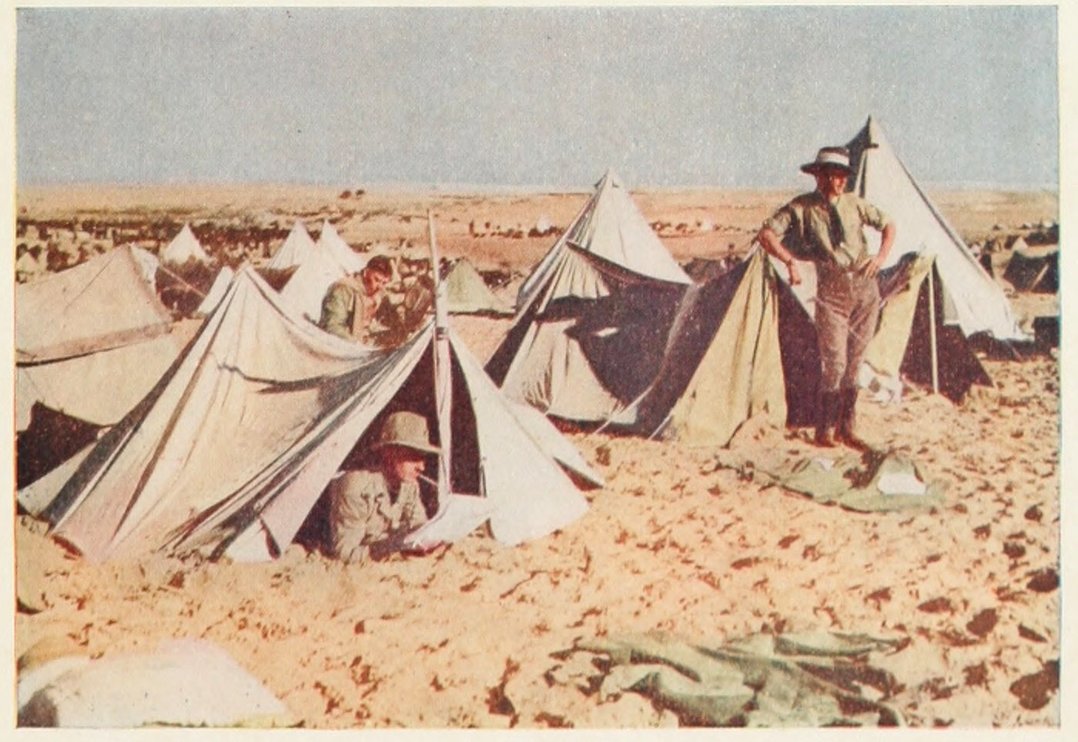
A CAMP IN THE DESERT
Photos, in colour by Capt. Frank Hurley
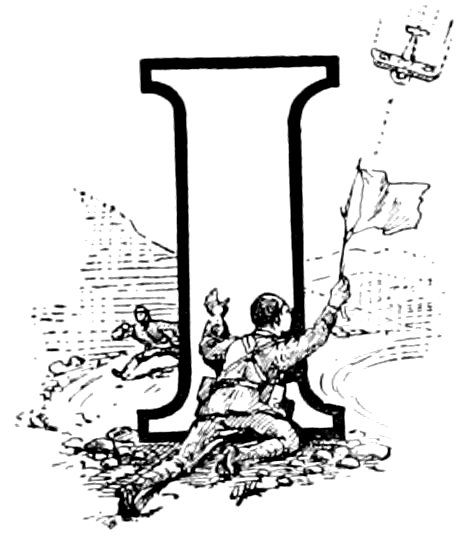
It was a hell of a night. Thunder enough to wake the “Jacko” dead, and raining fit to swamp old Solomon’s Pool. I was a good ten miles from camp, and it was with a dinkum bullocky’s curse that I swung into the saddle again and turned the pony’s nose for home. For about an hour we battled along, and then the supply dump at S—— hove in sight. Glad of a brief respite, I guided him toward it, and for a few minutes we rested in the shelter of a huge stack of tibbin.
The rain had eased off, and for a brief second a sickly-looking moon gazed down on things earthly. That was what started the trouble.
An Algerian guard was on duty, and, to the initiated, there is no need to say more than that. You might trick a Tommy or induce a Billjim to look the other way, but the man who beats an Algerian is going some.
But, as I was saying, it was the moon that caused the trouble. When she took that peep from behind her cloud bank she gazed fair on to four shadowy figures, each surmounted by a bag of barley and a felt hat.
Chuckling a little, she dodged behind the clouds again; but it was too late. The mischief had been done, and in a trice the “shadowy figures” found themselves surrounded by about a dozen sons of the Sahara and a like number of business-like bayonets.
The result was a confused babble of voices for ten minutes, and then a procession to the Supply Officer’s tent. From where I was standing I could see and hear everything that passed, and everybody seemed to be trying to talk at once. As the “shadowy figures” could not speak a word of Arabic, and the Algerians vice versa, the result was laughable. But with the advent of the Supply Officer things took a different turn. He had been wakened from a sound sleep, and was arrayed in the pink pyjamas the girl had sent him, and a desire to be “firm in the matter.” He had no knowledge of Arabic, and was placing the “shadowy figures” under guard pending the arrival of an interpreter in the morning.
That would have been serious for the said “shadowy figures,” so I decided to see whether I could help them at all. I had borrowed a cobber’s 80flash civvy raincoat in the morning, and that and the Jacko pony I rode must have made the S.O. think I was an officer. Anyhow, he greeted me very decently; and when I told him I could yabber Arabic pretty fluently, he was more than delighted at my arrival.
Well, for a good ten minutes I did the interpreter stunt, and then I got him to dismiss the guard.
Then I opened the case for the defence. I pictured to him the love of the Colonial for his horse, the long night rides, and a dozen other pitiful things, and altogether put up such a beautiful tale that even old Judge Jeffreys would have had to declare the accused “Not guilty.” So the S.O. decided to give the “shadowy figures” a stern lecture, take their names and numbers, and refer the matter to their O.C. next morning. Forth came the note-book and down went the particulars. I am pretty hard in the dial, but I was glad he was not looking my way then. For every one of the four had a number with six figures in it and belonged to the 19th Light Horse Regiment, 9th Light Horse Brigade.
Luckily, he was a new man out, or the bluff wouldn’t have worked. But it did, and that was all that mattered then. He gave them the lecture, and in it repeated often, “I’ve been one too many for you fellows this time, what!”. Then he let them go, and as they left the tent the last one winked at me, and in that wink there was a world of mystery.
Five minutes later I was in the saddle again and thinking hard. I was wondering where the “shadowy figures” had left their horses, and whether they would bump further trouble on the way home. Then I remembered a young wady that runs by the side of the dump and turned the pony’s head toward it. Half-way to it, I met them coming back. But where there had been four “shadowy figures” there were SIX, and where there should have been four horses there were ten. And the spare nags were loaded heavily, too. The chap who gave me the wink told me the rest of the yarn, and here it is.
Two of them had acted as horse-holders while the other four had carried out the raiding part of the business. Three times they had returned without mishap, and it was on the fourth trip that the moon peeped out and made a mess of things.
It started to rain again then, so we parted; they to their bivvies and I to a sharp trot home.
Two hours after the sun came up, the chap who was “one too many” rolled out of bed and prepared his report for the O.C. 19th Light Horse Regiment, 9th Light Horse Brigade.
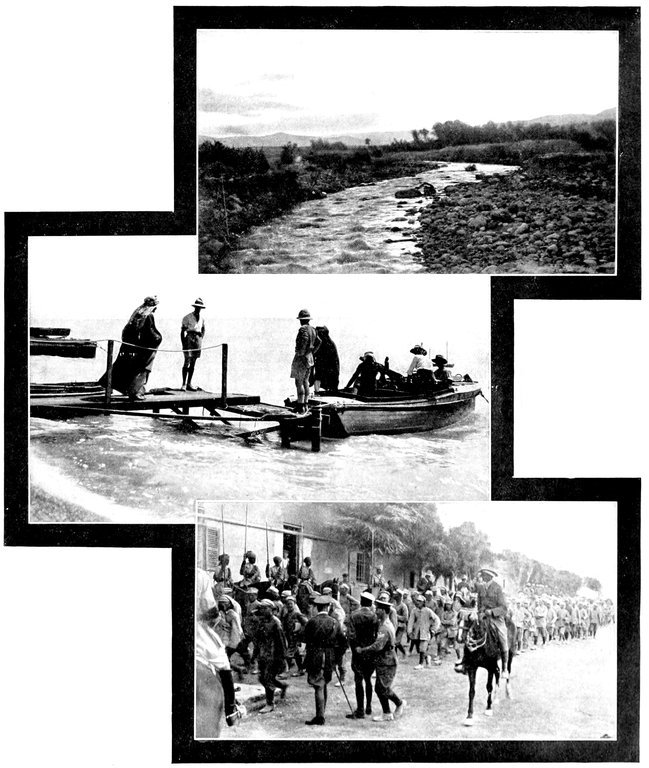
[top]
WADY NIMRIN
Along whose banks the A.L.H. had many sharp fights
[middle]
ARAB AGENTS ARRIVING FROM A TRIP ACROSS THE DEAD SEA
[bottom]
GERMAN PRISONERS IN JERICHO
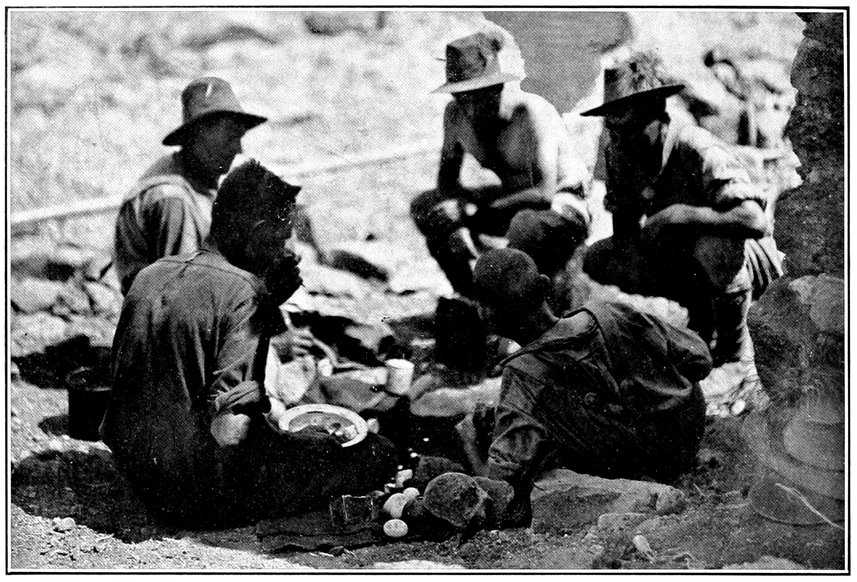
MEAL TIME
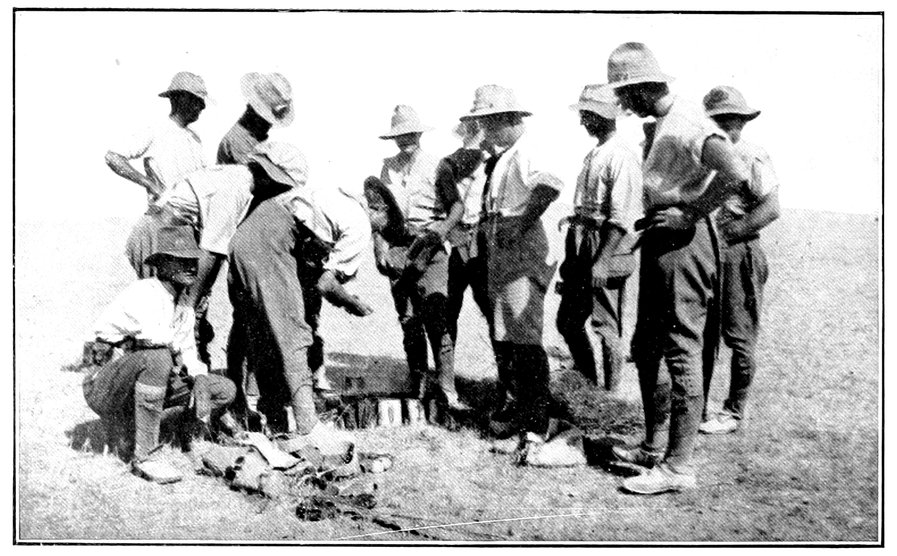
“SHE’S BOILING”
Among the many examples of ingenuity displayed by Billjim on service, the manufacture of illuminants, if you will pardon the prolixity, shines out the most brilliantly. The Sun itself is considered to be a pretty perfect and economical source of light, but it is not infallible. The annoying habit it has of dodging off about sundown excludes it from the category of the perfectly perfect, and Billjim is forced to procure a substitute to enable him to relieve the tedium of his evenings with the exhilarating influence of two-up, poker, swapping yarns and other harmless pursuits.
The issue candle is, of course, the recognized form of illuminant; but by the time the Greatest, the Sub-Greatest, the Q-Emmer, the Orderly-Room Ogre and the Sigs get their cut, the stock is usually depleted to a mere skeleton of its former fat self, and the insignificant stump that is left to shed its radiance around the humble bivvies of the rank and file, is, as often as not, irretrievably lost to sight owing to the shortage of telescopes in the unit’s equipment. Hence the exercise of Billjim’s ingenuity.
Some devices were truly efficient, others resembled the seeds that fell on stony ground; while one I know of was positively dangerous. The one in question was disapproved of from its very inception. The wise ones shook their heads dubiously, and opined that it was sheer flying in the face of Providence to use one’s issue of rum for the sacrilegious purpose of making air-gas for a blooming light. After the explosion occurred, and the blasphemous one was struck off the strength, they said, “I told him so,” and everybody was satisfied.
The most popular form is the slush-light, which is simply composed of any old thing that will hold grease, and any kind of grease that will fit into it; first, a layer of sand or clay is dumped into the jam, milk, cigarette or other tin; then a wick made of “3 x 2,” or issue flannelette, wrapped around a thin pine stick, is stuck upright in the middle of the sand or clay; and finally the grease is introduced, the quantity being governed by the 84amount one has been able to acquire. It is on record that some chaps have had the effrontery to use dubbin, yes, “dubbin!” but, of course, this is not official, just common furphy.
Next to the slushie comes the bottle-o; but to employ this it is necessary to have the above-mentioned rarity, candle. For candle one is not wholly dependent on the “issue” brand, for it has been known to be purchaseable at the canteen—when those institutions are in the vicinity. Supposing the possession of candle to be an established and material fact, the next necessity is a clear-glass bottle; old lime-juice bottles are excellent, and they can be found outside any officers’ mess, or the messes of troopers who “did a trot.” The bottom of the bottle is knocked out by insistent but vigorous tapping with the marlin-spike of a jack-knife till a hole is broken through, and then the rest is chipped off in small instalments till the end is quite out. The candle is then pared at the bottom end to fit the slope of the bottle neck, and a deep groove gouged in it, the candle, to admit air. Apply a match to the candle, drop it into the inverted bottle, and there is your light. If it is not very windy, of course, all that is necessary is to drop some melted grease on someone else’s tin hat, and stick the candle in it; simple, isn’t it?
There are a few of the lesser Edisons who eliminate disturbance by wind by curling a legging around the candle; but only a very narrow chink of light exudes from its gaping edges, and the odour of singeing leather is not pleasant.
One of the finest ideas was a combination of the slushie and the bottle-o. A squat chutney-bottle that fitted snugly into a toffee tin, was found, and the quality and steadiness of the light generated made drawn filament look painfully experimental. Some wire tibbin bands secure the “globe” to the body, at the same time forming a handle.
The designs, elaborations and embellishments of the original idea are practically numberless; they range from the primitive cremation of a religious aunt’s epistles and incriminating love effusions up to the princely slushie-cum-bottle-o; and they radiate in all classes of bivvies, and shed their glory on the tangle of the newly erected as brightly as on the white-stoned splendour of the resident.
With these remarks, and any necessary apologies to the Dinkum Military Scribe, I shall leave them to shine on the just and the unjust, like their mighty lord, the Sun.
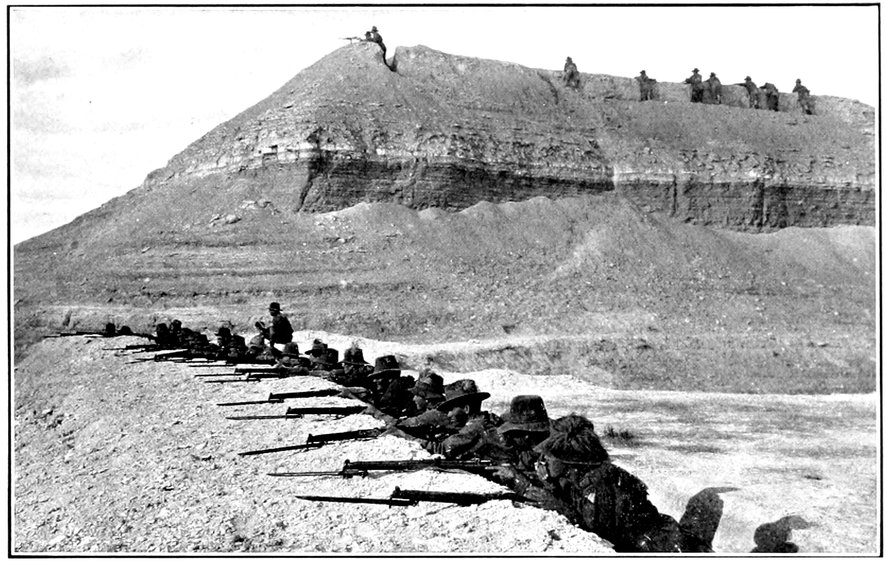
DEFENCES IN THE GHORANIYEH BRIDGEHEAD

THE BRICKMAKER
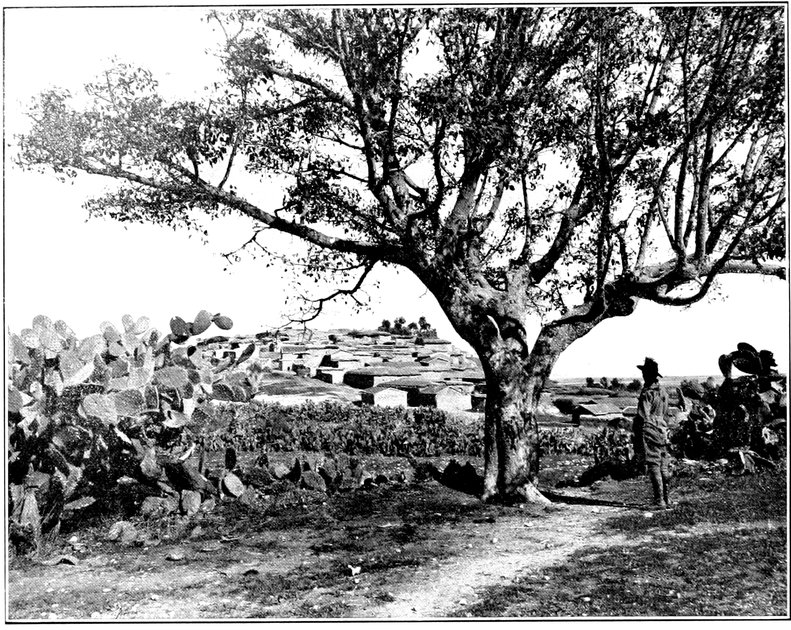
A TYPICAL ARAB VILLAGE
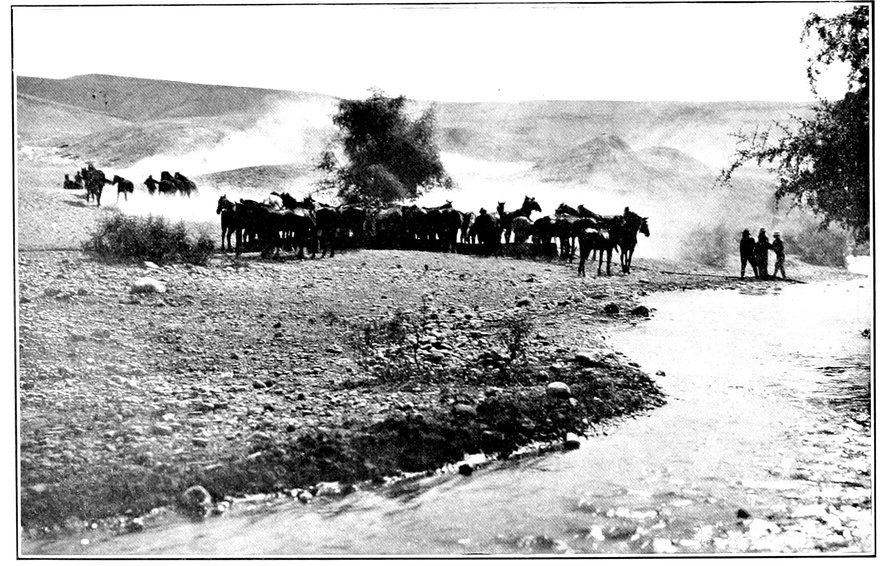
4th LIGHT HORSE BRIGADE WATERING HORSES AT THE JORDAN
At twilight, when the air is cool, we prepare for our second consecutive night march. Overcoats and mufflers are put on, saddles are inspected to see that all is secure. Later it will be too dark, and we too tired to attend to such matters.
After a short wait we move off. Two to three hours steady plodding through the darkness, with the effects of fatigue scarcely noticeable. Then, suddenly, an utter weariness assails us, numbing limbs, distorting vision, and rendering minds a prey to tantalizing and disturbing thoughts—thoughts that mock and taunt; thoughts of feather beds and roaring fires; thoughts that accentuate our weariness and awake us to the realization of the cold.
We ride, with drooping eyelids, a swaying body, and a precarious seat, surrendered to the inevitable.
The column halts, and simultaneously we fall forward on our horses’ necks, hoping to ease our aching limbs. Hoping against hope to hear the order to dismount. A jerk, our horses move forward again, and disappointedly we resign ourselves to the further delusions of minds tortured from want of sleep.
Visions become distorted, we visualize the objects of our thoughts. A thought of water, and the road becomes a flowing stream. Thoughts of horses and trees, and in the darkness arises a village—a village that remains ever in the distance, and endures only so long as our thoughts are of villages. The horse ahead moves strangely; it appears to be dancing, and has taken unto itself the shape of a beast of prehistoric ages. By an effort of will we shake off this state of semi-somnolence, and, for a time, see things in their normal shapes again.
At last, the order to dismount. Tumbling off we throw ourselves down at our horses’ feet, indifferent to our position and its possibilities. With heads pillowed on arms, water-bottles or haversacks, we endeavour to win a few minutes respite. Follows sleep and blissful unconsciousness, until friendly hands awake us, and wearily we rise to a repetition of the last hour. On moving off some walk and lead their horses, stepping out 88briskly in an endeavour to dispel the ever-increasing drowsiness. It succeeds whilst walking, but a reaction sets in on regaining the saddle, leaving the walker in worse plight than ever.
With nerves on edge, we curse the numerous and apparently purposeless halts, become uncomplimentary about our leaders, revile horses for jogging and stumbling, warn companions of the damage they are likely to do if they persist in being careless with their rifles. Cheerful and good-tempered soldiers are few at 03.00.
And so on until we hail with relief the approach of dawn, which dispels the hallucinations of darkness.

ROMAN FORT, JERICHO
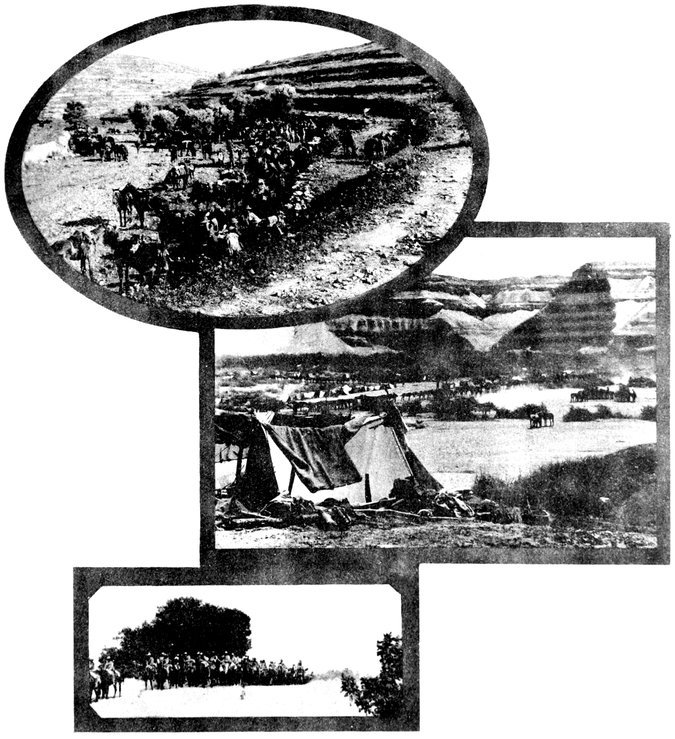
[top]
HORSES UNDER COVER
[middle]
A. L. HORSE IN CAMP
[bottom]
2nd A. L. H. MARCHING THROUGH KHAN YUNIS
Amidst the universal joy—booming of guns, ringing of church bells, cheering, and the screeching of ships’ sirens—I am gloomy and ill at ease. I cannot share in the thanksgiving and tumultuous welcome of Peace; my mind is dark with foreboding, oppressed by thoughts of three things that have made so many happy lives miserable during the Great War.
With the knowledge that huge stocks of dubbin, bully and biscuits are on hand, how can a chap be joyful? They must be disposed of—not cast into the incinerator—and thoughts of the woe that they will cause make me sorrowful.
The war has ended, and with it the need for dubbin. Stacks of the beastly stuff must be disposed of before we are demobilized. There is no market for it, and nobody would take it as a gift. Offer it to a Light Horseman or a driver, and you would see stars not of the firmament. But I’m sure that The Heads won’t let it be wasted. It’ll be read out in orders soon, that all saddlery and harness must be anointed with dubbin once daily and twice on Sundays. There’s a good time coming!
Bully and biscuits are even dearer than dubbin to the granite hearts of Q.M.’s, but they’ll have to issue them now by the ton. Rapid consumption is the only way to get rid of the pyramids of B and B left on hand through Fritz throwing in the towel sooner than the Supply Office anticipated.
Army biscuits are beyond the capacity of Gyppos and Bedouin; if we strewed them broadcast over Palestine, they would lie there untouched, and ruin all agricultural prospects: even a stump-proof plough would crumple up if it struck an army biscuit. We can’t dump our stocks in the sea: think what would happen in a collision between a liner and an A. B.! No; we’ve got to eat the lot, empty every tin of bully and biscuits, and take the consequences like heroes.
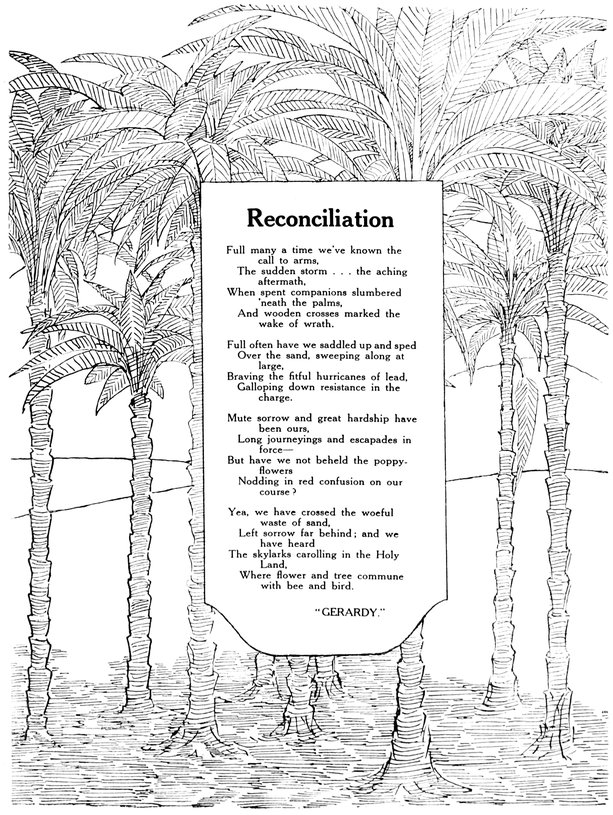

“The mail’s in!” The glad tidings are tossed from lip to lip and shouted down the lines, outstripping, and for the time suppressing, the current furphies, “Furlough to Australia,” “Peace Negotiations,” “A big Stunt,” and similar creations of the idle imaginative mind.
“There’s a mail in!”—A magic wand has been waved above the troops by an unseen hand and weariness and even sleep are banished from the war-worn soldiers. Even the sick are interested, and their eyes light up with an eager look of expectancy.
“There’s a mail in!” The chronic grouser forgets to grouse, the lead swinger lays aside the lead and, for the time, his petty pains, and they join the eager throng around the perspiring orderlies who are struggling with the jumbled mass of letters, papers and parcels, bringing chaos to order, sorting mail into squadrons and then into troops, ere it can be distributed.
What a study are the faces of that watching throng; what a joyous gleam leaps into the sleep-laden eyes of a tired youngster who has caught a glimpse of a letter addressed in the well-known hand of the mother who waits at home.
There is a youth just from school, who has not yet tasted the mad joy of battle, of a ding-dong mix up, when death shrieks through the air missing one by inches, by hairbreadths. Here, too, is the war-hardened warrior, who knew Anzac before the Suvla advance, who has met, fought and beaten the Turk from Romani to Jericho, the hero of a hundred fights, of scraps fought out on lonely patrol, that the world knows naught of, though to the individual they are more fraught with peril than a big battle.
To soldiers mail day is a day of bliss. Recruit or warrior, their faces portray the emotions that are surging through their breasts. Their eyes 93grow bright with eagerness as they watch the pile of mail assume shape and order under the deft hands of the postal orderlies.
Men moving out on outpost or patrol shout to their mates, “Get my mail, Jack,” “Get mine,” and ride off casting longing eyes at that waiting crowd; with joyful hearts they move out into the night, to outwit the enemy or return no more. But what care they—for it is mail day!
Before dawn, outpost and patrol return, weary and with sleep-laden eyes. They off-saddle and picket their horses, and dash into the bivvies for their mail. Matches are struck surreptitiously, candles are lighted and hidden by blankets, for lights are forbidden when in touch with the enemy; and thus are the letters eagerly read. Often Billjim falls asleep from sheer exhaustion, the last letter still clutched in his hand, and dreams of his Australian home; the fragrance of gum and wattle blossom are wafted to him from overseas on the cool night breeze.
Mail day, the most joyous and most tragic in a soldier’s life, brings messages of love and trust from dear ones, messages of faith and praise from friends; and at times news that is sorrow-laden.

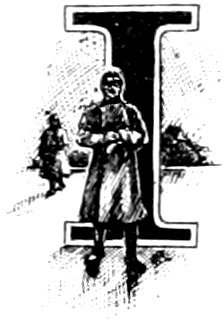
In the language of the Corps, “there was something doing,” for from dawn till dark machines had been coming and going on the aerodrome almost without a break; in fact, it was “some day.”
Just as the first grey streaks of dawn crept over the horizon the roar of a couple of hostile aircraft patrol machines taking off woke an otherwise peaceful camp. An hour later the orderly officer was bustling round two more machines, which were to leave on the early morning reconnaissance of the country behind the actual scene of operations and along the Turkish lines of communication, to search for any signs of fresh concentrations or reinforcements being hurried up.
At two hour intervals machines left in couples to patrol above our lines and prevent any possibility of Boche machines sneaking over, either to watch the movements of our troops or to bomb them; for, during a stunt, it was just as important for us to keep the Hun blind as to keep our own eyes well skinned.

To me fell the first patrol, and a call from the Orderly Officer at 3.30 a.m. was not received with the utmost courtesy. After hot tea and toast by candle light, we scrambled into warm leather coats, woollen-lined boots, gloves and helmets, and climbed aboard. By the time I had inspected my guns and the usual contents of the cockpit, the engine was ticking over and we were ready to start. It was still dark enough, as we took off, for the pilot to need all his lamps alight to see the various instruments, and, as we climbed, the crisp morning air set our blood tingling with the joy of living. When above the clouds at about 8000 feet the first rays of the rising sun shot across the sky, and very shortly the clouds, which until then had been snowy white, were bathed in a crimson glow that held us spell-bound with its beauty. Primarily, the crests of those billowy mists were tipped as with a wand of fire whilst, as we ascended into space and the sun gradually rose above the horizon, the colour spread over that sea of cloud until it appeared like a stupendous stream of lava belched forth from some volcano which, after years of quiescence, had suddenly burst into activity.
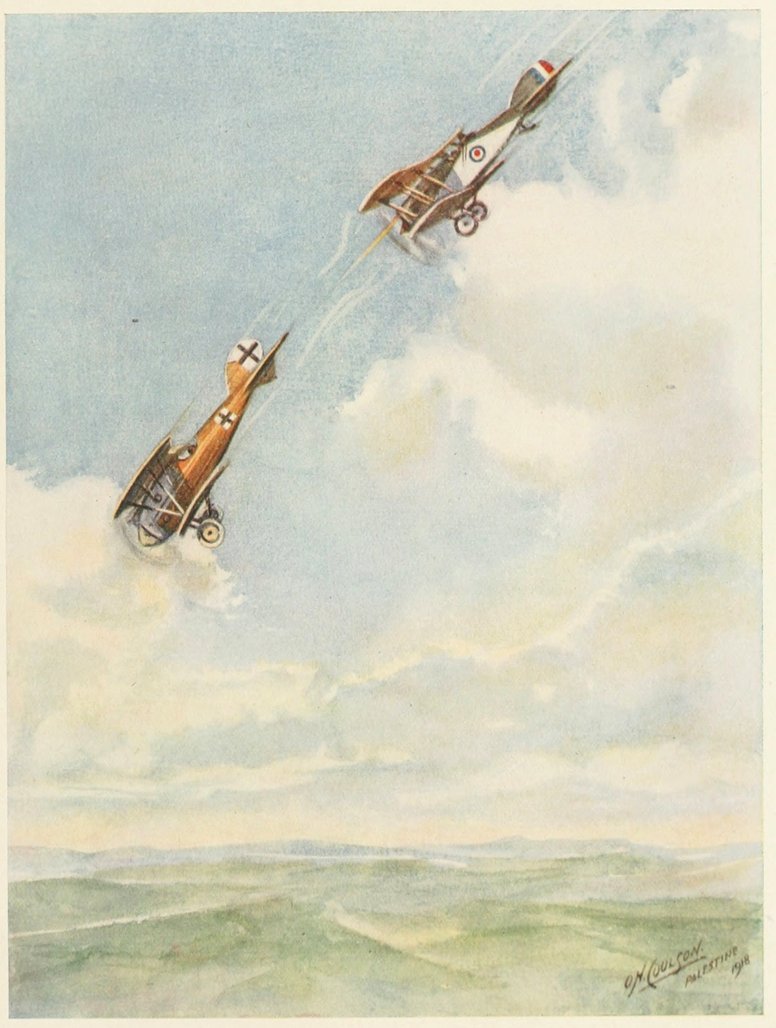
GOT HIM COLD
By Lieut. O. H. Coulson
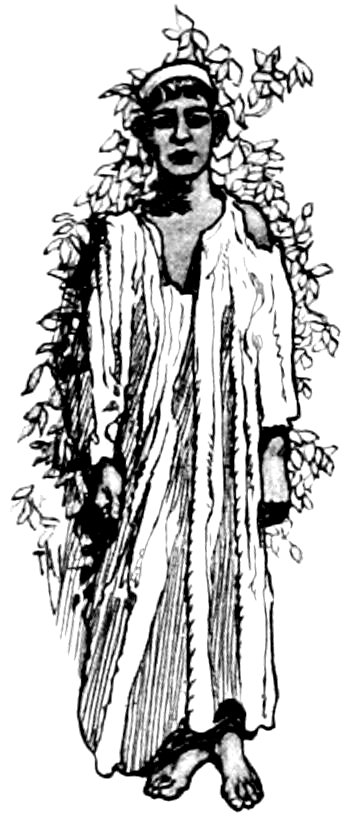
I have seen many sunrises under varying conditions, sunrises at whose beauty I marvelled, but never before had I witnessed anything that could come within coo-ee of the riotous blaze of colour that lay spread beneath us, covering the Holy Land, as it were, with a cloth of gold. It disappeared from view, however, all too soon, for, as the sun gained in strength and we in height, the colour slowly faded from fiery brilliance to a delicate pink until, finally, the clouds once again showed up in all their glistening purity.
It seemed impossible to realize, whilst nature was all aglow beneath us, that war was being waged with all its relentless cruelty, that guns were sending forth their messengers of death and pain, and, above all, that we, who had been privileged to witness the glory of God’s handiwork, were scanning the heavens for something in the way of Hun airmen to kill. To me it seemed a sacrilege that, on such a glorious day, hate should be animating the hearts of men, and that I should be a willing agent, eager for an opportunity of sending a fellow-mortal crashing to earth and death. The Hun, however, evidently deeming discretion the better part of valour, did not put in an appearance, and when, after three hours’ cruising up and down the lines, we returned to the aerodrome, I believe I was pleased that I had not been, by force of circumstances, compelled to share in sending some creature to meet his Maker.
So, throughout the day, the work went on, and, as a Hun “bus” was reported to have bombed our troops in the early morning, every one of our machines thereafter carried four bombs to drop on any suitable target that offered itself.
Whilst on afternoon reconnaissance, the observer located a large body of enemy troops, and, immediately on receipt of his report, a bomb raid was ordered on which every available machine was to be sent. Luckily, I was detailed for escort duty, and it was a pleasant experience to watch the bombing machines assembling overhead, as they arrived from the different 96aerodromes, and took up the allotted formation. About 5 p.m. the leader fired his light and thirty machines, like a flock of great birds, set off on their journey to play havoc with our old friend, the Turk. After dropping the bombs, all machines swooped down on the troops and used their spare machine gun ammunition in shooting them up and generally giving them a devil of a time.
All good things come to an end, and, finally, we set out for home, which we reached just as the sun, a ball of fire, was sinking to rest. The machines, glistening white in the reflected sunlight, resembled a flock of swans coming home, as, in slow, stately circles, one by one, they glided to earth. The Mediterranean, as calm and unruffled as a mill-pond, reflected the glory of the sun until its surface glowed like a sheet of burnished gold. By the time we, as escort, had seen the last of our charges land in safety and commenced our own descent, the sun was well below the skyline, and the narrow ribbon of the pink afterglow that skirted the horizon was all that remained to remind us of the sun and its glory.

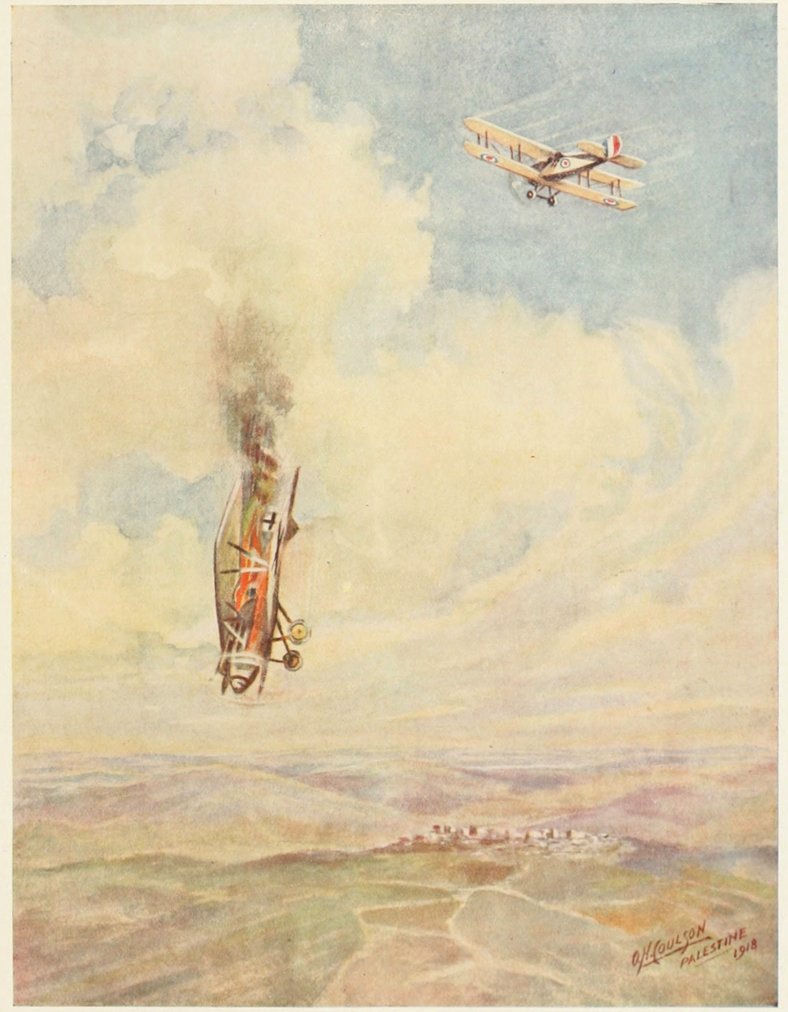
THE END OF THE SCRAP
By Lieut. O. H. Coulson

TURKISH PRISONERS AT ES SALT

JERICHO
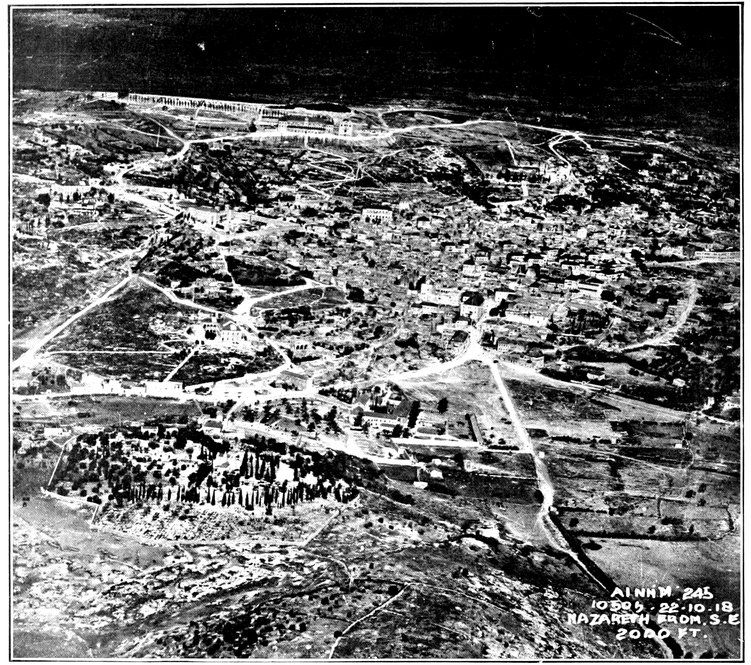
NAZARETH FROM THE AIR
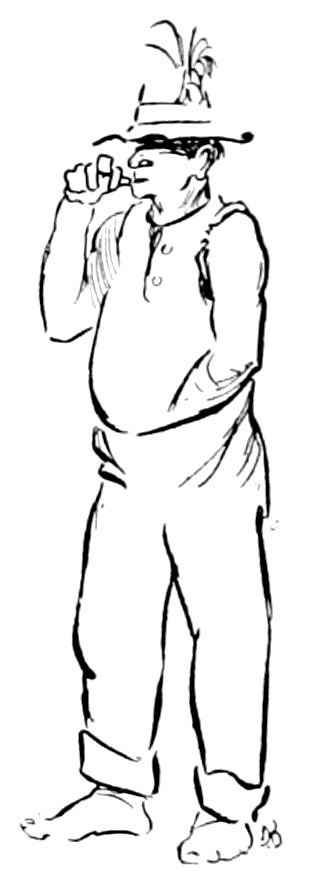

On my arrival at the Unit, I considered myself fortunate when the corporal presented me with a fat, sleek remount, only lately up from the Base. My suspicions were not aroused until, preparing to mount, I discovered what an enormous supply of cameras the Troop possessed. All classes seemed to be represented, from the V.P.K. pip-squeak to the ponderous P.C. “Jericho Jane” variety. Maintaining a professional attitude, I mounted.

In my youthful days I’ve paid two shillings to see a horse perform evolutions and gyroscope stunts not to be compared with the tricks that animal unearthed. I had an irresistible tendency from the first to fall off over the place where, in normal times, his head and neck should have been. Finally, yielding to impulse, I descended to good Palestine mud amid the shrieks of an ill-mannered crowd. Some imbecile sauntered up and said, “By jove, matey, if you could only have stopped up another five secs. I would have had one of the best snaps in the Unit.” I wouldn’t trust my reply to a green envelope. The sergeant remarked that horsemanship didn’t seem to be my forte, so I informed him that my marching-in papers proclaimed me a flag-wagger, not a Bronco Buster.

“Right,” said he, “take Maaleesh.”
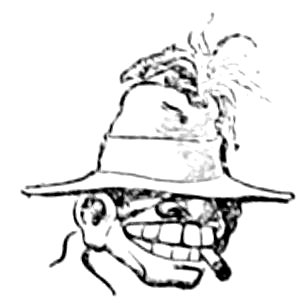
I took him, for better or for worse, and went to make his acquaintance. That horse didn’t belie his name. Maaleeshness fairly radiated from him, from his huge, out-of-proportion head that an A.S.C. mule might envy, to his stump of a tail, the missing part of which had provided food for a hungry moke on the Jaffa stunt. What was left of it provided me with food for reflection.
He wasn’t a bad horse. As the Troop farrier said, he had no vice in him. The trouble was, he was as devoid of energy or grey matter as he was of vice. He progressed at a lumbering shuffle, with his head low down after the manner of a cow-catcher on a locomotive. He had also acquired a taste for feed-bags, and was blessed with a very good appetite. 100Every time I fed him he disposed of tibbin, grain and nose-bag. The day before we went on the stunt Maaleesh contracted Spanish Influenza, and on the vet administering that panacea for all equine ailments, a ball, he barracked and refused to move.
Then I was handed over to the tender mercies of “Lofty.” The lancejack, who knew a bit about horses, confidently informed me that Lofty was one of those horses that never carry much condition, and he knew a horse at Cunnawulla.... I hastily agreed with him, especially the former part of his statement. We looked at Lofty, who favoured us with an apathetic stare. If the third generation theory is correct, Lofty’s granddad was a camel. Going through a neighbouring town I was No. 1 of the section, and being of a sensitive nature, it hurt me to see the people laugh; but Lofty appeared indifferent.
The first day out he chewed up two signal flags and all the straps on my mate’s gear. Half-way through the stunt he faced the East, struck a prayerful attitude and, with a don’t-give-a-hang-if-you-shoot-me-I-won’t-move expression in his eyes, prepared to rest. Our sergeant shot him, whereupon he displayed more agility than anyone had hitherto thought he possessed, and gambolled off over a ridge. A sympathetic New Zealander recaptured him, but took warning from the black looks and wild gesticulations of the mob. Shortly afterward a report was heard. Lofty’s soul had gone West. Visions of the photo I intended to send to my best girl, of my illustrious self mounted on a fiery charger, faded into oblivion; and as I transferred my trappings to a spare mule, I vaguely wondered, from force of habit, what characteristic and peculiarities my new mount possessed.
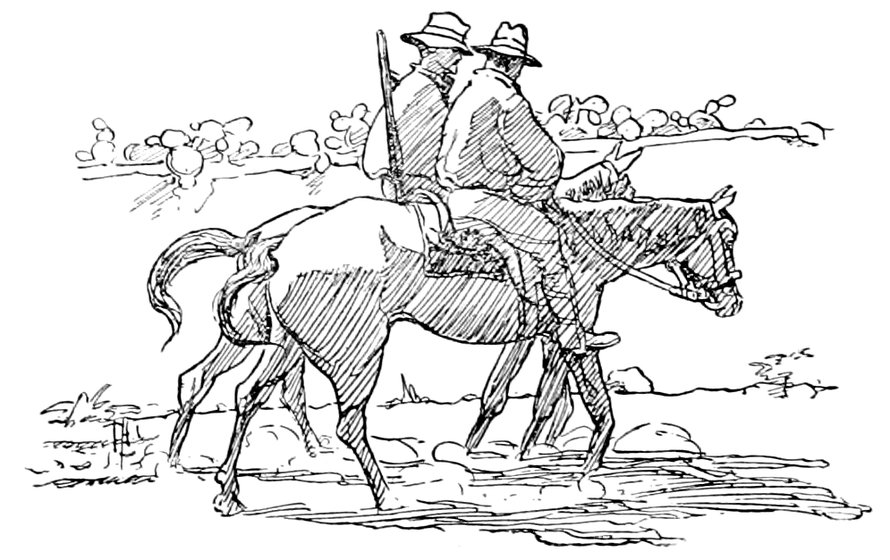
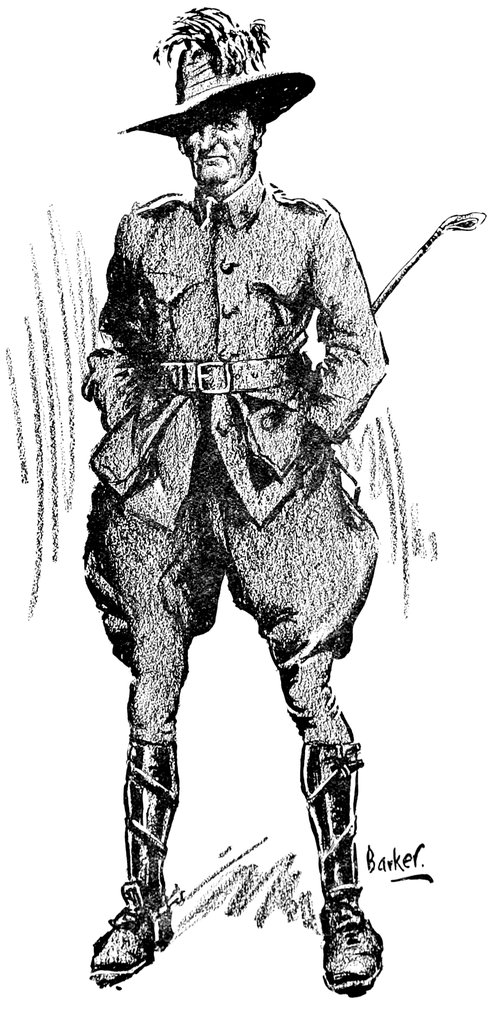
“A LIGHT HORSE TYPE”
By W. O. David Barker
The Army Medical Corps is a chain of many links. Let the lay mind which has condensed its conception of the Corps’ duties into “picking up the wounded,” reflect upon an interwoven organization of Base Hospitals, Convalescent Homes and Rest Camps; Auxiliary Hospitals, Isolation Hospitals and Dermatological Hospitals; Stationary Hospitals (which are liable to move about) and Casualty Clearing Hospitals—we are working up the chain from the back to the front—Motor Ambulance Units and Hospital Trains and Hospital Ships; Divisional Receiving Stations, Field Dental Units, Field Operating Units and Field Laboratories (these all hear the firing of the guns); Field Ambulances (which comprise within themselves Field Hospitals), Dressing Stations and Advanced Dressing Stations (these get bullets through their tents and shells in their bivvies); and, end of the chain, the Medical Blokes with the Regiments. They are the last link; they are the tip of the longest tentacle of the Medical octopus. Truly, modesty forbids me from adding that they are the sweetest violet in the bunch.

The Medical Blokes are detailed from the Ambulance at the rate of an N.C.O. and one man to each Regiment. Thereafter they become part and parcel of that Regiment; live with it, move with it, minister to it; share its trials, troubles, tribulations, triumphs and rum issues. Nevertheless, in cold, official fact, they still belong to the Ambulance, being upon its supernumerary strength—“attached for duty and discipline to the Xth Regiment.” This little complication has its unsuspected advantages, for it sometimes breeds in the mind of an R.S.M. a shade of doubt as to exactly how far the Medical Blokes come within his jurisdiction, and he is constrained to permit them a certain independence of existence and exemption from routine. They obey “Reveille;” they approximate their appearance on the horse-lines, to groom, feed and water, as nearly to the Regimental schedule as the exigencies of the medical service permit; they generally manage to scratch an instant to be present at the cook-house at meal times; at the Quartermaster’s bivvy when he is doling out rations, and at the Orderly Room on pay-day. Their liabilities discharged, they are left 103free to order their time as they please. They are usually to be found lurking in the medical tent, though they sometimes go to earth in a bivvy pitched somewhere in its vicinity.
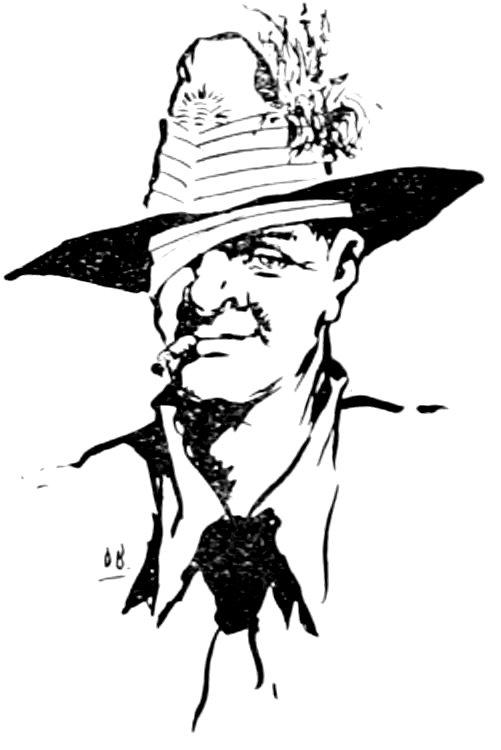
In addition to the two above-mentioned stalwarts, the Regimental medical establishment carries a Medical Officer and an offsider, a trooper of the Regiment, detailed for the job, who, in course of time, is likely to become so imbued with the spirit of his surroundings that he is not to be distinguished from genuine Medical Blokes themselves. Nominally he is intended for water duties; to carry out daily at the area drinking-water supply the mysterious rite (known to the uninitiated as “chlorinating” and to the rank and file as “poisoning”) by which the further existence of cholera and other germs in the water is discouraged. He is the man responsible for making the water taste as if there were a very dead camel lying a hundred yards further up the stream whence it was drawn; while tea made with it always seems to have been cut with an oniony knife. Yet he deserves a certain amount of pity. If he over-chlorinates, the whole Brigade will blaspheme him and his activities; if he under-chlorinates, Medical Officers accuse him of encouraging epidemic; and the happy medium of chlorination is so deucedly elusive that he never strikes it!
By way of transport for their chattels the Medical Blokes have a cart, called Maltese, a square contrivance on two wheels and no springs, drawn by three horses abreast. You can pick it out on the road at the tail end of the Regimental transport in company with the water-cart. It is invariably overloaded with what looks like a lunatic’s purchases at a bargain auction sale—or somebody’s goods undergoing a back street removal—baskets, bottles, barrels, boxes, bedding, brushes, blankets, bivvies, buckets, to say nothing of all the things which begin with other letters of the alphabet. The driver of the cart is not a Medical Bloke; he is a Philistine from the transport lines.

There are cinema-and-picture-nourished imaginations at Home who fancy war as one unending, crimson, bloody pageant of battle, whereas it is merely a different sort of humdrum existence from their own, with occasional violent patches of excitement. Also, they worship the A.M.C. man as the Red Cross Hero of the Piece, whereas ... never mind. But you will grant me that, of all the A.M.C. personnel, the Medical Bloke gets nearest to the heroic rôle. He shares the hazards of a fighting unit; he is an all-but combatant. When the squadrons go out to fight he sloughs 104all his bulky baggage, puts gauze, wool, bandages, iodine and scissors into his haversack, and follows. Comes at dawn—we have branded dawn for ever as the battle hour—a moment when a ragged, scattered line of men begin to walk forward up the gentle slope of a low ridge. This is attack. The split and scatter of shrapnel, the hiss-bang-crash of H.E., and z-z-z-en of flying fragments, make death a chance in the shallow gully. But the top of the ridge is the edge of open, machine gun-swept country. It is a hundred yards to the crest—and death for someone. This Medical Bloke, the wind well up, has shrunk himself into a crevice and waits for a call. He desires nothing better than to stay there. He watches the men walking up the slope—such everyday, wise, silly, plain, good, bad, smart, childish men—just simply walking up the slope. And in that moment our Medical Bloke realizes that they are better men than he, because they are walking up that slope of which he is afraid. Are they better? He is walking, rather slowly, up the slope now. He runs a few steps and drops behind cover on the crest, and waits for the need that will call him. Fate grants him a few minutes’ spell, and then puts him to the test. “Stretcher-bearers!” they cry to the left. The Medical Bloke can see two men bending over the third, and he faces one of those decisions which mould character. Quite properly, he may wait until they carry the man to him, behind cover (there are troopers whose hazardous duty it is to act as stretcher-bearers), or he may walk out and help. He walks out as steady as he can; it is quicker and ... well, what peculiar right has a Medical Bloke to the safety of cover when the men are “out there”?
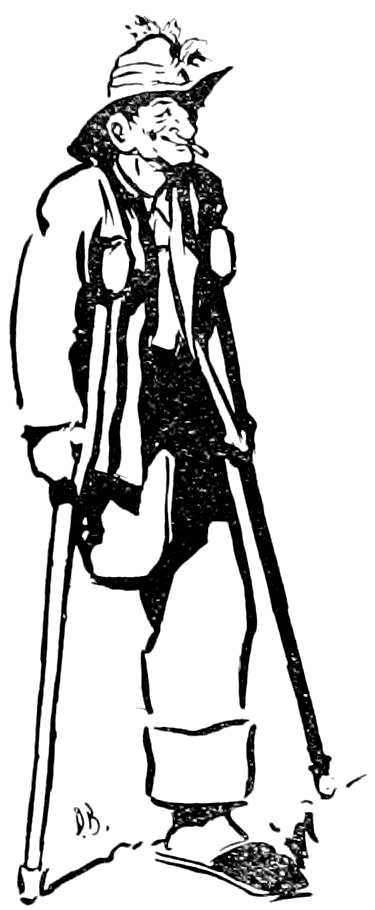
It is little enough can be done in action for the wounded; to cut away the blood-clotted clothing, to clap a rough dressing of iodine and gauze on the wound, or a crude splint on a smashed limb; to get the man to comparative cover, to rig some sort of a shade over him and to give him water; and then to wait—for the M.O. to come with the skill that soothes and the hypodermical needle of comfort. But the bitterest game of patience on earth is played when the tide of battle fails to flow onward, and the wounded lie all the livelong, sun-tormented day in the fire-swept zone, and the Medical Blokes can only watch and wait for nightfall to give safe-conduct to the ambulance carts or the camels, with great, unwieldy, white cacolets, which come to carry their poor shattered charges to sanctuary.
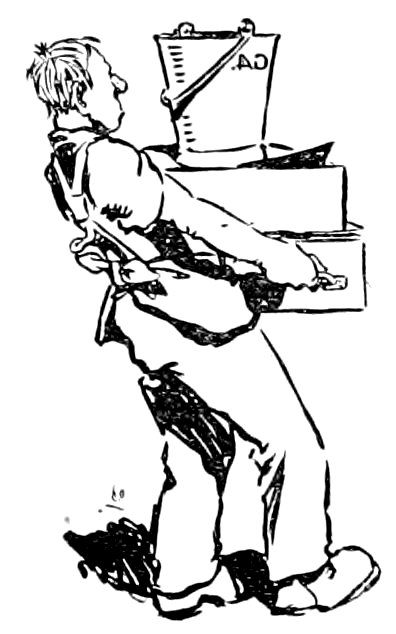
Believe me, romantic reader, that I will now reveal the true raison d’être of Medical Blokes; the nature of their life-work, their excuse for existing. It is not, bless you, ministering to the wounded under fire. It is merely to 105bandage up septic sores and to distribute a variety of pills, most commonly known in the proportion of “two of these and one of those.”

The daily life of the Medical Bloke hinges on “Sick Parade.” It is the Daily Event. The M.O. sits enthroned in the Medical Tent. Orderly corporals present their list of competitors. One by one they enter and face the Presence. Pulses, tongues, throats, eyes, temperatures are submitted to scrutiny. The questing stethoscope roams over bared bosoms and backs. Each man speaks his piece—the most sick say least and the least sick say most, as a general rule.
“Give him two of these and one of those,” prescribes the M.O., and the victim, a handful of tablets clutched in his fist, retires. The rewards to be gained by braving “Sick Parade” run up a scale from “Medicine and Duty,” through “Light Duty” and “Exempt Duty,” to “Evacuate,” which last is the coveted prize.
“Go and get your gear together and be ready to go to the Ambulance,” directs the Medical Bloke, and the patient sees at once visions of the cushy comfort of a Base Hospital, wherein he may hope to wallow shortly. He has netted a trip!
Medical Blokes have a restless job. Sickness and accidents call upon them at any time. Men drop into the Medical Tent at all hours of the day and night for “a couple of pills for a headache,” or something else. “Got any liniment?” is the next inquiry, followed by a request for eye-lotion. In this country a scratch or a graze does not heal in the course of things—it is just as likely to turn septic. Neglected, it spreads and develops initiative; it breaks out in fresh places without waiting for the 106skin to be knocked off. Hot foments and ointment dressings are the cure. Bandaged hands are the badge of the Palestine campaigner. Half the men, half the time, have either boils or septic sores. They meander into the Medical Tent in pairs, and out of hours, to get them bandaged. They are met there with scant courtesy—probably they are the umpteenth interruption to the letter which the Medical Bloke is trying to write; but I do not think it is often that they turn away unattended to. The Medical Blokes are just ... your friends, servants and comrades, the Medical Blokes.
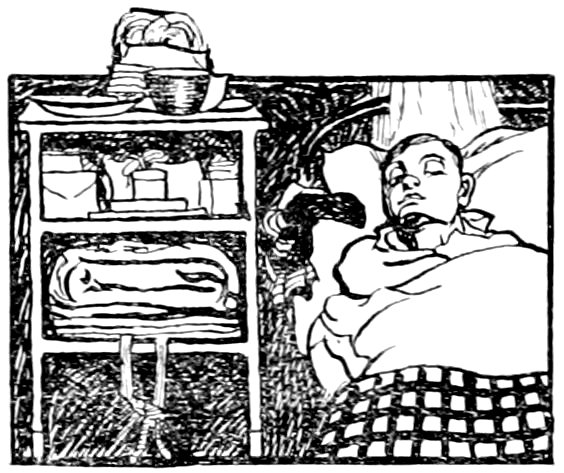
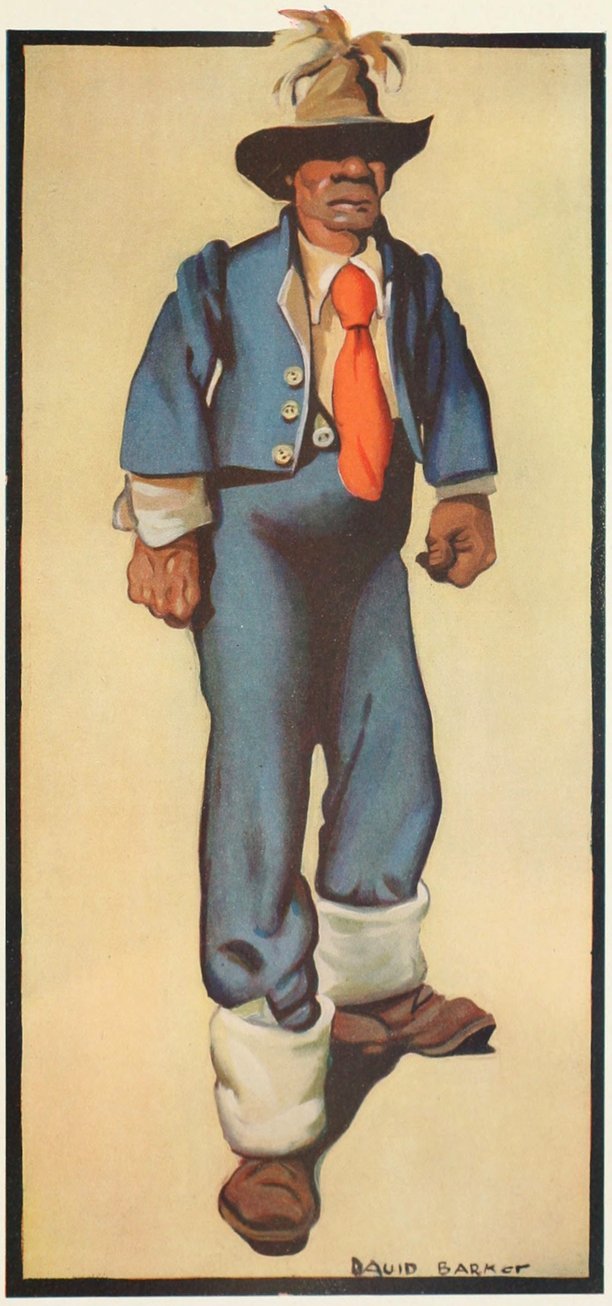
CONVALESCENT
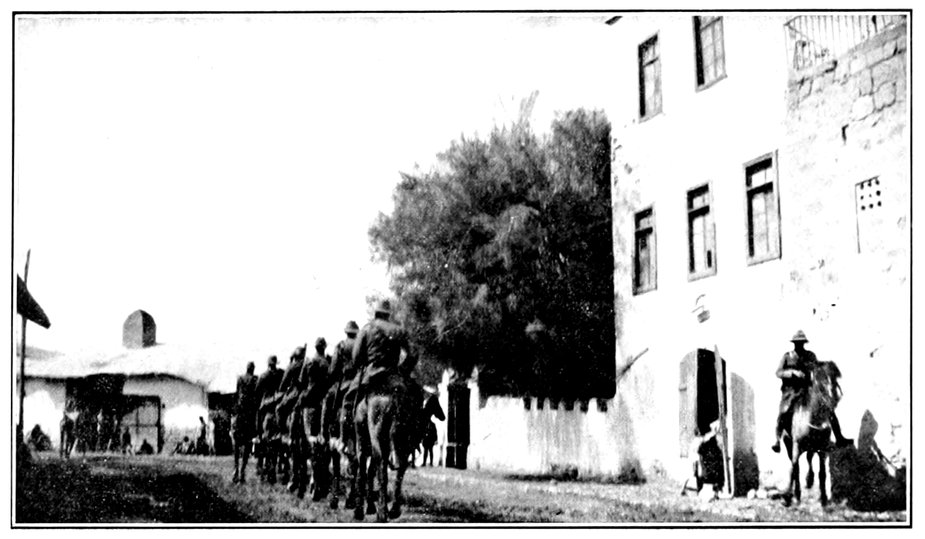
MOUNTING FIRST GUARD IN JERICHO
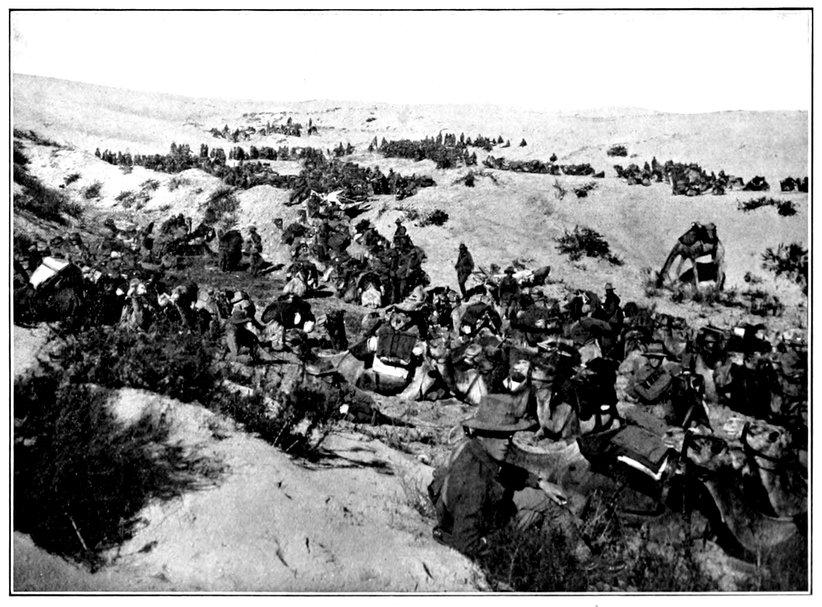
HALT AND REST

1. CHURCH AND TOMB OF THE VIRGIN
2. JAFFA GATE, JERUSALEM
3. CHURCH OF THE HOLY SEPULCHRE, JERUSALEM
4. CHURCH OF THE NATIVITY, BETHLEHEM
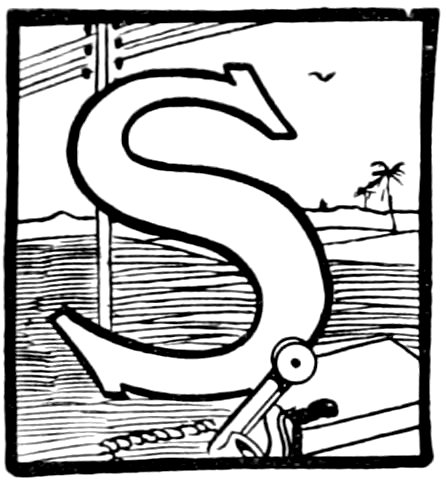
Scattered throughout Egypt and Palestine and Syria, in the community of war-worn Australians, is a certain section known to the initiated as the Engineer Signal Service of the Australian Imperial Force in Egypt. To the casual Light Horseman they are “Sigs”—a vague and most inadequate designation. Little is known of the Engineer Signaller and his work by his brother of the Light Horse, whose one idea of signalling begins and ends with the Regimental signaller, a being who shares with him the pleasures and hardships of all stunts, but who is on a plane above, because no piquets and fatigues are his. At home, the popular conception of signalling is of a soldier standing on the last, lone, bullet-swept ridge, coolly flag-wagging a message which turns a forlorn hope into a brilliant victory, and earns for him Oblivion. Signalling, as the Signal Service know it, is far from being a flag-wagging occupation; they find themselves part of a well-planned business, which is based on efficiency, and conducted with that thoroughness for detail only to be found in an army.
“Sapper Smith, get your horse saddled up right away and report at the Signal office. You need not worry about your tea—I’ll see it is kept for you. You are only going to Romani.”
The Squadron horses, after their first stunt on the desert of Sinai in April, ’16, had been off-saddled and fed at Hill 40, so the order came as a surprise.
“Right-o! Corporal!”
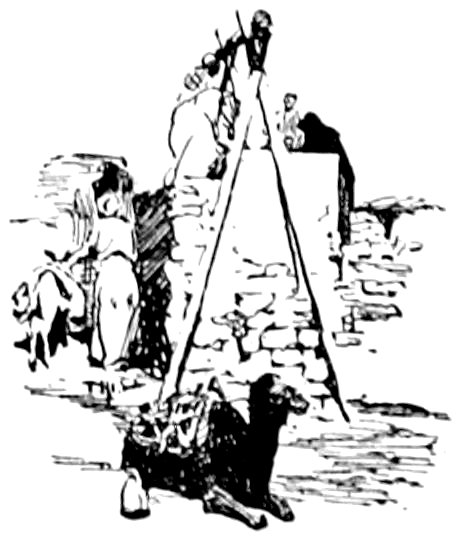
The horse was soon saddled, and Smith reported at the Signal office at five o’clock.
“What’s doing, Mac?”
“Light Horse Brigade, Romani.” The signal-master read out the address as he handed over the despatch to Smith.
“Where’s Romani, Mac?”
110Mac, the signal-master, came outside and pointed across an unbroken stretch of desert to the east.
“About five miles in that direction, I think,” he replied. “Keep near the railway line and you’ll be pretty right.”
Smith departed, and rode out into the gathering dusk of the East. He had never heard of Romani before, nor did he know how many miles he had to travel across this desert, where the Turk had been but a few hours ago, to reach the place; so he spurred his horse on over the heavy sand and covered four miles in quick time.
“We ought to be there before dark.” He spoke to the horse rather than to himself. “We’ve covered a good four miles now.”
He rode on over the level places, climbed the loose sand of the steep, razor-backed dunes, and slid down their opposite slopes to the level again, until another four miles had been crossed; yet he had not reached Romani. The darkness found him still pushing east over the toilsome, never-ending sand, with a set of new northern stars for guides.
A desert dog started up at his horse’s feet, yelped away into the night, and threw the horse into a panic of fear; a stunted bush loomed in the darkness ahead and took on the shape of a crouching figure, sinister in the gloom. Here was a dilemma!
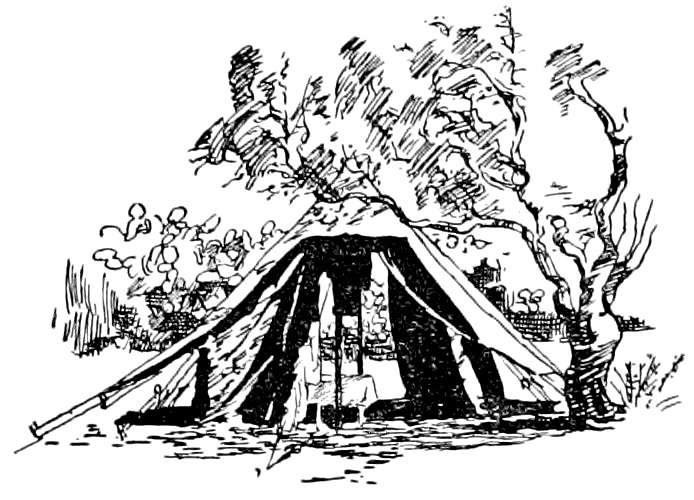
“Shall I let the horse bolt while I try to loosen my rifle? or is it better to hang on to the horse and chance—ah! It is only a bush. Am I near Romani yet?”
Eight more weary miles slipped slowly by, the sandhills pressed in on all sides, and ever the horse stumbled on gamely over loose sand and steep ridges.
“Yes, it’s a light.”
Smith swayed in the saddle and spoke again.
“Hooray! I’ve arrived,” he said.
Some time after ten o’clock a wearied despatch-rider came out of the night, handed in a despatch at its Romani address, obtained a receipt and departed. Next morning Smith reported to the signal-master and handed him the receipted slip for his despatch.
“How far is it to Romani, Mac?” was all he remarked.
At Ed Dhaberiye, and at Tel Khuweilfeh, in the hills to the north-east of Bir el Saba, the fight waged hot during the first week of November, ’17. That week is one to be remembered by the cable troop of the squadron; in it they knew no rest, for they worked night and day on the communications, and laid miles of cable to and from the Brigades.
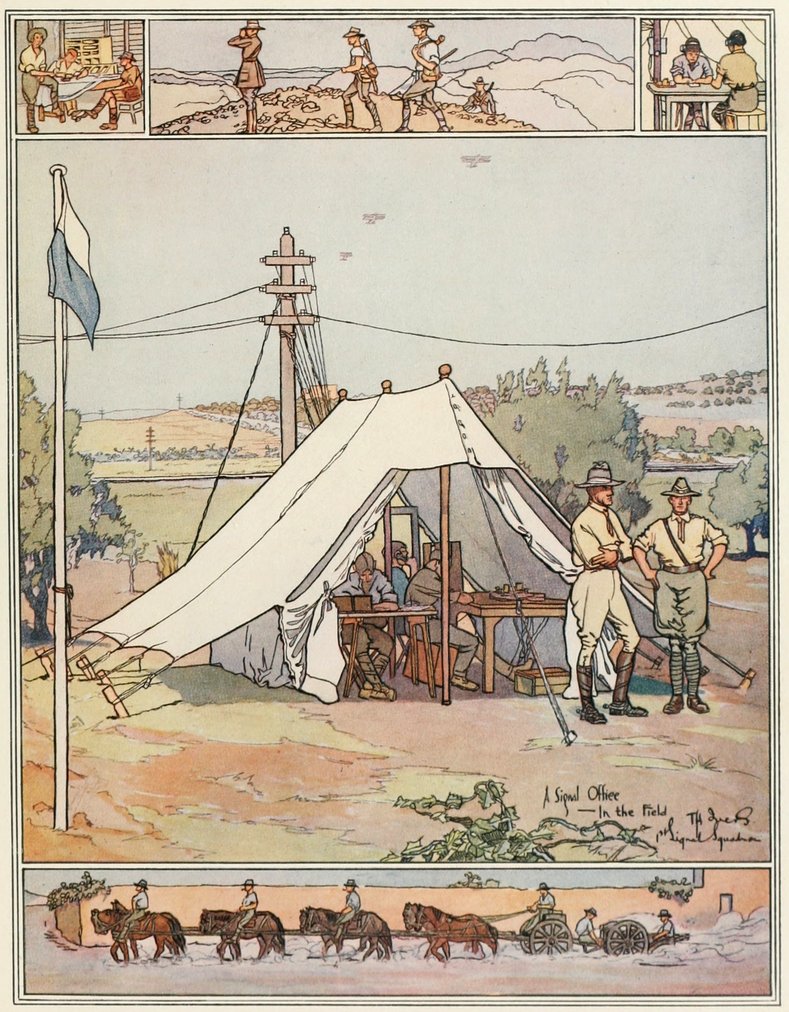
A SIGNAL OFFICE IN THE FIELD
By T. H. Ivers
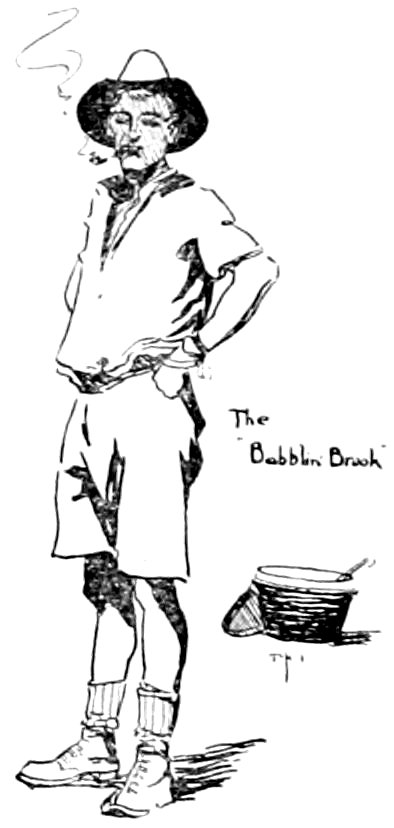
“Corporal Dawk!”
“Here, sir,” responded Dawk from behind one of the cable-wagons where he had been trying to dispose of a hasty meal.
“Hook in your team and get away to the 2nd Brigade with that line.”
“Very good, sir.”
Dawk turns to the drivers.
“Get your horses in, Charlie; we’ve got another job. Hey! Gunner.”
“What, again?” says Gunner, as he looks at his half-finished meal.
“Come over, Baldy! Back, Ginger!”
The polers are hooked up, and in a short space the wagon moves off to the Signal office for final instructions. Gunner jumps down from the body of the wagon, drags the end of the wire into the Signal office, and then mounts and pulls out over the hill.
The wagon rolls steadily over the rocky hills, reeling out the cable as it proceeds. Darkness settles down, but this does not deter the cable detachment.
“Whoa!” roars the lead driver as a wady-bed opens up below him in the darkness. “Steady with those horses behind—who’s in the pole?”
“What’s the matter?” inquires Dawk, riding up to the leaders.
“Oh, another wady; it looks pretty solid, too.”
Dawk looks ahead, rides off to the right, and after a few minutes calls out directions to the drivers.
“This way with that wagon; you can get across here.”
Charlie swings his leaders round and heads for the spot where Dawk’s voice is heard. The wagon jolts over a rock, and lurches toward the wady so closely that a huge lump of earth detaches itself from the steep bank and rattles down on to the boulders beneath.
“Get over to the right!” yells Gunner from the back of the wagon. “What the blazes are you drivers doing? You’ll have the whole box and dice in the wady in a minute!”
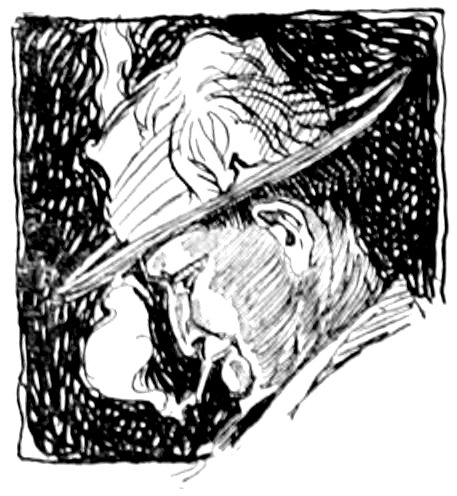
“Get up, Tiger! Up, Ginger!”
“Come over Baldy! Come over, you——!”
The wagon draws away from the dangerous edge, swings round, and, with rattling and bumping, descends into the wady-bed in a cloud of dust. The horses bend their backs to the opposite bank and are urged up by the drivers, who have risen in the stirrups and are leaning over their necks. 112With a last effort the team pulls forward, the wagon jolts over the top, and then stops.

Harry, who was thrown from his seat at the back of the cable-wagon as it bumped the wady-bed, comes limping up the slope. As he climbs into his seat he makes a remark to Gunner.
“That was a snifter!” he says.
“My oath! a beaut.”
More wady-beds open up, more detours are made, more dizzy descents and stiff ascents are negotiated, until, at last, the wagon draws in to Brigade Headquarters. The line is through, and everything is in readiness for the attack at dawn.
“When you’ve done with that pack-saddle, I want to ‘inergate’ a scheme with you.”
“Yes, sir?”
“This stunt is going to be a tough one, so I want you to see that all your pack-sets are in good-going order, and that those pack-saddles are fitted properly. Where are you putting the aerial load, Hook?”
“Everything is ready now; I’m fixing this saddle for the masts.”
“Right-o! And see that the farrier gets to work on those mules straight away.”
“Yes, sir. Have you any idea when we move out?”
“I’ve no idea; in about a week, possibly.”
Hook busied himself with the pack-saddle, fixing gadgets here and knocking bits off there, until he had it to his satisfaction. All the technical equipment—wireless sets, cable gear, etc.—had to be converted for use on pack-saddles in this Amman business during March, ’18.

Six days later the Squadron moved out in the rain, wound its way through the Judean Hills, travelled over the Jordan Valley, crossed the river, and passed up into the hills of Moab.
No wagons or wheeled transport of any kind could possibly traverse those tremendous hills, where the narrow track clung to the steep sides of the hills and threatened to fall away over precipices into rock-fanged valleys beneath. The rain poured down, and along the slippery track the column wended its way, toiling in single file up steep hills and down into precipitous valleys. The path became a river; water poured over the rocky sides of the hills and rushed into the valleys below. Everybody was wet through and greatcoats flapped soggily about weary legs; dripping horsemen led 113their horses and stumbled and splashed along the track; pack-horses and mules struggled and scrambled as their loads slipped; but the column pushed on and reached a position at Amman after two days and two nights of rain.
“We cannot use the helios, and the cable is ‘dis’ somewhere back in the hills. Is the wireless set up yet?”
Rip-p-p-p-p-p. Rip-p-p-p-rip-p-p-p-rip-p-p-p-rip-p-p-p-p-p-p.
The crash of the transmitting sent echoes through the rain-sodden air and the singing spark sent its message through space, and then whined away into silence. The engine had “karked”—communication had ceased.
No. A basket crate was brought from one of the packs, a message was written on a special form, of thin paper, and placed in a small aluminium tube; a carrier pigeon was taken from the crate, and released with the small tube containing the message attached to one of its legs. The bird circled round uncertainly for a few moments and then flew off in a straight line toward the leaden clouds in the West.
Communication was still maintained.
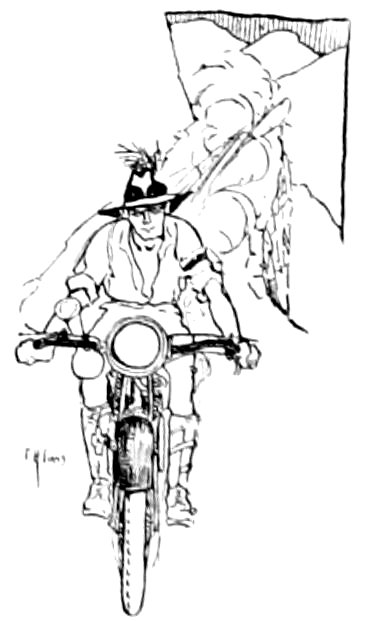
These are but three incidents—three of many—which have happened in the Signal Service. The Service calls for initiative, coolness, and devotion; all these it has in its ranks. In the desert of Sinai, on the dusty stretches of Southern Palestine, on the plains of Philistia, in the hills of Judea—everywhere “east of the Canal”—the Signal Service has always maintained a high standard which has brought credit to itself, and to the Australian Imperial Force in Egypt.
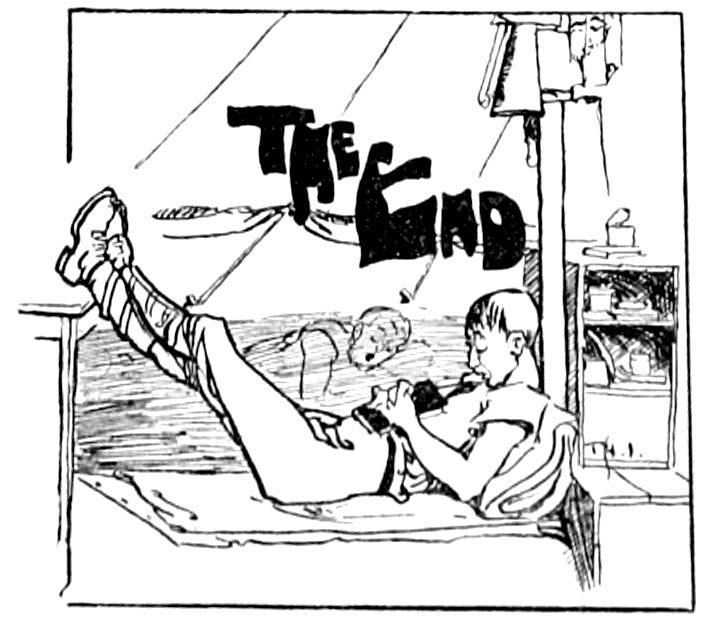

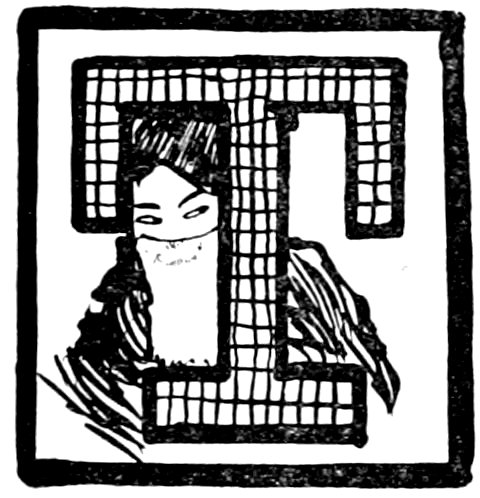
Throughout the long campaign the fighting was fairly constant, but there were occasional brief seasons of rest, and the happiest of these were spent in the neighbourhood of the Jewish orchard settlements. The 1st Light Horse Brigade and the New Zealanders favoured Richon, where the wine vaults are said to be the largest in the world; and the Jewish girls are the prettiest in all Palestine. But the 2nd Brigade was loyal to modest little Wady Hanein. The three Jewish villages of Richon, Wady Hanein and Deiran stand about three miles apart in a rough line across the sandhills. Deiran, where the polyglot lassies were wooed by the troops associated with Desert Mounted Corps headquarters, is, like Richon, a large village, almost a town, with considerable social pretentions. There the Jews hold political meetings, and the girls dress with an eye on distant Paris. But Wady Hanein is demure—a true little Arcady set amidst hills and hollows beautiful and fragrant with orange groves and orchards of almonds. In the early spring the settlement was a glory of pink and white blossoms, and, later, its lanes were scented with the breath of the flowering oranges. As I write, the 2nd Brigade is in Wady Hanein for the last time, having come down from its strenuous work around Amman, across the Jordan; and the plump round oranges are coquetting between green and golden.

It was from Wady Hanein that the Brigade moved out on the long trek across Judea and Jordan Valley and the Mountains of Moab for the first attack on Amman, in March, 1918. Nearly every Australian feigns qualification in his regard for the Jews in Palestine. But as the Regiments made ready for the road that morning it was pretty to see Jewish families visiting their favourite officers and men in the bustling camp, and wishing them God-speed with a sincerity and a touch of distress quite unmistakable. And all ranks rode to that bitter fight the stronger and better for those Jewish good wishes.
116The 2nd Brigade also chanced to be in the village in December of 1917, when Jerusalem was captured, and the citizens entertained the Brigadier and his officers at a feast, a speech-making and a dance. Proceedings were, for a time, somewhat formal and cold. The Brigadier and his senior officers sat at a central table in a large hall with the village fathers and notables. The girls, expectant, their toes tingling for the dance, sat stiffly in a row down one wall and the matrons along the other—a very convenient arrangement, because the dashing young Light Horse subalterns could seek a pretty partner without feeling obliged to ask for the programme of her elderly chaperon. The young men of the village stood with the junior officers of the Brigade at one end of the hall.
The eloquence was terrific. The erudite village schoolmaster proposed the “Health of the King of England,” coupled with the name of the Brigadier, the British Army, the Australian Army, and the British universe generally. He spoke fluent and faultless Russian—or so it seemed to us. (Our linguistic attainments will startle Australians when we come home. There is not a man amongst us who cannot now say Bread and Wine and Darling, in all the languages of East and West.) He made happy reference to great British apostles of freedom, instancing Cromwell, Lord Byron, and Gladstone. He garbled the names, but we caught his drift; and, anxious to get in, we cheered tumultuously; and then, in an unhappy moment, some one on our side released the Brigade interpreter—a dusky fellow of dubious nationality—who rose eagerly to make the meaning of the village schoolmaster a little clearer to us. His success was indifferent, but he brought down the house with references to Lord Cromwell, Mr. Byron, and Sir Gladstone.
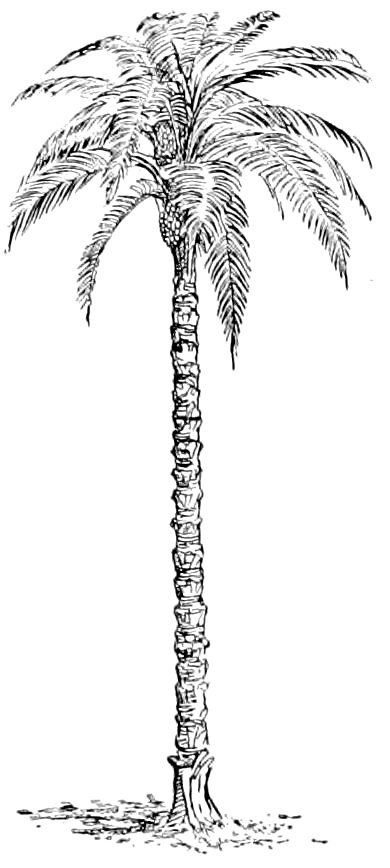
Then the Brigadier hopped up to respond. He was at his best. He referred to the joy which we, as Christians, experienced in driving the infidel from the Holy Land, and then, after an apt allusion to the Crusaders and King Richard, he became so eloquent and forceful, and slammed the table so hard, that all the village matrons gave play to their religious and patriotic feelings in subdued but prolific tears; which, when you consider that they did not know a word of English, was a unique testimonial to the eloquence and dominating personality of our versatile Brigadier. And then came the swelling triumphant peroration in which the “Old Brig.,” declared that “Palestine had been conquered and Jerusalem delivered by the help of God, but mainly by the might of the British Army.” After that we danced, and very gay it was, despite our unanimous opinion that speaking Russian 117was an easy task, compared with attempting correctly to foot a Russian measure with a pretty Jewish maiden. To be honest, it was a dumb show; but eyes were eloquent.
But we have been a long time coming to the story of the Little Bint. She was one of many of her unhappy kind in Palestine. In that country, as in all the East, the rich know no compassion for the poor. If you starve it is the will of God and no concern of the more fortunate. That interference with the ways of Allah is the cardinal sin is a satisfactory article in the creed of the rich in Palestine. So the poor starve, unsuccoured, about the doors of the wealthy.
The Little Bint of Wady Hanein was first seen slinking around the outskirts of Brigade headquarters. She was a wretched little Arab of seven or eight years, clad only in a tattered filthy shirt which came to her knees; with matted verminous hair, sparkling black eyes and a pitifully skinny little body. She sneaked round the lines at meal time, pouncing like a hungry dog on empty bully tins and jam tins, scooping out the remnants with a deft forefinger and flashing happy smiles as she put the finger to her mouth. The men were quick to notice, and soon the Bint had ten times more than she could eat. But she did not thrive. The vermin on her wretched body, and her unsheltered winter nights, kept her thin and miserable.

The grooms and batmen on Brigade conferred on the subject of the Bint and her future. The ringleader, whom we shall call Pine, a groom whose Regimental reputation was far from the best, led a deputation, accompanied by the interpreter and the Bint, up to the Bey, a fat Arab with a comfortable home and substantial wealth. Pine was forceful and the interpreter glib and honest. But the sleek Bey was obdurate. “There are many such,” he said suavely and finally, disowning any responsibility for the Little Bint, and he was not at all moved at the nasty reflections which the outspoken Pine cast upon his mother as the deputation withdrew. The missionaries returned to camp, baffled but not defeated. “We’ll adopt the little beggar ourselves,” declared Pine, “and take her on as a blasted mascot.” And they did. The preliminary work was decided. First the Bint must, as they say in plain army English, be “deloused” and bathed. Nobody wanted the job. But Pine was determined to see it through, and with the Brigade Major’s batman he cut the Bint’s hair, disinfected her and scrubbed her until her dusky colour was in danger. Other clumsy but Christian fingers cut up shirts and made her clothes; the remainder contrived a bivvy in which she was to sleep. And the Little Bint of Wady Hanein waxed 118fat and happy, and was a touch of soft femininity and a source of much delight to Brigade headquarters.
Then came marching orders for Amman. You occasionally find Arab boys travelling with the Light Horse, keen little beggars who act as cooks’ offsiders and batmen’s batmen, and officers smile and sympathetically shut their eyes to it. But it was clear that the sprightly little black-eyed Bint could not be taken out over the mountains into the bitter cold and bloody fighting at Amman. So Pine sought the Padre, and the Padre went off twelve miles to Jaffa and talked to the Mother Superior at the convent. Next day the Brigadier lent his car, and Pine—his leggings gleaming and spurs shining, and amusingly self-conscious—accompanied the Bint to Jaffa, and handed her over to the kindly nuns. Perhaps, as he left her, he gave her a big brotherly kiss and a trooper’s rough benediction; but probably he was too shy. I do not know.

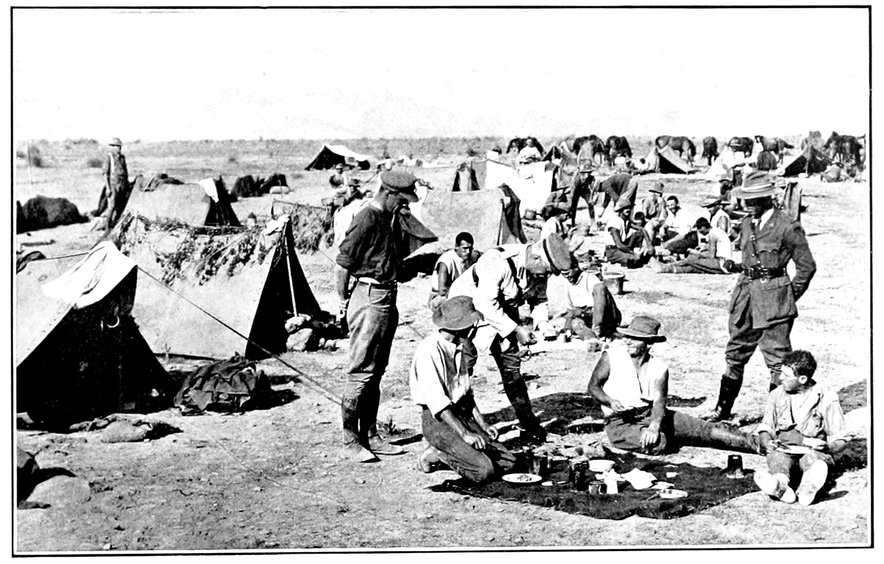
BRIG.-GENERAL RYRIE INSPECTS THE “BULLY”
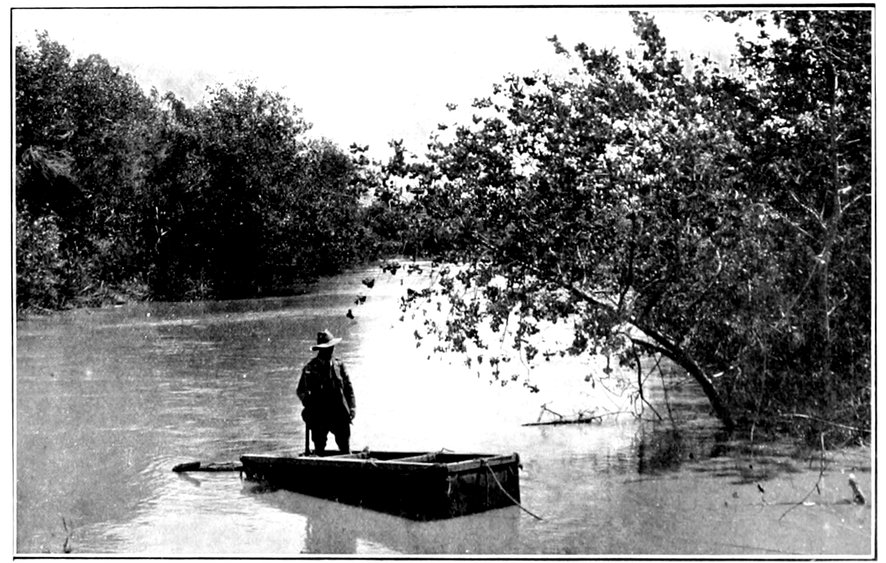
BRIG.-GENERAL COX ON RIVER JORDAN

A WALLAD OF PALESTINE
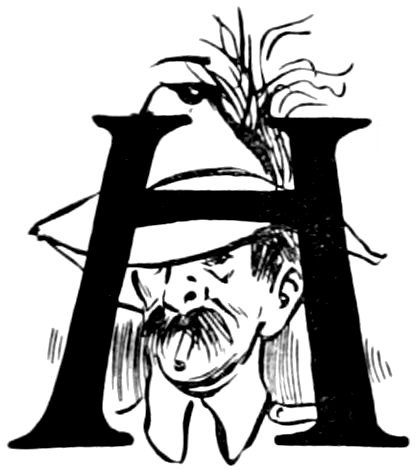
“Hullo, old chappa!”
It was Algy, an old camp acquaintance from Australia, whom I hadn’t seen before over this way. By his greeting, you will probably be able to imagine Algy; yet, with all his “haw-haw,” when you got to know him, he was quite the opposite to what was suggested by his manner of speech.
He had the habit of unbosoming himself to everybody regarding his career, past, present and future, so when I met him, I knew that I would get the whole story of his army life. And I did.
“How have I been getting on? Top hole. The only thing is that my failure to rise in the army worries my mater. With my brains, or at least the brains mater believes I possess, I was expected to rise in big leaps. But the only rise I’ve made has been from my blankets in the morning, and then, too, only by the greatest effort. Awful bore, old chappa, these early reveilles.
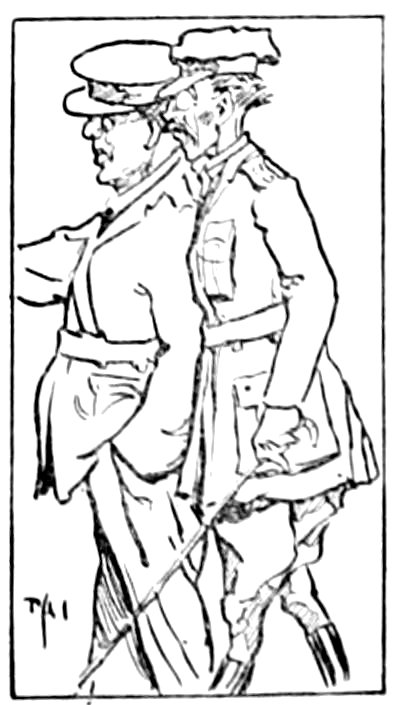
“I try to explain to mater why it is that I am still ‘just merely one of the men,’ and seek to console her by quoting that well-known pictorial post card, ‘We can’t all be officers; somebody’s got to do the work.’ You know, the poor old lady believes in me so much that she lives in the hope of some day seeing me wearing a whole string of ribbons on my bally chest. No hope. You know, some people have most peculiar ideas regarding the military. They talk about ribbons as if the military were in the habit of issuing such things in lieu of something—say as a sort of consolation when the rations are short. If they did, well, I’d be wearing all the variegated colours of the bally rainbow.
“I’ve had a most varied career in the army. I was originally in the infantry—a private. You see, I started right at the bottom of the ladder, scorning all offers of assistance to get a commission. I was quite determined to go right up the ladder by my own unaided efforts. Eh, gad, I was an egotistical ass, that’s what I was. I never for one moment imagined that the rungs of the ladder leading to stripes and stars were so wide apart.
122“But about the infantry. Goodness, shall I ever forget the beastly infantry. The unnecessary walking, and the enormous packs one had to carry, and the really rude sergeant-major, who always roared at me when on parade because I could not execute the fantastic movements he insisted upon—really, when I think about it I shudder. I always did my best, but marching used to make me so exhausted, and I never could succeed in keeping in step with the other fellows.

“Finding the infantry uncongenial, I concluded that if I HAD to be a soldier I might as well sit down to the bally job, so I got a transfer to the mounted. I had never ridden a horse other than that of a merry-go-round, but I was satisfied that I could master the art. I’ve got a different idea now. I was quite all right while the animal walked, but when it trotted, oh, goodness me, I could never harmonize with the beast.
“Ultimately, I came over here with a unit which did not use horses and was not required to do much, if any, walking. At least, that is what they said, though I should have thought at the time how the unit was to move itself. Maybe, the authorities, when I left, were contemplating providing privates with motor-cars. I’ve found out, since I’ve been here, how the unit moves itself. Don’t do any walking? Well, look here, if there is a piece of accessible ground in Palestine, and not forgetting Syria, that I haven’t trampled on trudging behind heavily-laden G.S. wagons and limbers in the course of many and frequent camp shiftings, I’d like to find it and have it photographed.”
With a “Cheeryo,” Algy was gone.

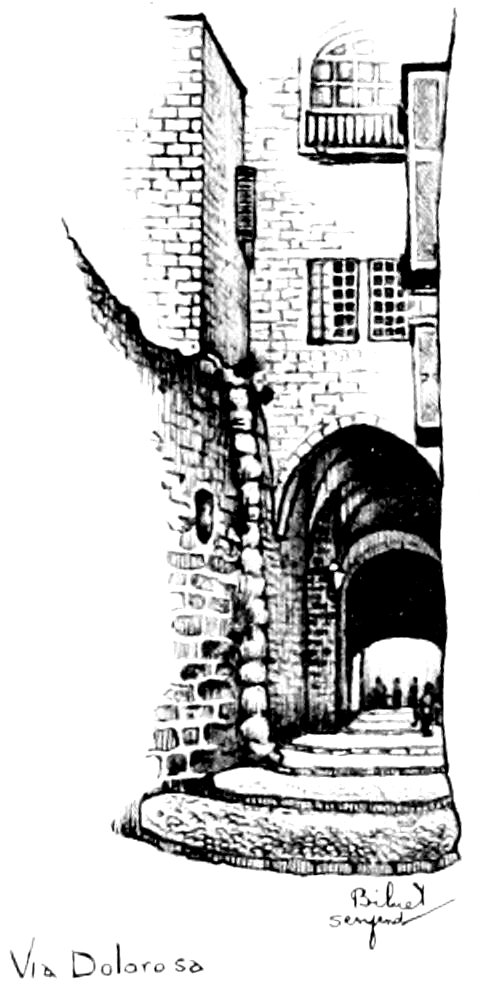
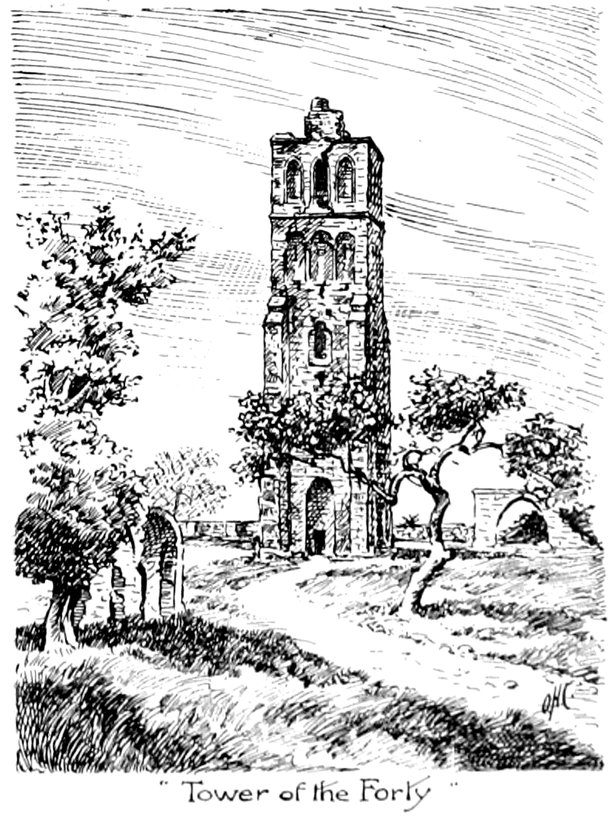
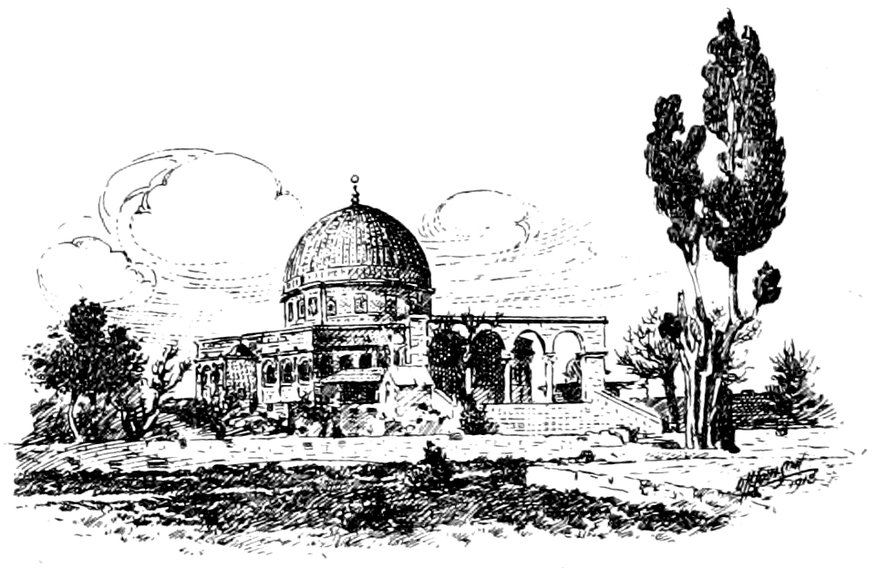
MOSQUE OF OMAR


SOME SOUVENIR
(AN AUSTRALIAN TROOPER WITH GERMAN HELMET)
By James McBey. British Official Artist
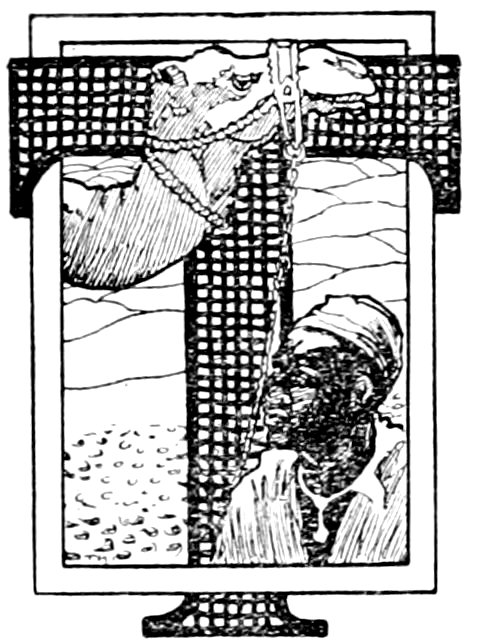
There are, maybe, ten thousand Australians who will never see a map of Egypt or Palestine, never hear of the Great War, never sing or listen to a Christmas Carol, and, perhaps, never even boil a billy, without thinking of camels.
Nor is it altogether surprising; for camels played so prominent a part in their lives in the days of Armageddon. They lived on camels; they always slept near, and often on camels; and camels carried their tucker, their water, their clothes, their blankets. The last thing they saw as they fell asleep at night was a string of long-necked camels silhouetted against the bare horizon. The first thing they heard after reveille was the raucous noise of a camel lifting up its voice in the wilderness. Nothing but camel, day and night, from the Senussi stunt to the Jerusalem-Jericho-Jordan scrapping.
None of us really liked our camels. Frankly, most of us loathed them. They were a necessary evil. In a desert campaign they were indispensable: so they were tolerated. But for many, many months the Cameleers cursed them without ceasing for the vilest, stupidest, craziest beasts that ever cumbered the earth.
Then, suddenly—it was about midsummer, 1918—we began to realize some of the many virtues of the much-maligned camel. We remembered that even on the scorching sands of Sinai, we were rarely short of water. We reminded each other that, while Light Horsemen shivered on the freezing Judean Hills, we snuggled cosily ’neath a bivvy and four blankets. We thought of all the little extra canteen delicacies we had carried in our capacious saddle-bags. And we talked about the good times we had at the camel sports with Horace, and Mange Dressing and Starlight.
The reason for this volte-face, this sudden revulsion of feeling in favour of the camel, lay in the fact that our camels were to be taken away from 126us. We were to be transformed into cavalry for that Big Push which we hoped would result in the smashing of the Turkish Army. And remembering the comparative luxury of the Cameleer’s life, we tried to make the amende honorable and say kind things of and to our old hooshtas.
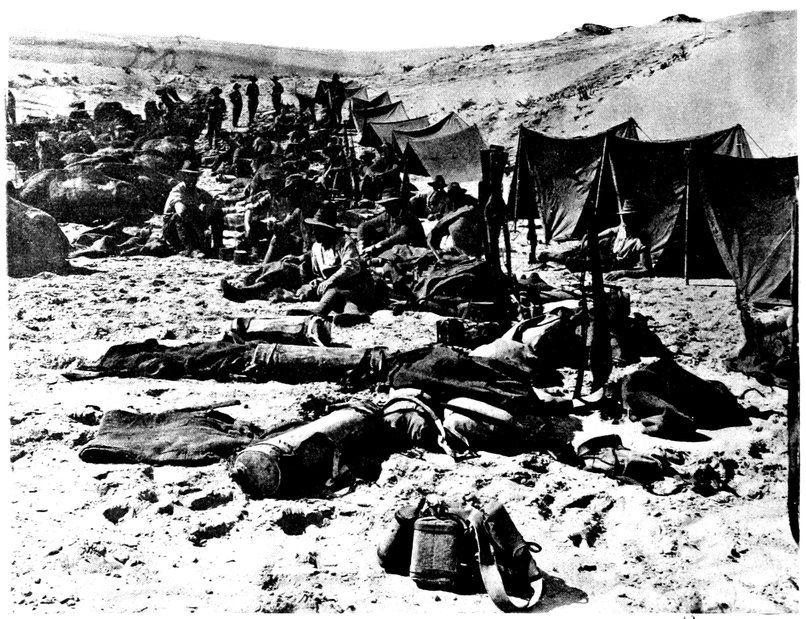
THE MIDDAY HALT
The Australian Camel Corps was formed early in 1916, when the Senussi became troublesome. Four companies of infantry just back from Gallipoli formed the nucleus of the corps. They proved a most valuable asset, so more were demanded. But it was not certain that a sufficient number of Australians could be provided, so the 2nd Battalion was composed of English and Scotch Territorials, and the force became known as the Imperial Camel Corps. Later, a third Battalion was made up of Australians and New Zealanders, and, at the end of the year, a fourth Battalion, of Australians.
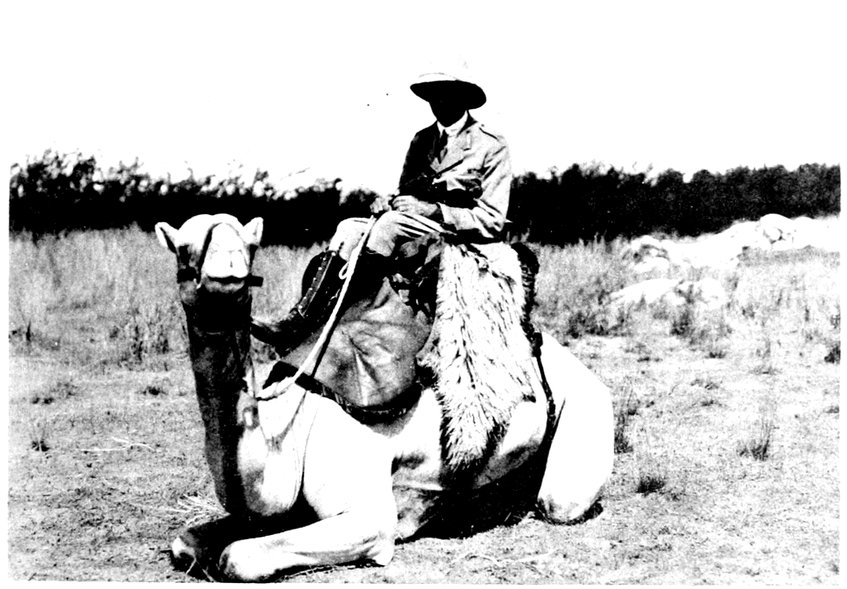
BRIG.-GENERAL G L. SMITH, V.C., M.C.

OUR WATER SUPPLY
128The Camel Corps was handicapped because of the general ignorance concerning it. The A.I.F. in Sinai knew little of it; Australia knew less. Often it was confused with and mistaken for the Camel Transport Corps, a valuable unit, which has done splendid work, but is not a fighting unit like the I.C.C. The members of the Imperial Camel Corps had all left their parent Regiments, and so, for a long time, missed those welcome parcels that the different Comfort Funds so generously sent to the boys. Later, however, the A.I.F. Comforts took a kindly interest in the poor Cameleers—and the Cameleers were unfeignedly grateful.
Coming back to Egypt from the Western Desert, the Cameleers spelled awhile, then moved over the Canal to Sinai and participated in the Romani-Bir-el-Abd fighting. Then came the big trek east towards El Arish with its attendant patrols and skirmishes. When Abdul bolted from El Arish the Army followed, the Light Horse and the Camel Corps in the van.
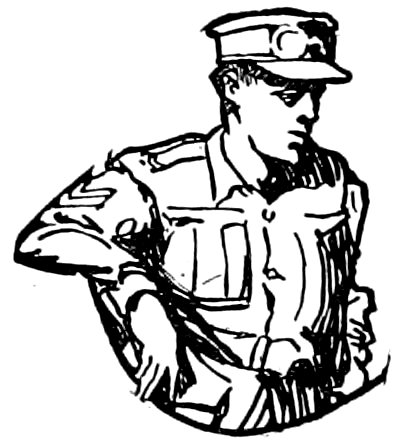
Maghdaba and Rafa followed, two of the most picturesque and decisive battles of the campaign; and in each the Camel Corps distinguished itself greatly. Then on to Khan Yunis—where lived Delilah of old—and then to historic Gaza: the lion in our path. The story of the three battles of Gaza has already been told. There is no need to recapitulate here the part played by the Camelry in those engagements, save to mention that in the second battle the I.C.C. rushed and captured their objective, suffering about 75 per cent. casualties; while in the third, and victorious, battle, they held the line at Kouelphi and Ras el Nagb in face of heavy counter-attacks.
The army had now turned the corner, and, under General Allenby’s inspiring leadership, the Camel Brigade pushed north with the remainder of the force until Jerusalem was captured. Then the army settled down in the stalemate line of trenches stretching from just north of Jaffa to the Jordan near Jericho; by which time the Cameleers had suffered so many casualties, and the camels were in such deplorable condition, that they were sent back to Rafa to recuperate—and hold a sports meeting.
Mention should be made of the Hong Kong-Singapore Indian Mounted Battery, known to the Camel Corps as “The Bing Boys.” These Indian soldiers participated in all the fighting in Palestine.
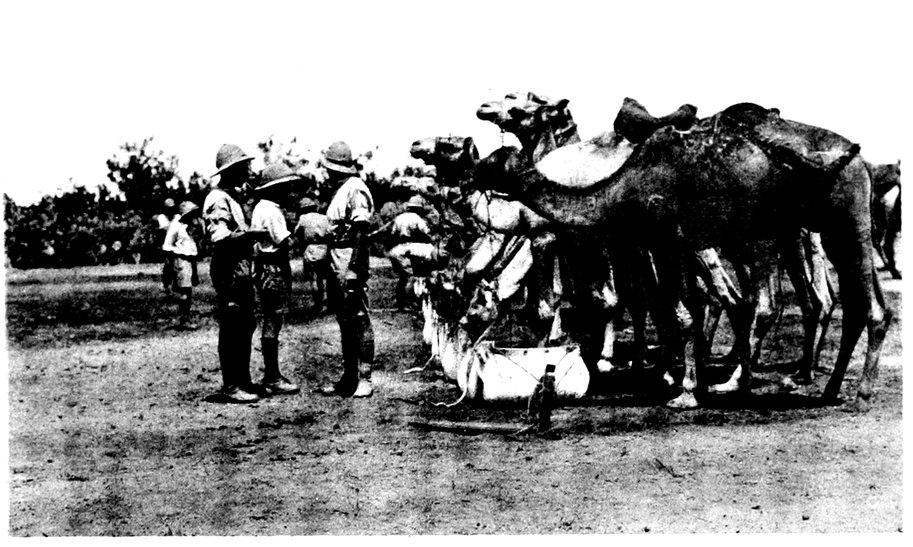
WATERING TIME, CAMEL BRIGADE

“PREPARE TO MOUNT”
130In March, 1918, the Camel Corps trekked through Palestine to Richon, where they sampled the wine of the country. Then, after the rains, they ploughed their way through mud and slush and wire to Bethlehem. From the wintry heights of Judea they descended by way of Jericho to the midsummer of the Jordan Valley and on to Amman. Much has been written about the adventure, or misadventure, into the hills of Moab. Never will the Cameleers forget that night journey over slippery goat-tracks to Es Salt. Never before or since was there ever such a journey. Hour after hour the cavalcade struggled onward and upward, crawling round ugly devil’s-elbows on mountain tracks, slipping and floundering in the mud. Time and again camels would collapse, bogged and helpless, and some toppled over the precipice. But the Brigade got to Amman and blew up the Hedjaz Railway.
Back to the Jordan Valley again, the prey of snakes and scorpions and spiders, mosquitos and flies and Turkish shells—but the mosquitos were the worst. Scores and scores of men went sick with malaria, which recurred during subsequent operations. The last big scrap of the I.C.C. was the defence of Musallabeh, which the Turks attacked with grim determination. In spite of very heavy casualties, the Cameleers held on and beat off the enemy. Because of this gallant defence, General Allenby decreed that henceforth Musallabeh should be called “The Camel’s Hump.”
With Sinai far behind and well-watered country ahead, it was seen that the Camel Brigade had outlived its usefulness. So, in May, the Cameleers returned westward towards Jaffa, handed over their camels, and were mounted on horses and armed with swords for the Big Push.
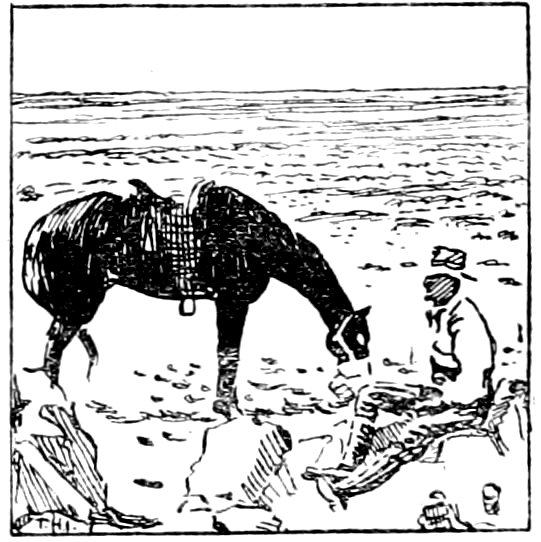
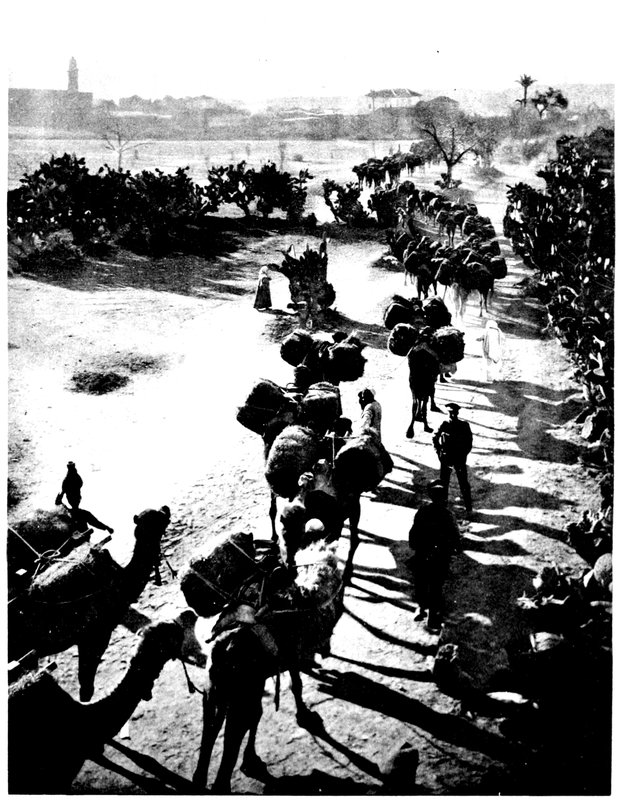
PORTION OF CONVOY OF 8,000 CAMELS BEARING SUPPLIES ON THE PHILISTINE PLAIN
Australian Official Photograph


There’s a delightful sound about that little word “Rest.” It conjures up delicious visions of breakfast in bed, scrambled eggs on toast, lying about in the sun, nice books to read, etc., etc., as the imagination wills. Now, we didn’t expect all these things, but when we got the word, “The regiment is going for a rest behind the lines,” everybody’s ears pricked up, and we were all on the qui vive for the few days following.
Sure enough, we moved out all right, and camped one moonlight night on a gently-sloping plateau to the west of the hills, taking up our abode comfortably in bell tents, six of us to a tent. We’d had a long day, so soon turned in and slept the sleep of the conscienceless. Behold us next morning, at that cold, cheerless grey hour which just precedes the dawn, lying in various picturesque attitudes, with the cold wind playing on us, as yet untouched by the sun’s compensating warmth. A bugle gave out its brass-mouthed message, and one of those necessary evils known as corporals invited us to “turn out and fall in.” Now, it was the witching hour of 4 a.m., and we didn’t like “turning out” or “falling in,” or any kindred mysterious movement; but necessity knows no law, so, to the accompaniment of many an ungracious “Blarst the war,” “What sort of a rest is this?” we crawled out of bed, dressed, and wended our weary way to the stables.

BEDOUINS CAPTURED AT HASSANIYA
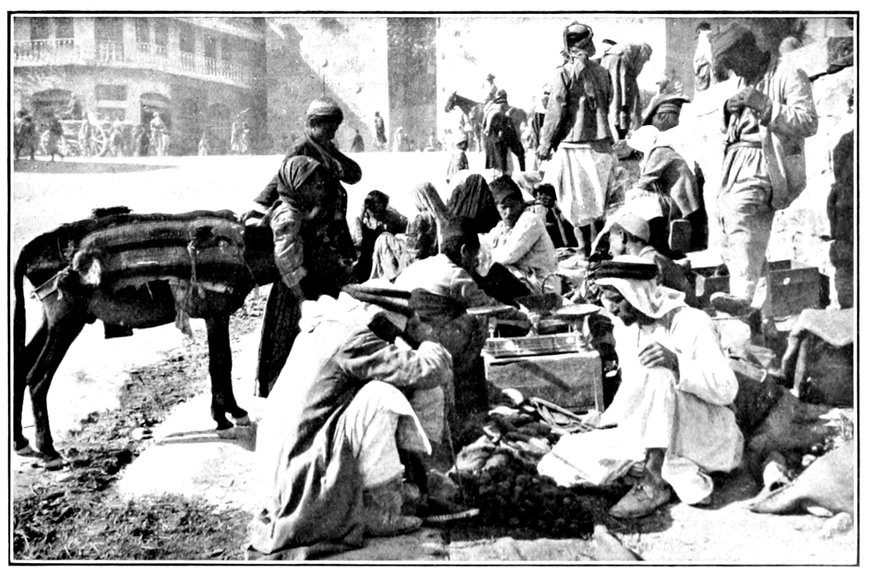
STREET MARKET, JERUSALEM

BEDOUIN VILLAGE
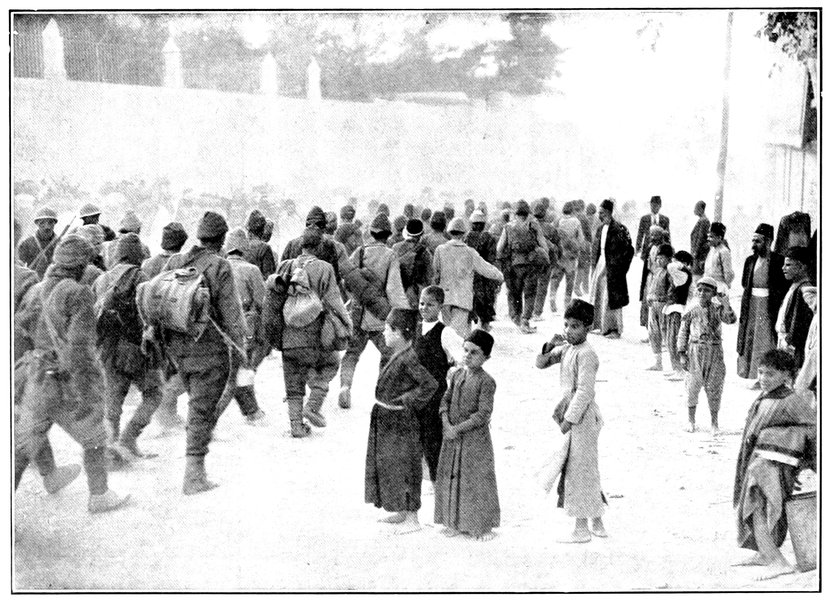
TURKISH PRISONERS, NABLUS
135The next hour or two saw us busy among the horses—removing the superfluous dirt from their coats, cleaning up the stable lines, and watering and feeding our jaded mounts. We were then marched to the Q.M.’s to be issued with an extra blanket. In the usual way of Q.M.’s, this just allowed us back in time for six o’clock breakfast. During the meal they broke the news gently to us that there was a mounted parade at seven, to go through a “little training.” More grumbles, of course, but the time was too short to allow of any delay for grousing, so we got out for our “little training.” This delightful exercise consisted of a gruelling couple of hours in the sun, after which we had to groom and stable our horses, had a quarter of an hour’s “smoke-o,” and then the pleasure of lecture for half an hour or so.
Dismissed to our tents, we distributed ourselves behind the covers of various journals—ranging, according to taste, from “War Cry” to the “Bulletin.” Hardly was our interest fixed, when there was borne in on our ears a stentorian cry which resolved itself into the voice of our two-bar artist yelling “Fall in for water!” and away we went again like lambs. A struggle with four horses, two on each side of you, and each couple desiring to go in a different direction, is not calculated to improve one’s temper; but we got the job done and returned for dinner. This meal was not the one of our dreams, but we settled down after it as though we’d lunched at “Shepheards,” and began to think that the “rest” part of the stunt was at hand. Then the orderly sergeant announced that there would be a grazing parade at two o’clock. So out we all had to turn again and spend a couple of hours on the grassy slope a mile or so away, thinking sad thoughts and uttering strong utterances.
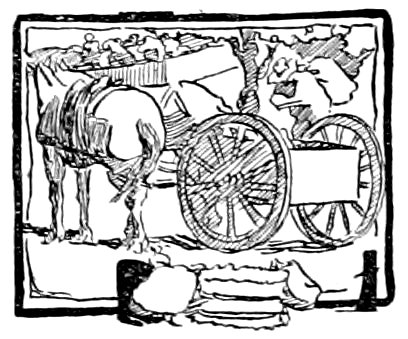
Back again, stable the horses, we finished just in time for tea, to which we did ample justice, and allowed ourselves to drift into a better frame of mind. After tea we at last settled down in our tents, and had just dealt the cards for a quiet game of poker, when, lo and behold! the orderly corporal looked in and said, quite pleasantly and off-hand, too, “There will be an inspection at 9 a.m. to-morrow; all saddlery and gear to be cleaned and placed outside tents at 8 a.m.” Well, we looked at one another—we 136were past words. Slowly the hands were thrown in; more in sorrow than in anger we cleared the card-blanket away, and the last scene saw six queerly silent figures listlessly polishing up bits and stirrup irons and greasing leather gear, with the mutely suffering look in each face akin to the look of the dog which has just received a kick in the ribs as the grand finale to a series of ill-usages. So ended a day of rest. In that tent, that night, men went to bunk murmuring, “If this is rest, send us back to work.”
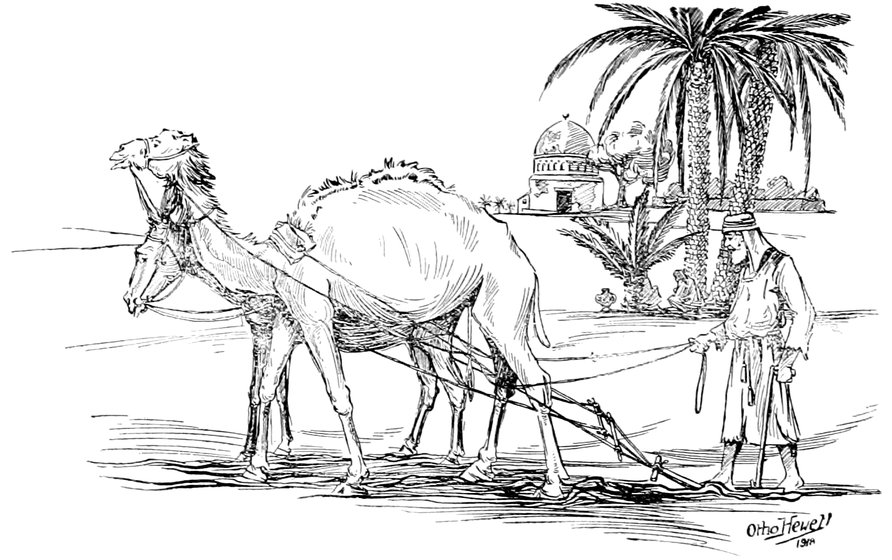
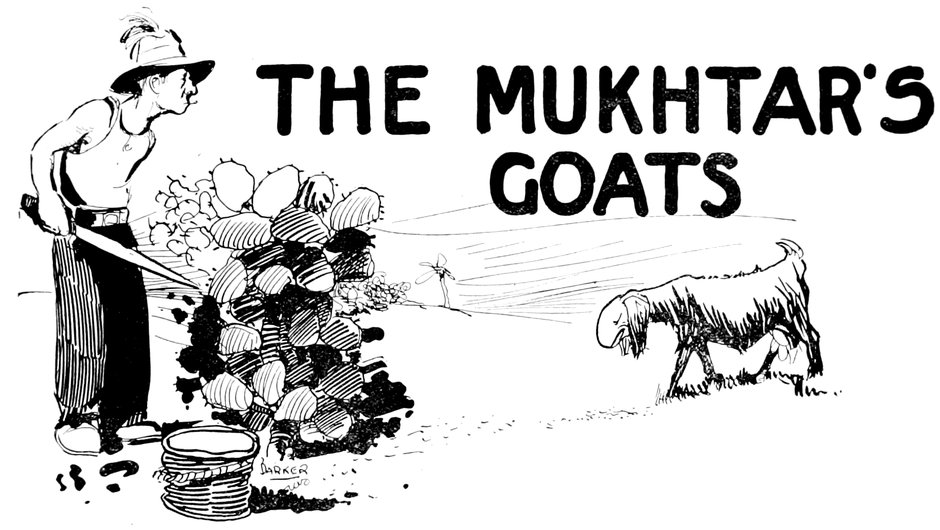

BUYING ORANGES, JAFFA
By W. O. David Barker
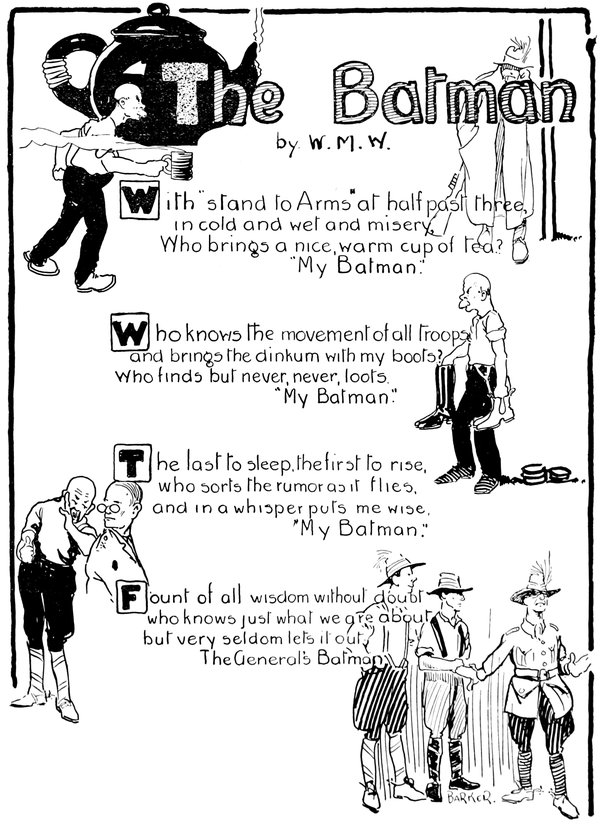
The first charm of Damascus as a whole city lies in the contrast which those brown sandhills behind it make with the green strip of the Barada Valley. Journeying from Ludd through the monotony of lank, brown growth that straggles to the horizon from the road, you give up hope of ever seeing foliage again, until you pass El Kunneitra. Then you see the green of Barada; and it is the richer for the hills behind it—browner, more desolate by far, than any landscape skirting Galilee or the Jordan. Far up the clay feet of those rocky hills straggles the brown-and-white suburb of Salahiye, all square-built and flat-topped—from the distance like bricks inserted in the clay soil. The line of hills is cleft cleanly by the Pass, the scene of that hideous slaughter by our machine guns. If you climb into the fringe of Salahiye you see the curious shape of Damascus—a jagged comet-form, all the angles and serrations of the brown tail defined with unnatural clearness by the depth of the green about it. In the amorphous head are a few minarets—like jewels. In Cairo there are too many minarets as you look from the Bey’s Leap: they protrude like a porcupine’s quills. In Damascus the city’s flat brownness is just relieved by them. When we came to Damascus it was drought-stricken. Soon afterward, it rained torrentially for a day. Then the sun shone and drew from the city such colour as we never dreamed was there. Nor had we dreamed that the trees were dusty—so green they seemed after the southern country. But, washed, they helped to throw up the wonderful colour of “that great city,” as it is called in Scripture.
It is a relief to be delivered from the sight of the everlasting cactus-hedge of the southern towns. The cactus does flourish in Damascus; but so thick is the foliage that it is lost in the mass. You cannot look down on Nazareth without being obsessed by the ubiquitous pest. You can look down on Damascus and be unconscious of it. It straggles about the leafy roads in patches beside the mud walls. That you can bear, because it does not rise above the all-enclosing foliage.
The smells of Damascus you will remember for ever. Cairo is clean by comparison: the alleys of Cairo are not foul. The stinks of Damascus are 141literally overpowering. There is offal, refuse, foul puddles in every street of the Bazaars. The Abana is a foul river. “Are not Abana and Pharpar, rivers of Damascus, better than all the waters of Israel”? The answer is: Certainly not. There is an ill-kemptness about the place that carries Oriental slackness a bit too far. In the streets that thread the heart of the city are ruts and holes that break the springs of M.T. every day. The tramline protrudes eight inches. This gives rise to deadlocks in traffic that hold up movement for an hour. Incredibly narrow and tortuous are the highways of the city. The only decent road is that which skirts the fountained promenade near the Hedjaz Station. I am sure the Damascans look on this bit of orderliness as a Western intrusion; just as I am sure that if they found themselves in an English town guileless of smells they would call it insipid....
In the bazaars there is a baffling complexity of colour, of race, of wares. The Mousky is less heterogeneous. In the Square, in the street which is called Strait, in the gold bazaar, grain bazaar, sweets bazaar, silk bazaar, you have all the various colour of tarbooshed Cairo, and more. Here the soldiers of the King of the Hedjaz throng; there is endless variety in their clothes and their flowing head-dress. The Moslem women, who veil their faces, affect far more variety than the Mohamedan women of Cairo, with their yashmaks. The French are here. The Australian hat and plume is everywhere. I never saw so great a number of Australian soldiers moving at random in any city. There is great jostling in these narrow streets, more than the normal jostling you get in any crowd.
The dusty bazaars are in semi-darkness; their streets bear a covered roof of iron; they must get protection from rain. In Cairo all is open; for there it rains but rarely. Not only are the bazaar streets in Cairo without roofs that would stop a shower, but the shops, themselves, full of treasures. Here the rain comes in a deluge. From some of the street roofs the enemy had taken the iron for military use. What the state of these roofless streets will be when the rains come is sad to think. They will be flooded all winter.
Except that there is greater diversity of peoples—both buyers and sellers—the bazaars of Damascus are much like those of the Mousky. There are the same well-defined areas for specific commodities; the same little cubicles for shops, where vendors squat and “reach for things”; there is the same voluble haggling—the same conversations carried on in tones that you would first mistake for quarrelsome; there are the same crying, peripatetic vendors 142of limonade, quoit-shaped cakes and toffee; the shoe-blacks are here, but they are ahead of Cairo, with their gongs to attract the uncleanly-shod. There is a more incessant stream of laden donkeys through the bazaars here. In Cairo the donkeys are chiefly for pleasure riding; here they are mercantile, over-laden with the striped sacks of grain and fabric. There are additions to the bazaars of Cairo in the goldsmiths’ bazaar, the sweets bazaar. The goldsmiths work with their blowpipes and tiny forges and tiny tools, moulding and fashioning. It is curious to see the workshop as part of the sale-shop. The belts, brooches, rings and trays exposed for sale in a showcase were made two yards away by that cunning Oriental fashioner squatting on his haunches. The sweets bazaar tempts you hideously. Eastern nutted sweets and Turkish-delight and toffees look as well as they taste. Mere assorted chocolates—such as you get at Groppi’s—are crude by comparison. There are great serpentine coils of Turkish-delight lurking in icing-sugar—nut toffee that is all nuts—none of your miserable paucity of nuts such as one gets in English almond-rock: nuts form the matrix here.... But enough of that; here, if ever, you are tempted to generate a liver the size of your hat.
Public baths abound in the heart of the bazaars. Fronting the street is the final, open, divaned, cooling-off room—an amphitheatre of couches upholstered with a kind of gay-coloured towelling. A fountain plays in the midst. The bathed sit swaying in the ecstasy of reaction from the steam, with closed eyes. No Roman ever bathed more voluptuously. No one minds your going in nor your penetrating to the bowels of the establishment. Room after room you pass, with swinging doors; each is hotter than the last. In the last, and hottest room, the smell of man is overpowering; you hastily retrace your steps through the series of chambers and regain the comparative sweetness of the bazaars.
Foul as this city may be, there is beauty in every foot of it. The beauty of Cairo lies rather in the view you get of “chunks” of it—the vista of the street, the space of a market-place, the mass of a mosque. Here the beauty lies in little pieces of wall, looked at minutely, in a tiny piece of domestic architecture. It is a beauty in colour rather than in form. Form in Cairo counts for much—in Damascus for almost nothing. Here there is dilapidation in a degree undreamt of in Cairo. But dilapidation does not necessarily make for beauty, though some people think it does. I believe the beauty of colour in Damascus lies in extreme age—in the mellowing of age. After Cairo, the intense antiquity of the older city—of every 143fragment of it—comes to you impressively. You feel the age of it as you pace every yard of its alleys. Cairo is comparatively modern, and comparatively garish. There is a fine, if filthy, harmony in Damascus.
Intimate in the memory of most Light Horsemen will always be certain features of Damascus. Our men will not forget the Hedjaz Headquarters in the heart of the city, the German Club, the Local Resources Office, the filthy Turkish hospital, the English and French hospitals in the suburb, the littered railway station, the suburban roads, unspeakably rough and muddy, the afternoon perambulations of blatant under-dressed bints in gharries, the guards—on the aerodrome, on the Ottoman Bank, on the captured grain stores, on the captured guns—the plentiful lack of ordnance and canteen stores, the corpses of dogs and horses in open spaces, the multitudinous beggars, the exorbitant prices asked for German razors that cost their vendors nothing, the moderate cost of silver and brass ware, the Hedjaz recruiting processions, the glut of matches, the potency of arak, the cunning of the plausible English-speaking small boys, the puzzling complexity and fluctuation of the currency, the paucity of mails, the liberty and the usefulness of Turkish prisoners, the fitful and lawless discharge of firearms about the city all through the night, the suddenness with which sickness made its descent upon the apparently immune, the daily receipt and despatch to time-table of official mails by air, the dancing lights of Salahiye that burned till dawn....
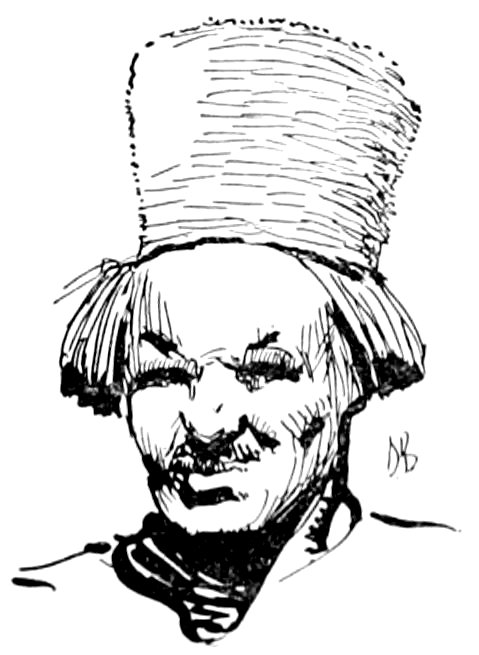
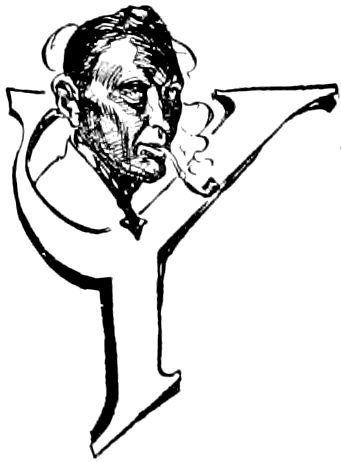
After four years’ service, the remnants of the First and Second Contingents were assembled preparatory to return to Australia. Such a prolonged absence from their homes might have led one to expect a wild emotional outburst; but they received the tidings casually.
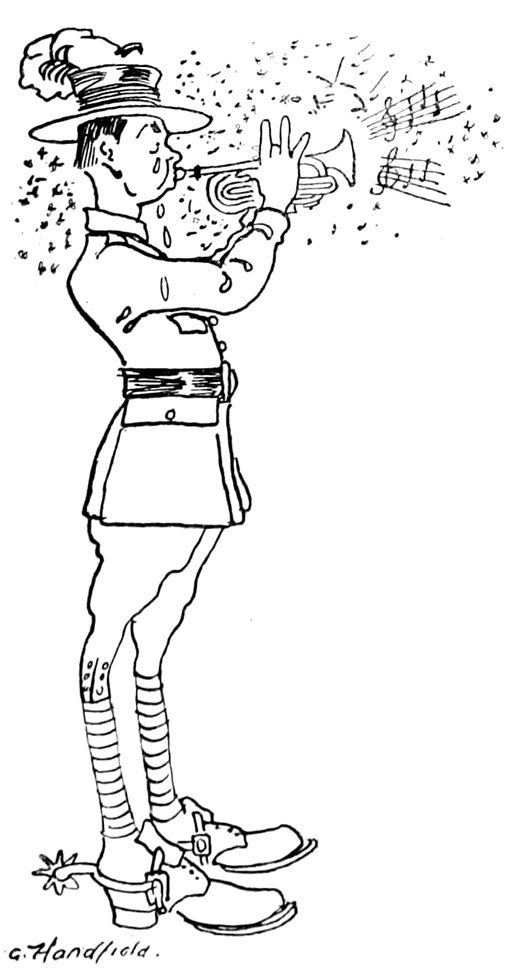
As they fell into line to be farewelled by the Brigadier, they presented an inspiring sight; shoulder to shoulder, each man a history in himself; true mates, every one of them: their fellowship cemented by the blood of fallen comrades. Alert they stood, hardened by the privations and hardships of long years of campaigning, but—true test of manhood—ready to face it all over again if their principles were involved.
As they waited for the “Old Man,” as the Brig. is affectionately termed, visions of the past began to take form before their eyes. Mine saw the silent, winding streams of human life, being hurried through the streets of sleeping cities on their way to grim, silent transports. No gay farewells, no playing of bands, no gathering of gaily-dressed crowds to wave them farewell on their way to foreign shores. As they strained their eyes for a last glimpse of their native land, many must have tried to visualize their return. None realized how or when, and many of the stout hearts on those sea-sprayed ships who gazed with loving eyes on their sunny land were saying the last farewell. Their graves are in strange lands, their deeds imperishable memories.
“Boys”—it was the Old Man speaking—“we come together to say good-bye.” He outlined his association with the Brigade, and touched briefly on the outstanding incidents of its career. He humorously alluded to their “weakness” in a few respects, but 146he was proud to say that no man had ever complained of his punishment. Everybody had played the game, and his life was infinitely richer because of his association with them. He wished all a bright future, and they were never to forget him if they were ever in any difficulty.
At the close of the homily, I am afraid, the etiquette of military discipline was violated in many ways. “Good old Brig., the whitest ever made,” and such-like remarks were punctuated by cheering and the waving of hats. A personal handshake with each man and wishes of “good luck”; and then came the farewells round the camp, when mates of years bade each other good-bye, and turned away.
Friendship such as this will stand the test of time.

MRS. CHISHOLM’S CANTEEN AT KANTARA

BETHLEHEM

TROOPERS ENTERING JERICHO
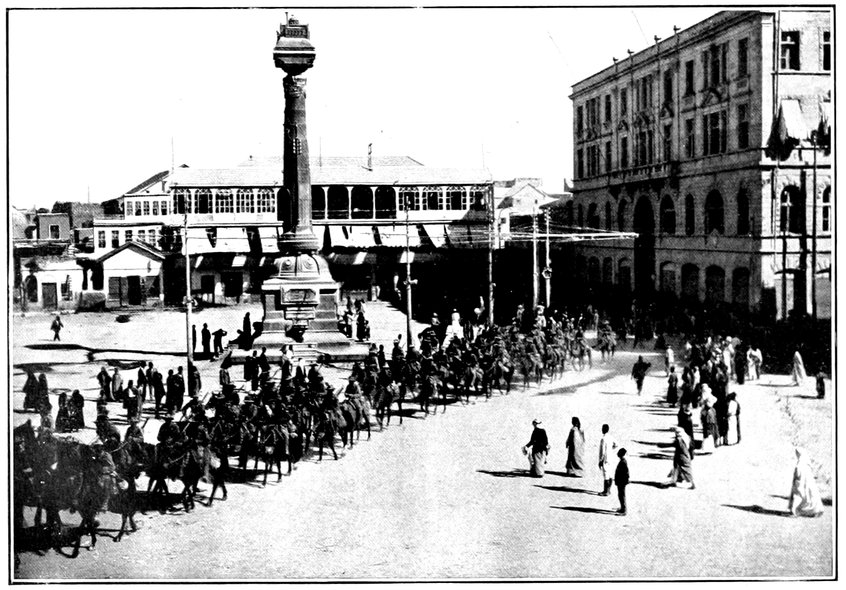
DAMASCUS

“Vickers Light Automatic, ·303,” so saith the machine gun handbook. Further on, it informs the reader that the gun weighs 38 lbs. when the water jacket is filled. These statements have been the subject of many bitter outbursts, and not a few have wondered whether they had a pair of scales at the War Office (this unfortunate institution is, of course, responsible for everything that goes wrong).
There have been countless instances where a sweating, cursing Billjim, struggling up a scorching precipice with the said Vickers Light Automatic, would have betted all his deferred pay that it weighed at least ten times as much as the handbook implies. Even on such kindergarten exercises as gun drill, wonder has often been expressed that “they” had the blooming neck to print such a fib. Still another proof that the real weight greatly exceeds the official figures. Watch the hefty No. 2, capable of lifting an 18 pdr., as, after continuous firing, he gets the order, “Out of action!” In a flash, the pins are wrenched out, he seizes the smoking gun where the protecting piece of puttee, numnah pad or sock isn’t, and instantly drops the weapon to the ground. Isn’t that convincing?
There are other minor details about the machine gun handbook that are apt to be misleading. It states that there is a No. 1, who is the boss and only carries the tripod—a flimsy toy of some 48 lbs. of brass and steel; next, a No. 2, who juggles with a Vickers Light Automatic; also a No. 3, who has nothing to do but carry a few boxes of ammunition, these being mere tin cases no bigger than the handbag he used to carry his pyjamas in, and containing only one belt; then there are a few other superfluous hangers-on; a No. 4, who aids the No. 3; a No. 5, who aids him; and so ad infinitum down to that humble creature, the pack leader, who holds three horses during an action.
Thus far, the handbook is perfect, photographic plates and all. Where the discrepancy comes in, is that there is no advice regarding a hitch. It has nothing to say about this: A person is observed toiling 151along with the tripod, a box of 250 cartridges hanging on each leg, straddled across his shoulders; some distance behind him wobbles another sagging individual, bearing the gun, more belt boxes, a pick and a shovel; while a third—sometimes—struggles on with still more belt boxes, range-finder, spare parts wallet, a can of water, steam escape tube, a bag to prevent dust at the gun’s muzzle, and a few other trifles; and down in some more or less protected hollow, three or four distracted pack leaders curse away their last remaining hope of salvation trying to keep untangled the twenty-odd hungry brutes that crane their necks to nibble at infinitesimal, dead grass stalks. Let us dismiss the handbook.
The machine gun can be put to many uses. As a seat, it is admirable, also as a clothes horse for small gear; and as a horse rack, providing the animal doesn’t pull it over, it stands alone. It has also been known to remove Turkish folks from their ration strength—but accidents will happen.
The gunner is at his best when using his gun as anti-aircraft. He reverses the position of the gun on the tripod in order to get a sharper angle, and lies down on his back beneath it, pillowing his shoulders on some soft substance, such as the spare parts box. The No. 2 crouches alongside to tuck in—at this angle—the reluctant belt; the Taube approaches at a reasonable altitude, and then ratta-tatta-tatta stutters the gun.
A heartrending episode occurred in the Jordan Valley one morning. The guns, at the top of the precipitous cliffs lining the Jordan, were being snugly tucked away in their little dust-proof positions for the day, when sinister humming in the sky was heard. Out of the woolly, cumulus clouds a flock of Taubes dived and began their fell work. In a twinkling, the guns were violently slammed on the tripods, fresh, full belts rattled into the feed-blocks, and the gunners flopped into their positions, grimly inviting the visitors to come a bit closer and “have a fly.” They did, and answered the prompt leaden stream with their own guns.
One gun had been firing merrily at the wheeling Taubes for some time when the prostrate, grim-jawed No. 1 uttered a wild, squealing yell, and writhed fearfully. “Good God, Percy is hit!” cried young Bobbie, the No. 2, and he turned in alarm to his friend, who was out-writhing any live wire.
The No. 1 gasped and stuttered in his agony, but managed to ejaculate: “Hit, be dinged! It’s the bloomin’ hot shells that trickled inside me shirt. Hop into ’em!”
152I give this illustration merely to show the risks attached to machine gunnery.
The Machine Gun Squadron is regarded as a desirable unit. It has numerous advantages over the Regiments; notably, there are no duties or fatigues to speak of, except, perhaps, stables, watering, rations, cook’s, Q.M.’s, road-making, laying interminable miles of stones in line, whitewashing same, erecting this, that and the other, cleaning saddlery, polishing reluctant steel work, an odd guard or two (mostly odd), and a few other trifles, which the conscientious soldier performs with assiduity and alacrity.
There is little else about machine guns to learn, they are so perfect that a machine gunner is now made in six weeks instead of six years. They have performed some remarkable work during the war, moral effect being one of their greatest assets—observe the sprightly vigour with which the officer inspecting outposts bounds away from the front of a machine gun position, where he has wandered by misadventure, when the man on guard sings out, “Machine gun here, Sir!”
The boys will be sorry to say good-bye to their vicious, stuttering pets; and let us hope that, the guns, when they are returned to Ordnance, will cease to (metaphorically) curl their lips in disdain at their humble and erratic poor relations, the Hotchkiss rifles of the Regiments.
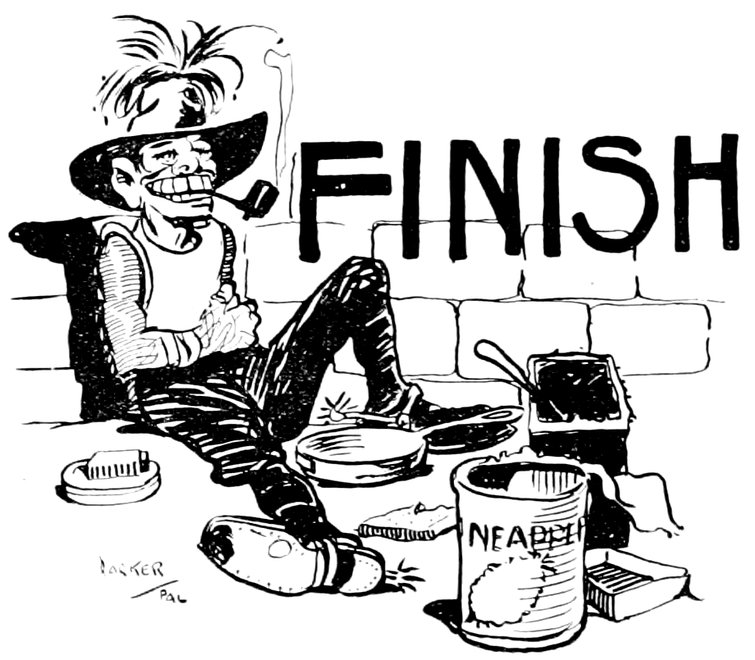
THE ART OF ARTHUR STREETON. Edited by Sydney Ure Smith, Bertram Stevens and C. Lloyd Jones, with critical and biographical articles by P. G. Konody, Julian Ashton and Lionel Lindsay. With coloured reproductions of 35 of Streeton’s best landscapes and 20 others in black-and-white, 10¼ × 8¾ inches, 42s.
THE ART OF CONRAD MARTENS. Edited by Lionel Lindsay, assisted by G. V. F. Mann, Director of the National Art Gallery of New South Wales. With reproductions of 60 of Martens’ pictures, mostly in colour, 10¼ × 8¾ inches, 42s.
THE ART OF J. J. HILDER. Edited by Sydney Ure Smith, with a Life of Hilder by Bertram Stevens, and contributions by Julian Ashton and Harry Julius. With reproductions of 36 of Hilder’s pictures in colour and 20 in black-and-white, 10¼ × 8¾ inches, 42s.
SELECTED POEMS OF HENRY LAWSON. Selected and carefully revised by Mr. Lawson, and containing several new poems, wholly printed from new type, with portrait in colour, and 9 full-page illustrations by Percy Leason. 9½ × 7¼ inches, 12s. 6d.
DOMESTIC ARCHITECTURE IN AUSTRALIA. Special Number of Art in Australia. Edited by Sydney Ure Smith and Bertram Stevens, in collaboration with W. Hardy Wilson. With 5 articles by leading Australian Architects and 47 full-page illustrations, 11¼ × 9 inches, 21s.
ART IN AUSTRALIA, No. VI. With reproductions of War Pictures by Sir Wm. Orpen, R.A., Fred Leist, H. Power, C. Bryant, Will Dyson and Bombardier Waller; colour plates by Mr. and Mrs. Spencer Macky, Frances Hodgkins (N.Z.), Cumbrae Stewart, Hilda Rix-Nicholas, Percy Leason, Hans Heysen, Howard Ashton and W. B. McInnes, and of two etchings by Norman Lindsay. The Articles include one by P. G. Konody on Sir Wm. Orpen, R.A., and one by Charles Marriott on Will Dyson’s War Pictures, 10 × 7½ inches, 7s. 6d.
ART IN AUSTRALIA, No. V. With 13 coloured and 10 other plates, by Rupert Bunny, Bernard Hall, M. J. McNally, Eliot Gruner, Hayley Lever, H. Van Raalte, W. Hardy Wilson, Thea Proctor, Will Ashton and others, also a number of interesting articles. 10 × 7½ inches, 7s. 6d.
THE MAGIC PUDDING. A story in Prose and Verse, by Norman Lindsay. Illustrated by him in 100 pictures, mostly full-page, 11½ × 9 inches, 21s.
THE POETICAL WORKS OF HENRY KENDALL. Enlarged edition, with biographical note by Bertram Stevens, and portrait, 6s.
THE LILT OF LIFE: New Poems. By Zora Cross, author of “Songs of Love and Life.” 5s.
SONGS OF LOVE AND LIFE. By Zora Cross. Fourth edition, with portrait, 5s.
AN IRISH HEART: Poems. By David McKee Wright. With portrait, 5s.
THE PASSIONATE HEART: Poems. By Mary Gilmore, author of “Marri’d,” etc. With portrait, 5s.
156SONGS OF A CAMPAIGN. By Leon Gellert. New edition, with 25 additional poems and 16 pictures by Norman Lindsay, 4s. 6d.
THE AUSTRALIAN, AND OTHER VERSES. By Will H. Ogilvie. With frontispiece, title-page and jacket in colour, by Hal Gye, 4s. 6d. Pocket edition, complete, 4s.
THE CHANT OF DOOM, AND OTHER VERSES. By C. J. Brennan. With portrait, 3s. 6d.
DIGGER SMITH. A New Volume of Poems. By C. J. Dennis. With frontispiece, title-page and jacket in colour, and 13 full-page illustrations, by Hal Gye, 4s. 6d. Pocket edition, complete, 4s.
BACKBLOCK BALLADS AND LATER VERSES. By C. J. Dennis. New Edition, revised, with 16 new pieces, wholly printed from new type, with frontispiece, title-page and jacket in colour, by Hal Gye, 4s. 6d.
THE SONGS OF A SENTIMENTAL BLOKE. By C. J. Dennis. With frontispiece, title-page and jacket in colour, and other illustrations by Hal Gye, 4s. 6d. Pocket edition, complete, 4s.
DOREEN: A Sequel to The Sentimental Bloke. With coloured and other illustrations by Hal Gye. In envelope ready for posting, 1s.
THE MOODS OF GINGER MICK. By C. J. Dennis. With frontispiece, title-page and jacket in colour, and other illustrations by Hal Gye, 4s. 6d. Pocket edition, complete, 4s.
THE GLUGS OF GOSH. By C. J. Dennis. With frontispiece, title-page and jacket in colour, and other illustrations by Hal Gye, 4s. 6d. Pocket edition, complete, 4s.
SALTBUSH BILL, J.P., AND OTHER VERSES. By A. B. Paterson. With coloured frontispiece, title-page and jacket by Lionel Lindsay, 4s.
THE MAN FROM SNOWY RIVER, AND OTHER VERSES. By A. B. Paterson. New edition, with coloured frontispiece, title-page and jacket by Norman Lindsay, 4s.
RIO GRANDE, AND OTHER VERSES. By A. B. Paterson. New edition, with coloured frontispiece, title-page and jacket by Hal Gye, 4s.
WHERE THE DEAD MEN LIE, AND OTHER POEMS. By Barcroft Boake, 4s. 6d.
AT DAWN AND DUSK: Poems. By Victor J. Daley, 4s. 6d.
WINE AND ROSES: Poems. By Victor J. Daley, 4s. 6d.
THE SECRET KEY, AND OTHER POEMS. By G. Essex Evans, 4s. 6d.
HOW HE DIED, AND OTHER POEMS. By John Farrell, 4s. 6d.
WHEN THE WORLD WAS WIDE, AND OTHER VERSES. By Henry Lawson 4s. 6d.
VERSES, POPULAR AND HUMOROUS. By Henry Lawson, 4s. 6d.
157WHEN I WAS KING AND OTHER VERSES. By Henry Lawson, 4s. 6d.
THE THREE KINGS, AND OTHER VERSES. By Will Lawson, 4s. 6d.
FAIR GIRLS AND GRAY HORSES: Poems. By Will H. Ogilvie, 4s. 6d.
HEARTS OF GOLD: Poems. By Will H. Ogilvie, 4s. 6d.
POETICAL WORKS OF BRUNTON STEPHENS, 4s. 6d.
THE GOLDEN TREASURY OF AUSTRALIAN VERSE, edited by Bertram Stevens, 4s. 6d.
CHILDREN OF THE BUSH: Stories. By Henry Lawson, 4s. 6d.
JOE WILSON AND HIS MATES: Stories. By Henry Lawson, 4s. 6d.
ON THE TRACK AND OVER THE SLIPRAILS. By Henry Lawson, 4s. 6d.
WHILE THE BILLY BOILS: Stories. By Henry Lawson, 4s. 6d.
THREE ELEPHANT POWER, AND OTHER STORIES. By A. B. Paterson, author of “The Man from Snowy River,” etc., 4s. 6d.
TALES OF SNUGGLEPOT AND CUDDLEPIE, AND THEIR ADVENTURES WONDERFUL. By May Gibbs, author of “Wattle Babies,” “Gum-Blossom Babies,” “Gum-Nut Babies,” etc. With 23 coloured and other plates and many pen drawings in the text. 10 × 7½ inches, 5s.
BUSHLAND STORIES. By Amy Eleanor Mack, author of “A Bush Calendar.” With coloured illustrations, 3s. 6d.
SCRIBBLING SUE, AND OTHER STORIES. By Amy Eleanor Mack. With coloured and other illustrations, 3s. 6d.
GEM OF THE FLAT. A Story of Young Australians. By Constance Mackness. With coloured and other illustrations, 3s. 6d.
DOT AND THE KANGAROO. By Ethel C. Pedley. Illustrated by F. P. Mahony. 3s. 6d.
CHRISTOPHER COCKLE’S AUSTRALIAN EXPERIENCES. By J. R. Houlding (“Old Boomerang”). 465 pages, 3s. 6d.
A BOOK OF AUSTRALIAN VERSE FOR BOYS AND GIRLS. Edited by Bertram Stevens. With 14 portraits, 3s. 6d.
BORONIA BABIES. By May Gibbs, author of “Snugglepot and Cuddlepie,” etc. With 2 coloured and 12 other pictures. 8¾ × 5¾ inches, in envelope ready for posting. 1s. 6d.
WATTLE BABIES. By May Gibbs. With 2 coloured and 12 other pictures, 8¾ × 5¾ inches, in envelope ready for posting, 1s. 6d.
GUM-BLOSSOM BABIES. By May Gibbs. With 2 coloured and 12 other pictures, 8¾ × 5¾ inches, in envelope ready for posting, 1s. 6d.
158GUM-NUT BABIES. By May Gibbs. With 2 coloured and 12 other pictures, 8¾ × 5¾ inches, in envelope ready for posting, 1s. 6d.
THE CHARM OF SYDNEY. 22 coloured and other illustrations by Sydney Ure Smith, with appropriate quotations selected by Bertram Stevens. 7½ × 5½ inches, 1s. 6d.
THE CITY OF RIDDLE-ME-REE: A Fairy Story in Verse. By Zora Cross, author of “Songs of Love and Life.” With coloured and other illustrations by Olive Crane, 7½ × 5½ inches. 1s. 6d.
BACKBONE: A BOUNCER FOR THE BLUES. Hints for the prevention of Jelly-Spine Curvature and Mental Squint—A Straight-up Antidote for the Blues and a Straight-Ahead Sure Cure for Grouch. New edition, to which is added “A Message to Garcia.” 1s. 6d.
THE MUD LARKS. By Crosbie Garstin, Lieutenant, 1st King Edward’s Horse. 1s. 3d.
THE MUD LARKS AGAIN. A New Volume of Humorous Stories by Crosbie Garstin, 1s. 3d.
EXPLORATIONS IN CIVILIZATION. By Randolph Bedford, coloured cover, 1s. 6d.
BOXALL (G. E.), HISTORY OF THE AUSTRALIAN BUSHRANGERS 390 pages, 4s. 6d.
CAMPBELL (Joseph), SIMPLE TESTS FOR MINERALS; or, Every Man his own Analyst. Fourth edition, pocket size, cloth, round corners, 3s. 6d.
THE FARM GARDEN. By A. E. Cole (“Bouquet”). A Practical Handbook of Australian Gardening, with about 100 illustrations. Cloth, 3s. 6d.
THE STATE AND FEDERAL CONSTITUTIONS OF AUSTRALIA: With a tabulated comparison of the Federal Constitutions of the World. By K. R. Cramp, M.A. Second edition, revised. With portraits and illustrations, 3s. 6d.
HISTORY OF AUSTRALASIA: From the Earliest Times to the Present Day. By Arthur W. Jose, with 11 maps and 78 illustrations, 5s. School edition, complete, 3s. 6d.
LIFE OF CAPTAIN MATTHEW FLINDERS, R.N. By Professor Ernest Scott. Over 500 pages, with 40 folding maps, full-page plates, and manuscripts in facsimile, 21s.
THE BUTTERFLIES OF AUSTRALIA. By G. A. Waterhouse, B.Sc., F.E.S., and G. Lyell, F.E.S. With four coloured and 39 other full-page plates, and numerous figures in the text. 11 × 9 inches, 42s.